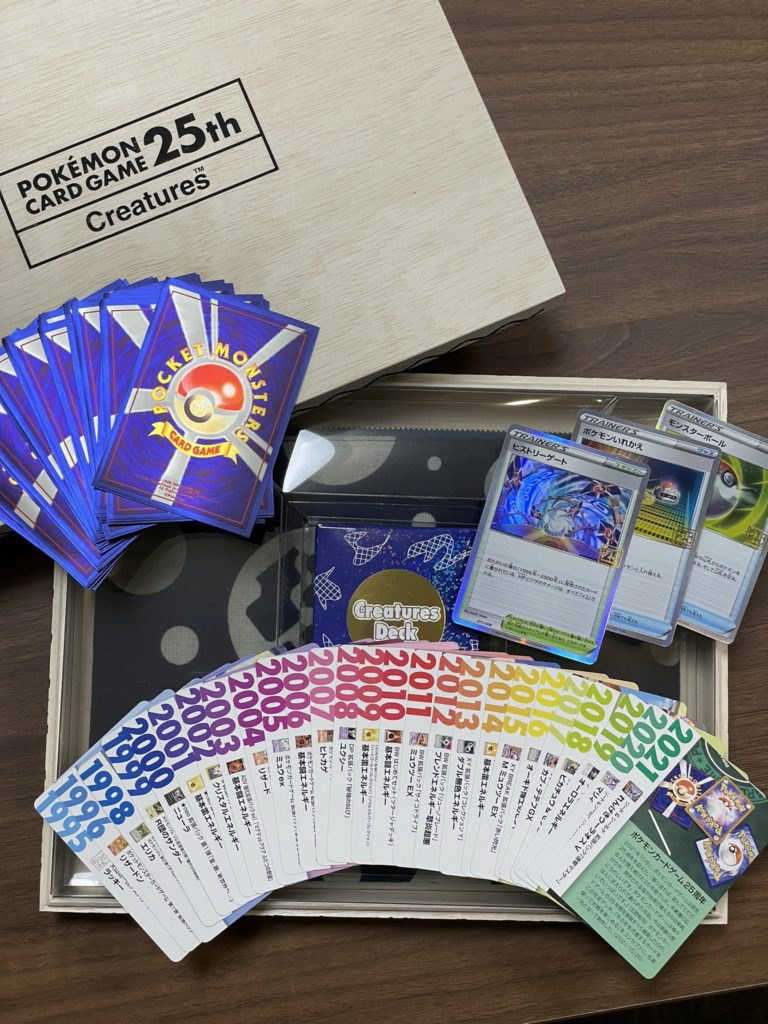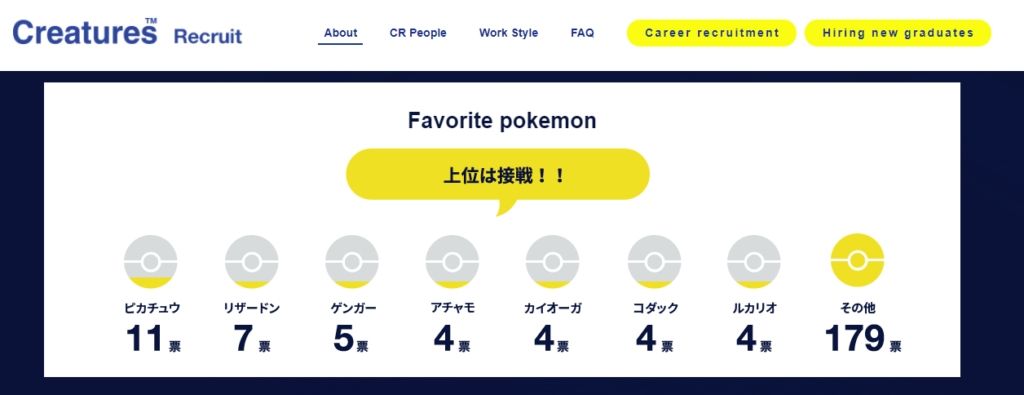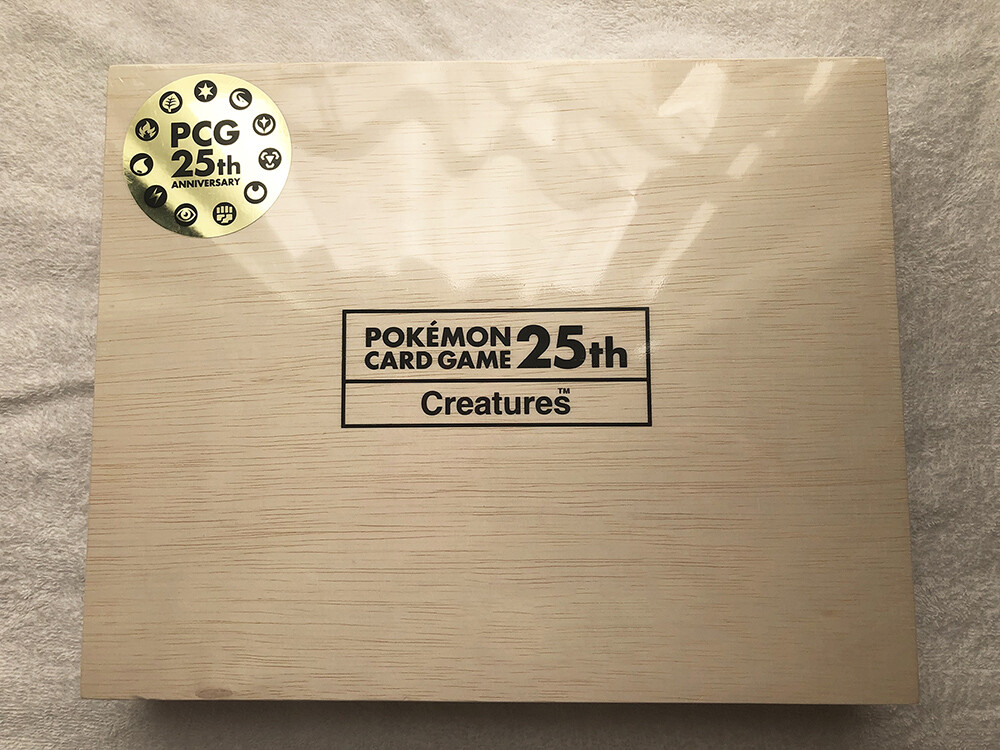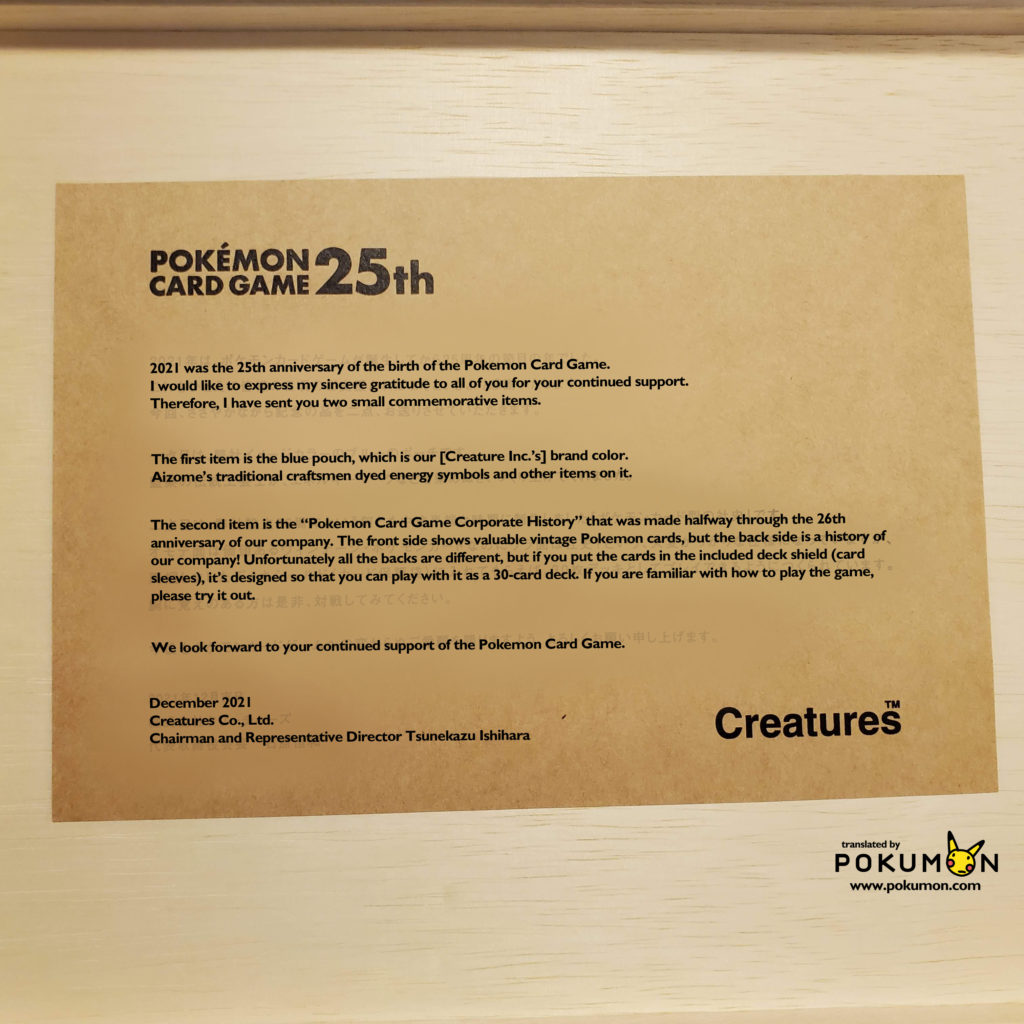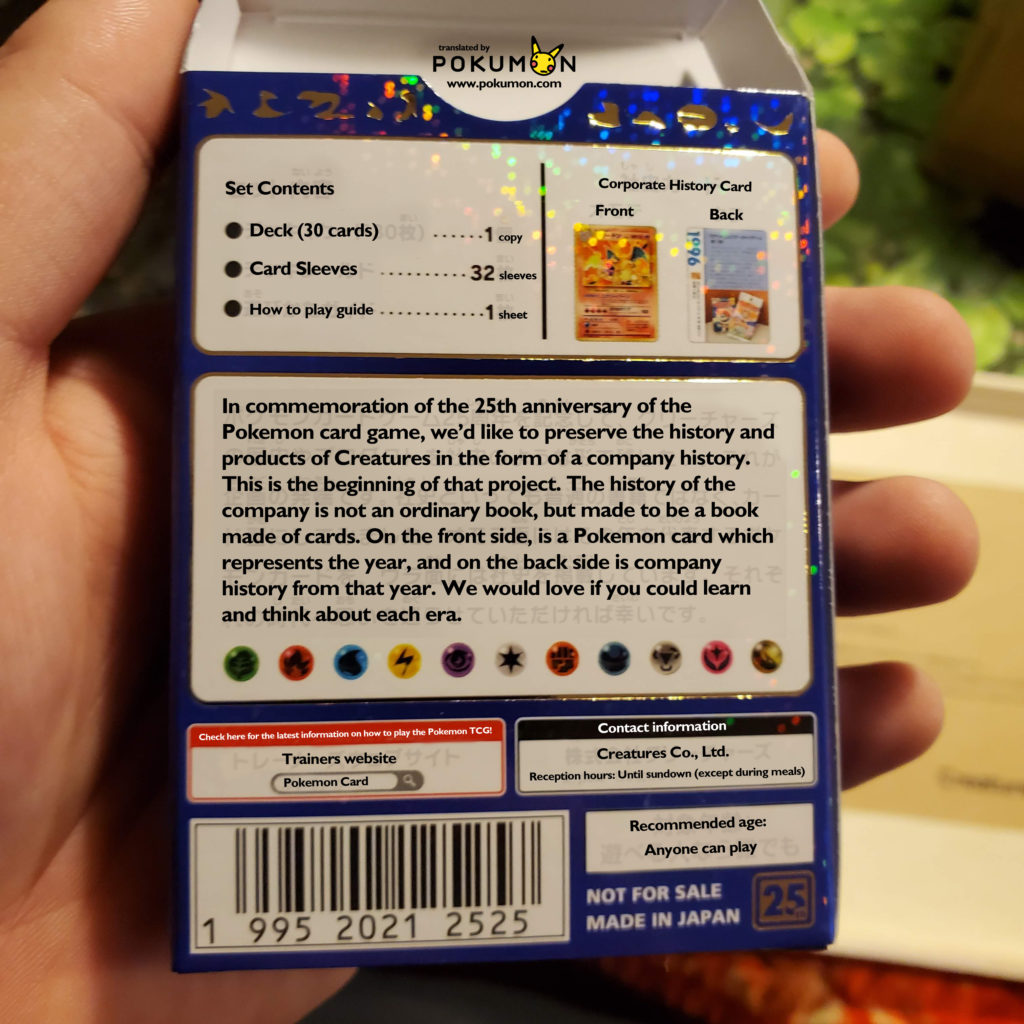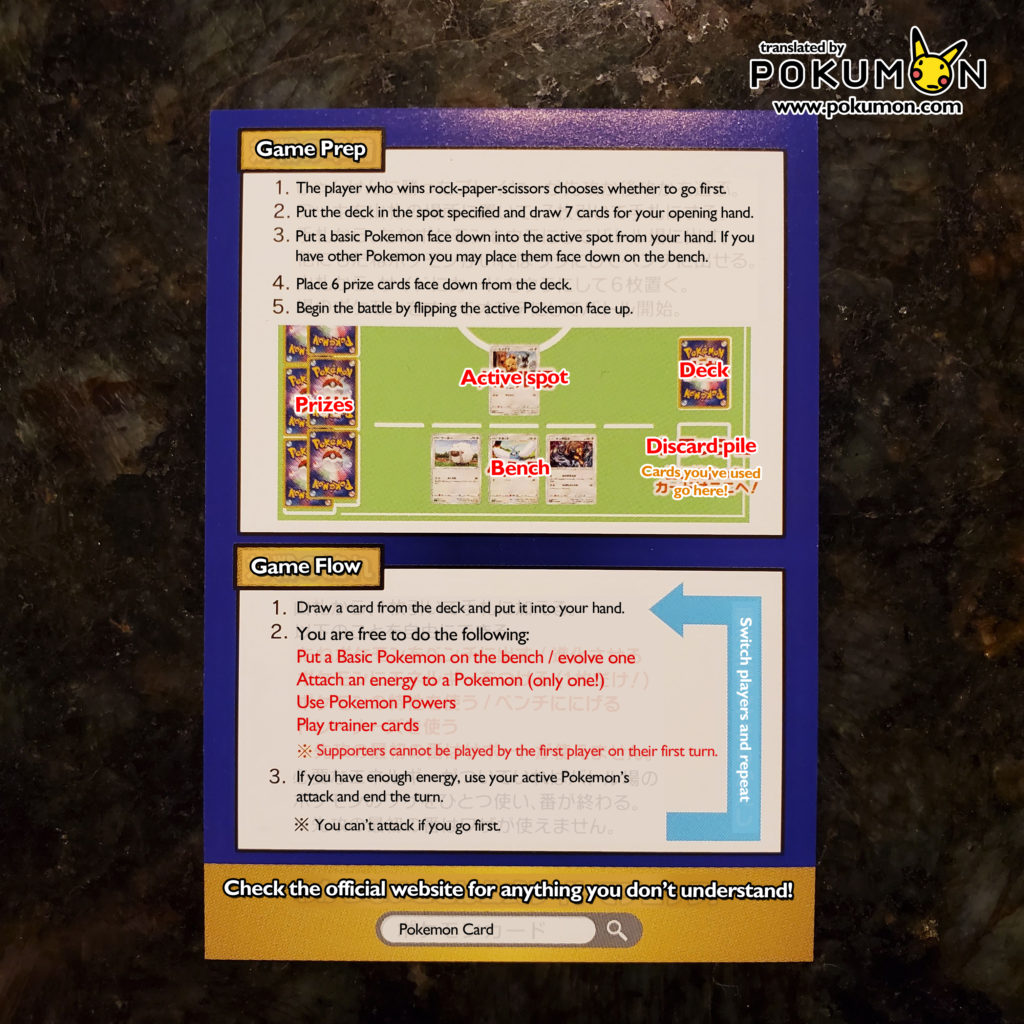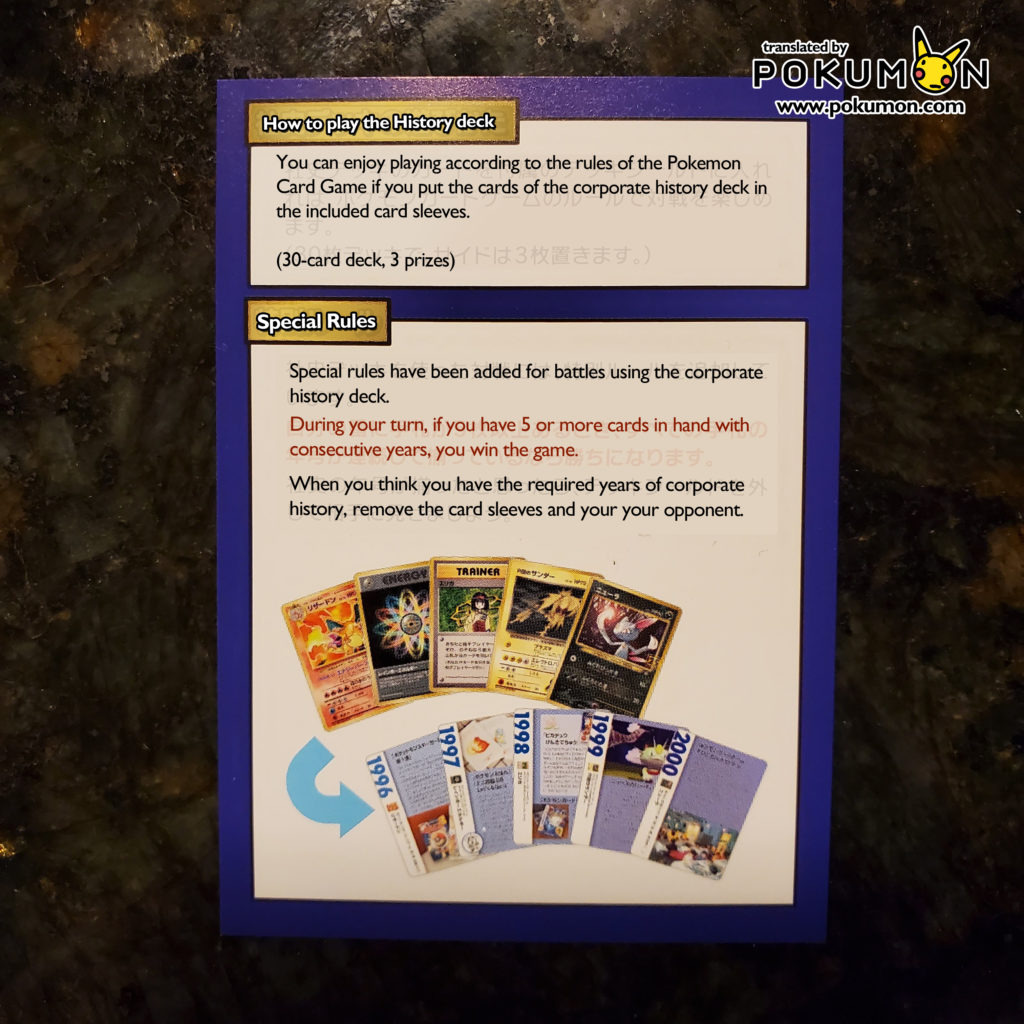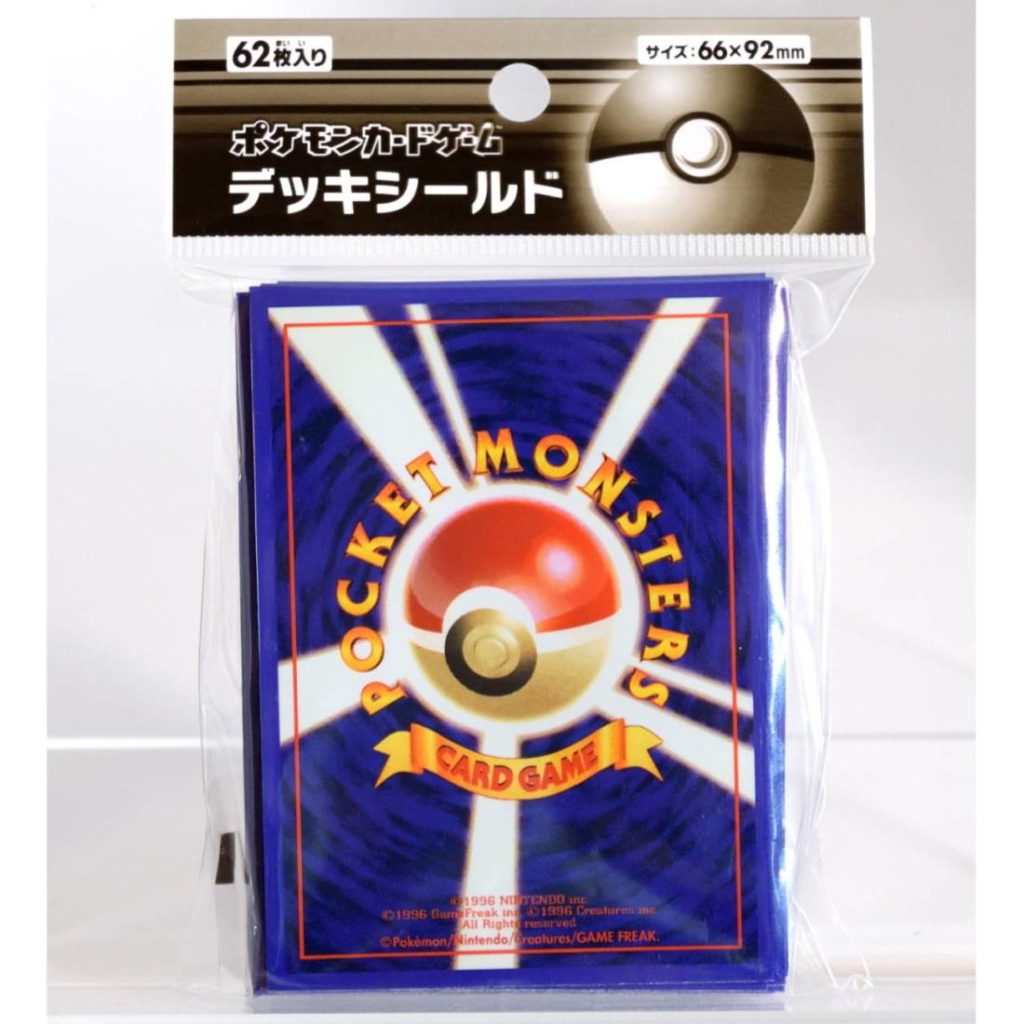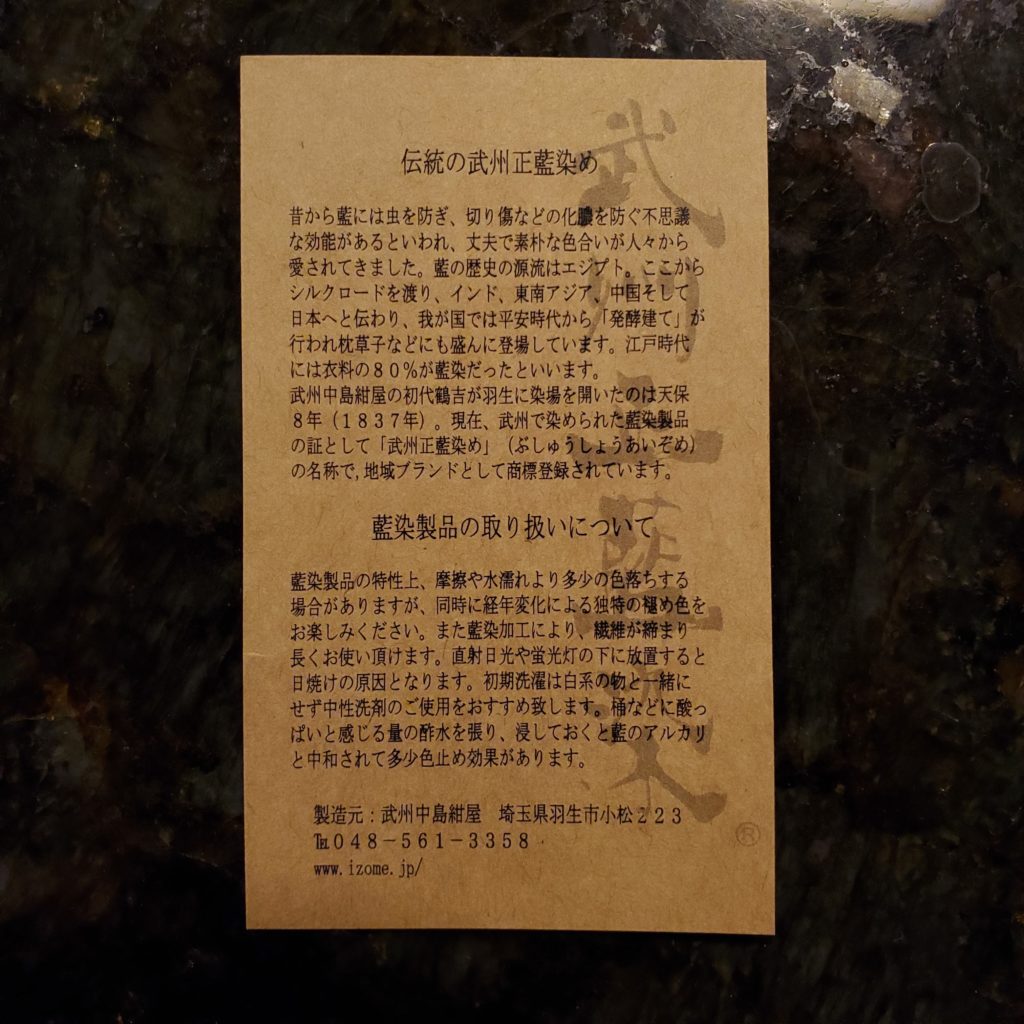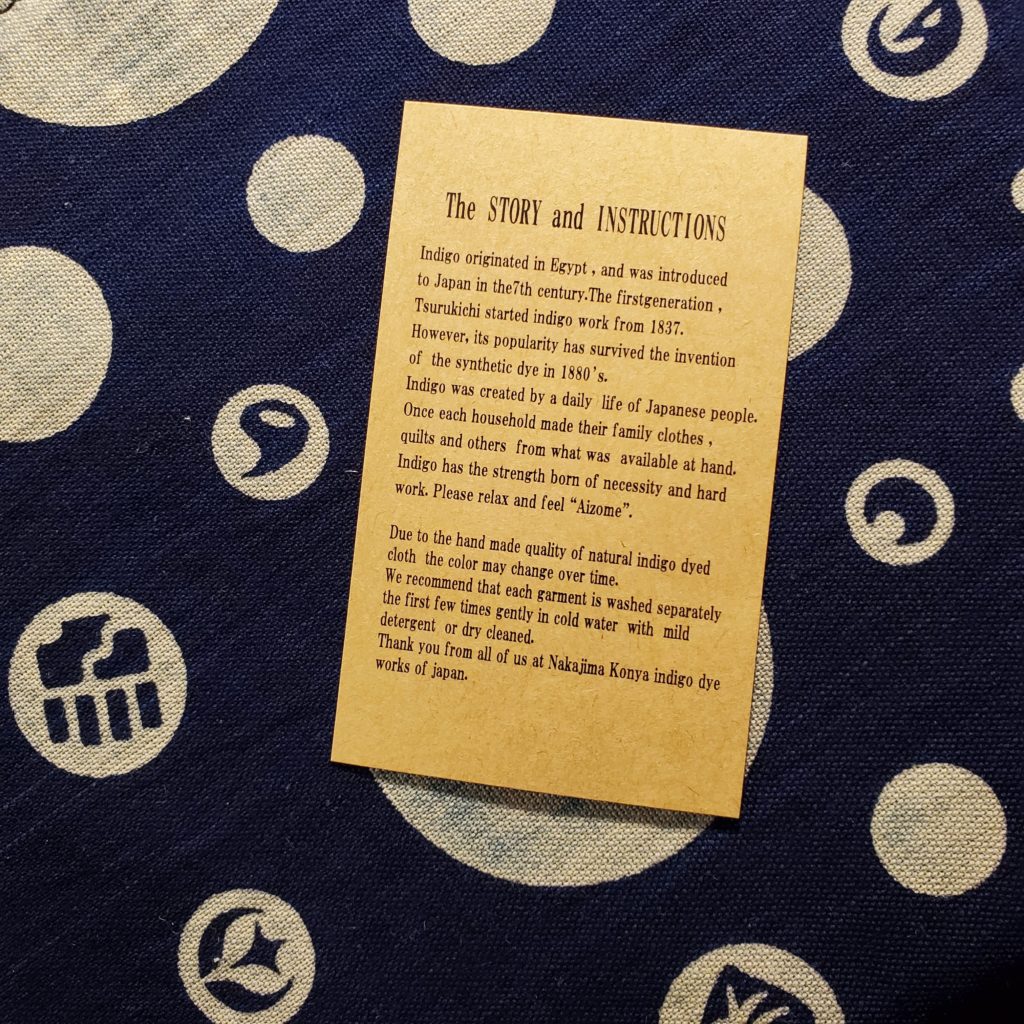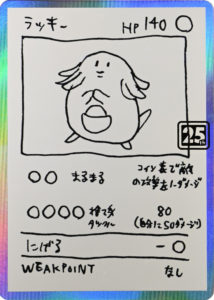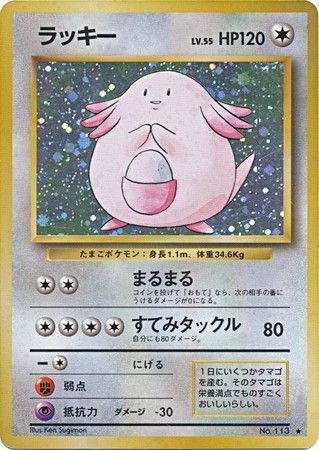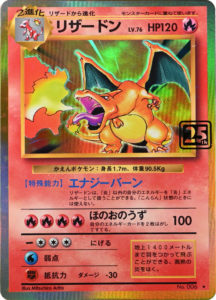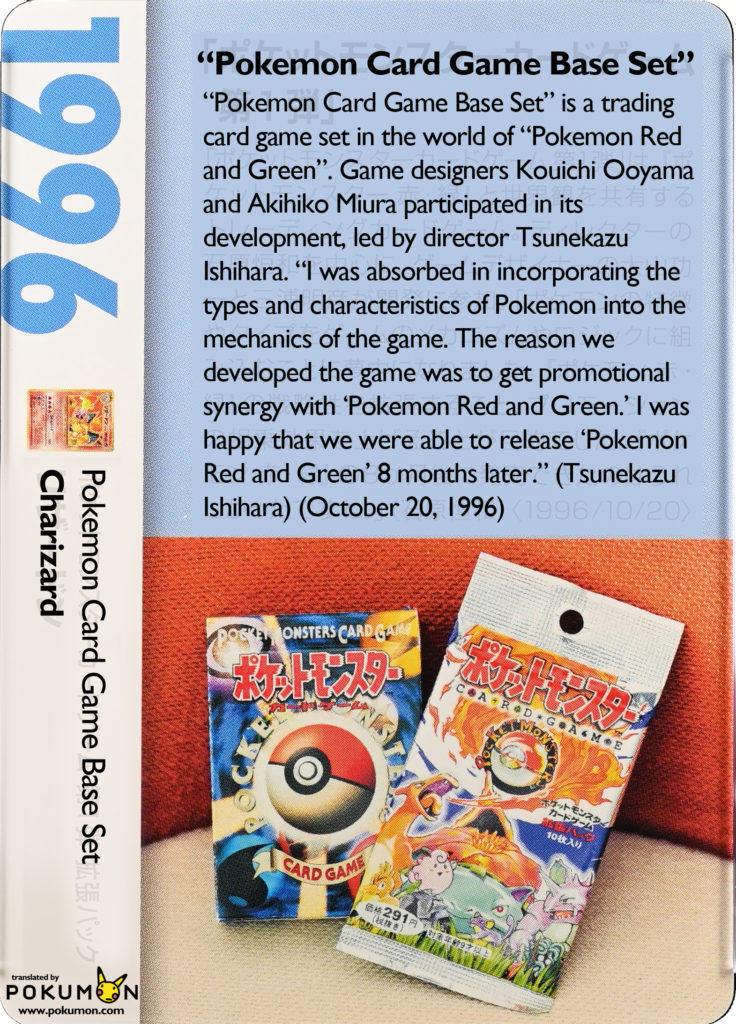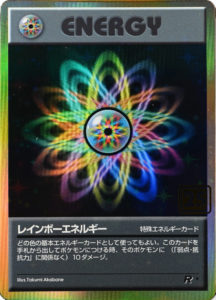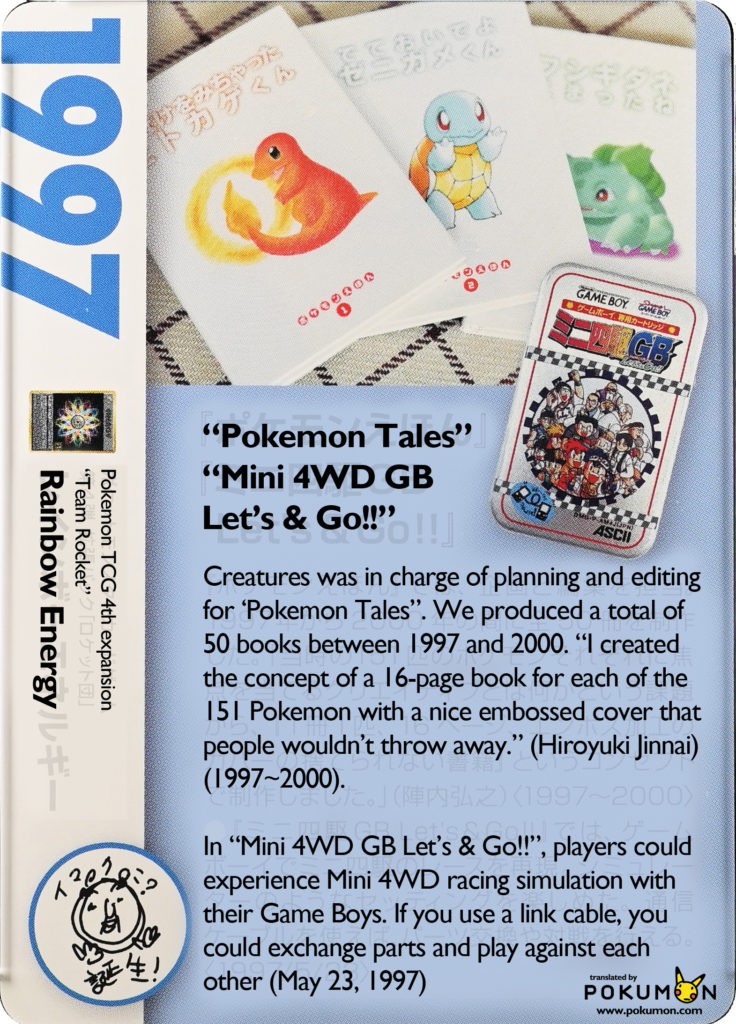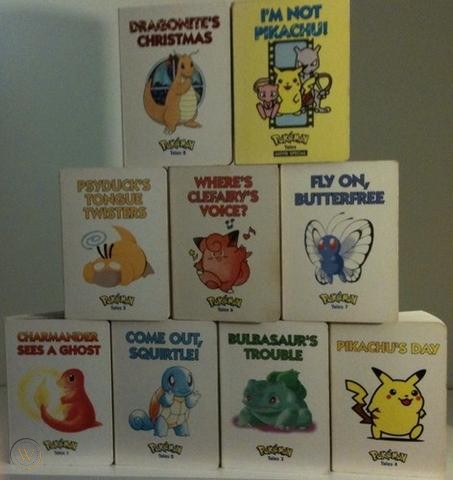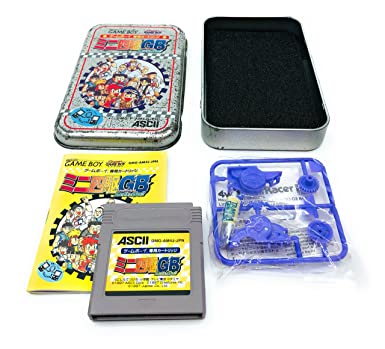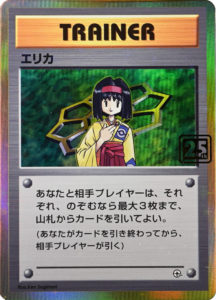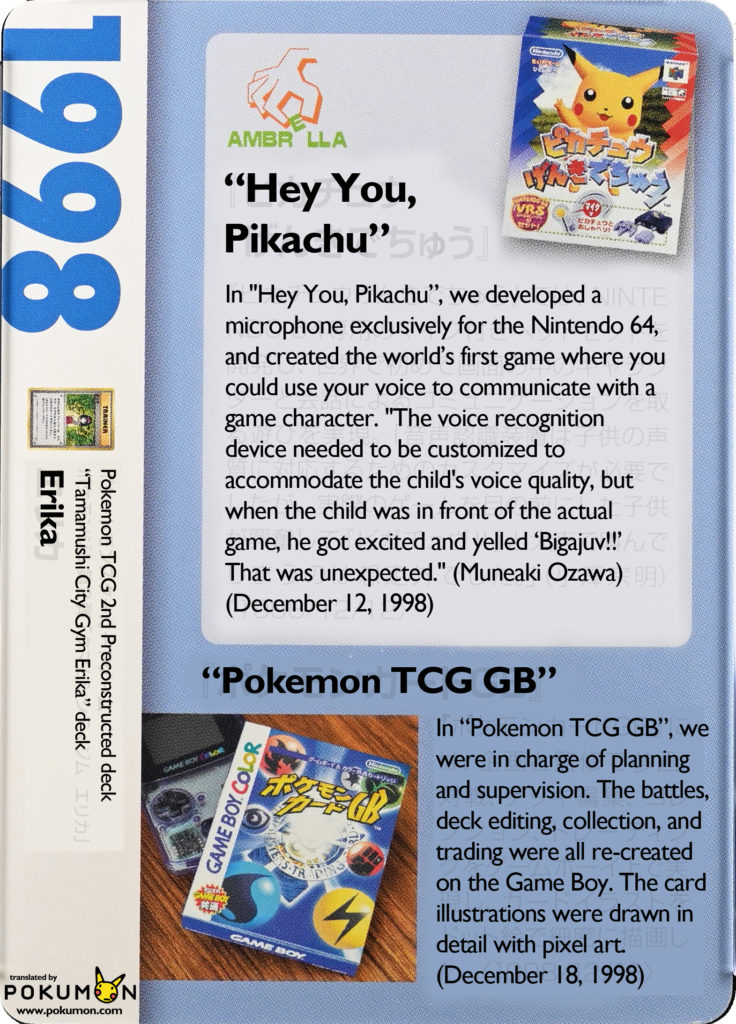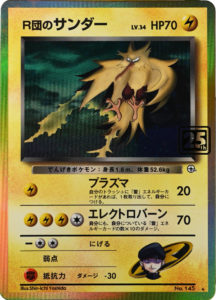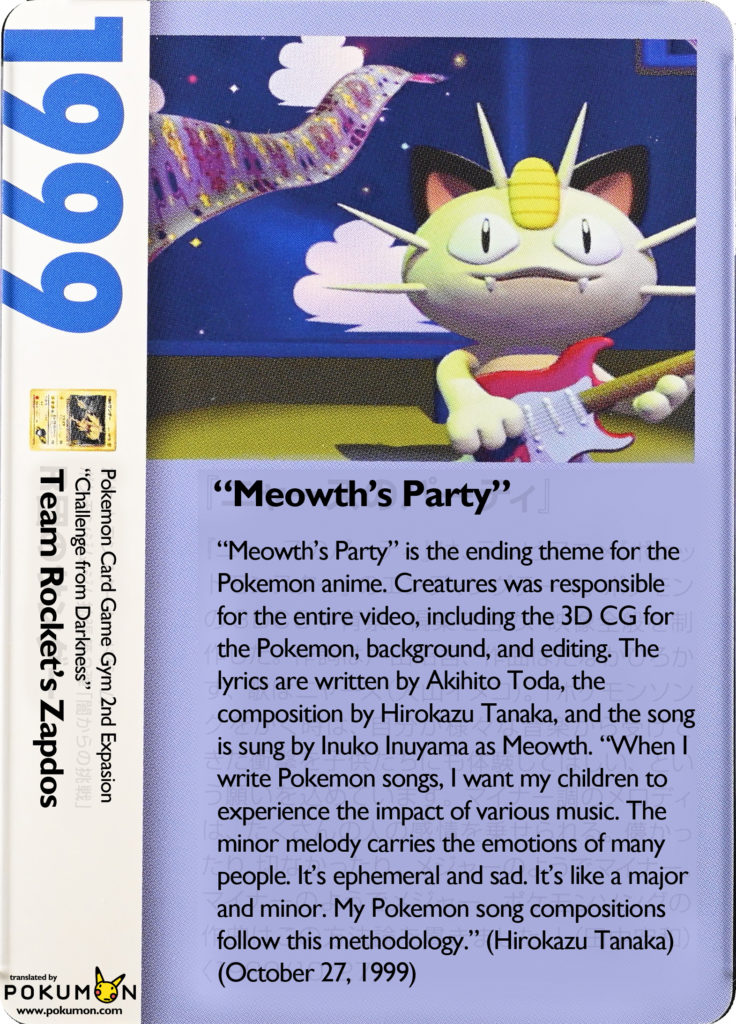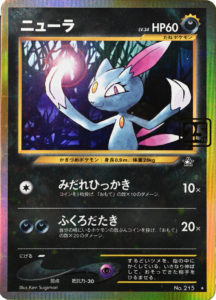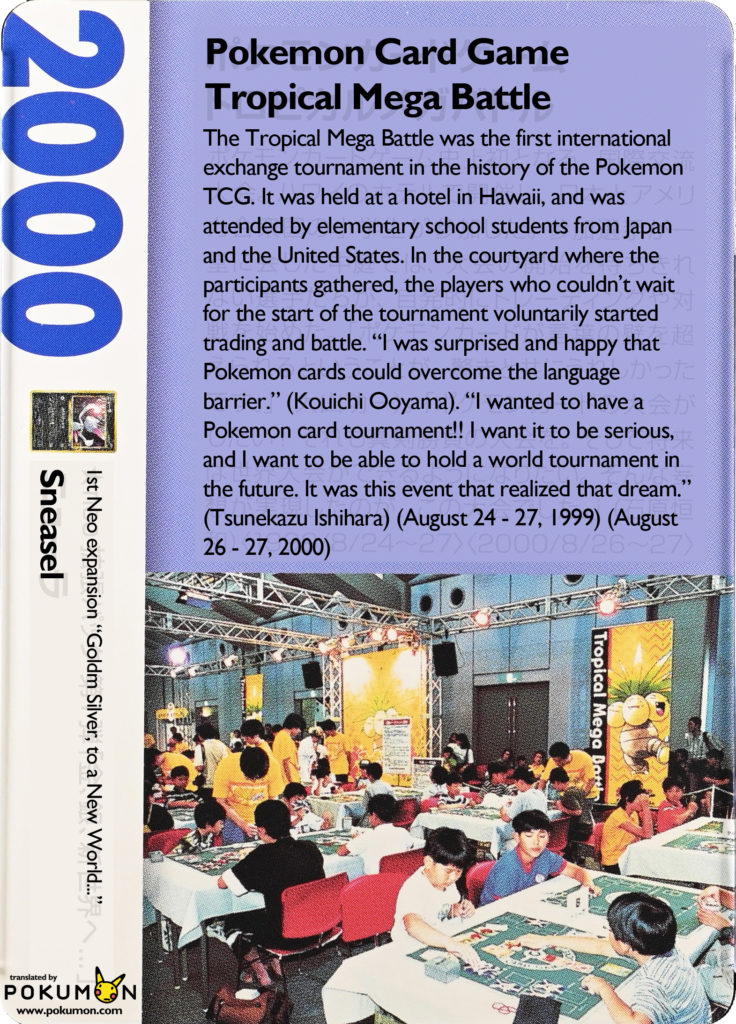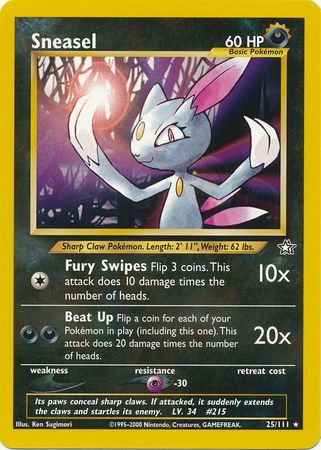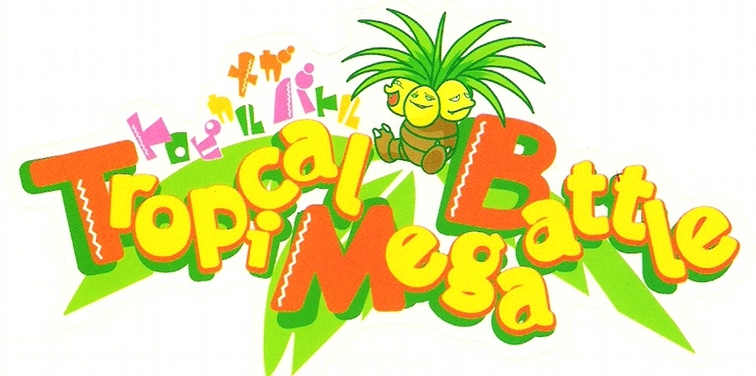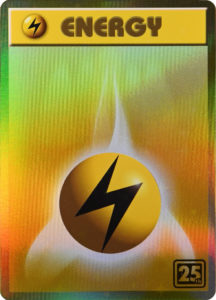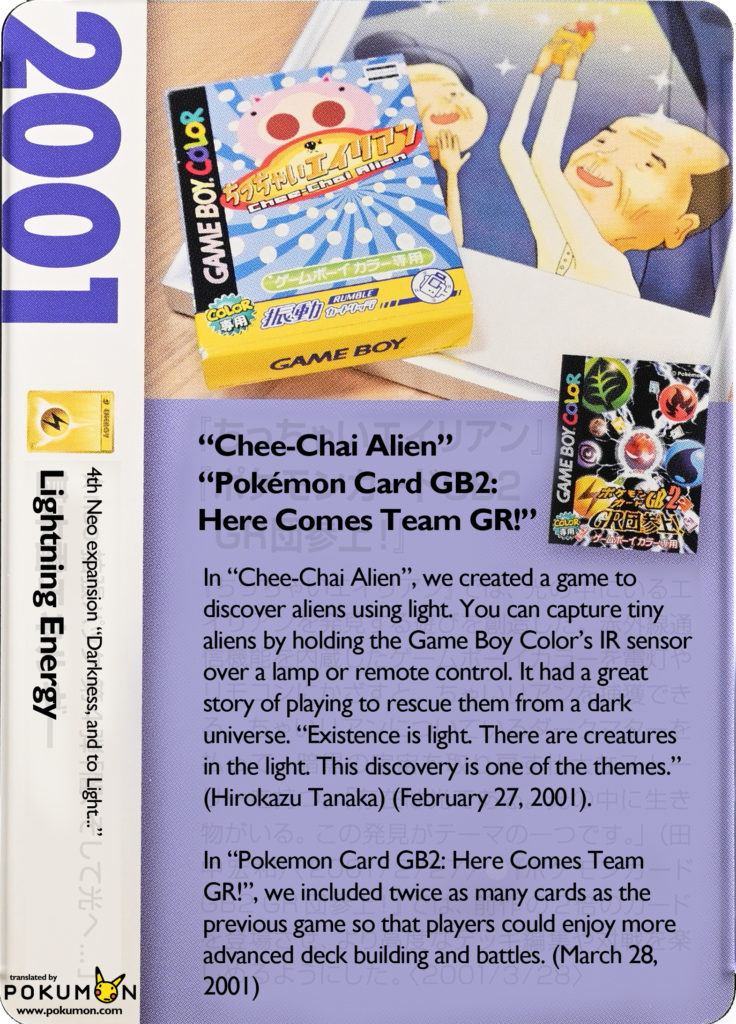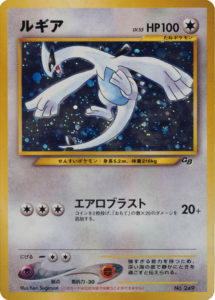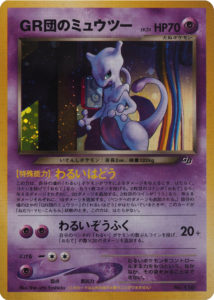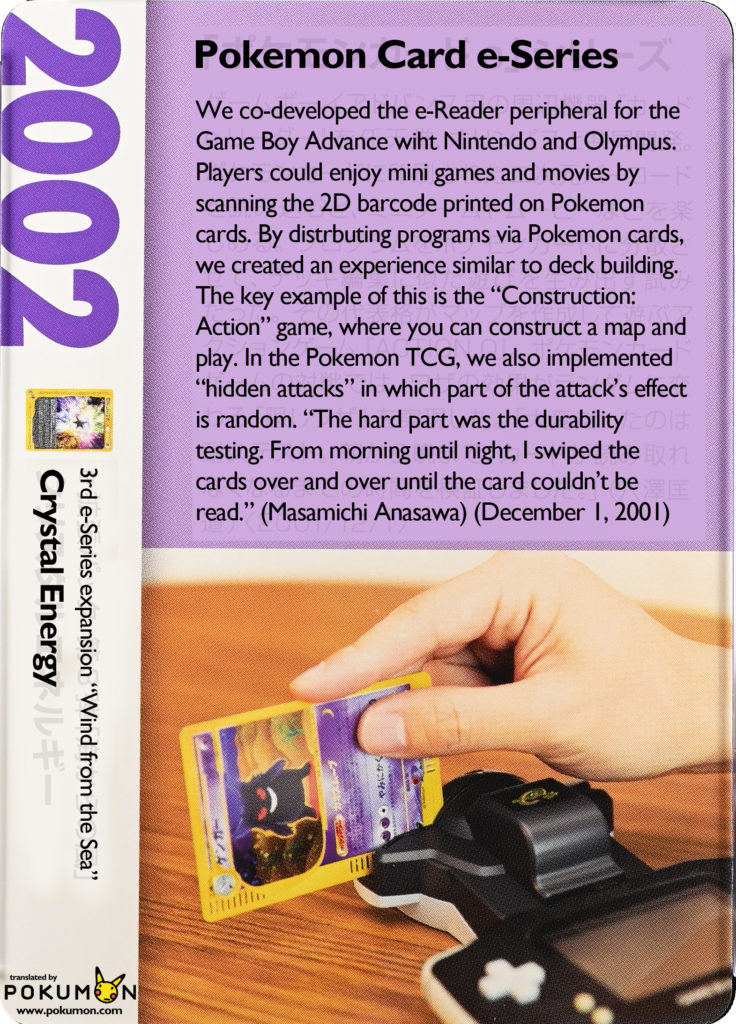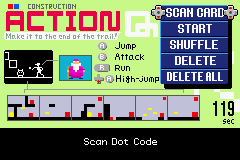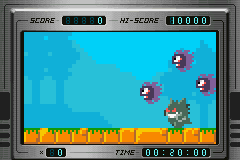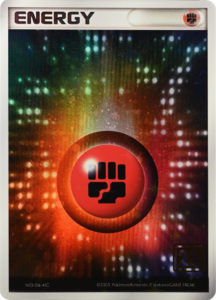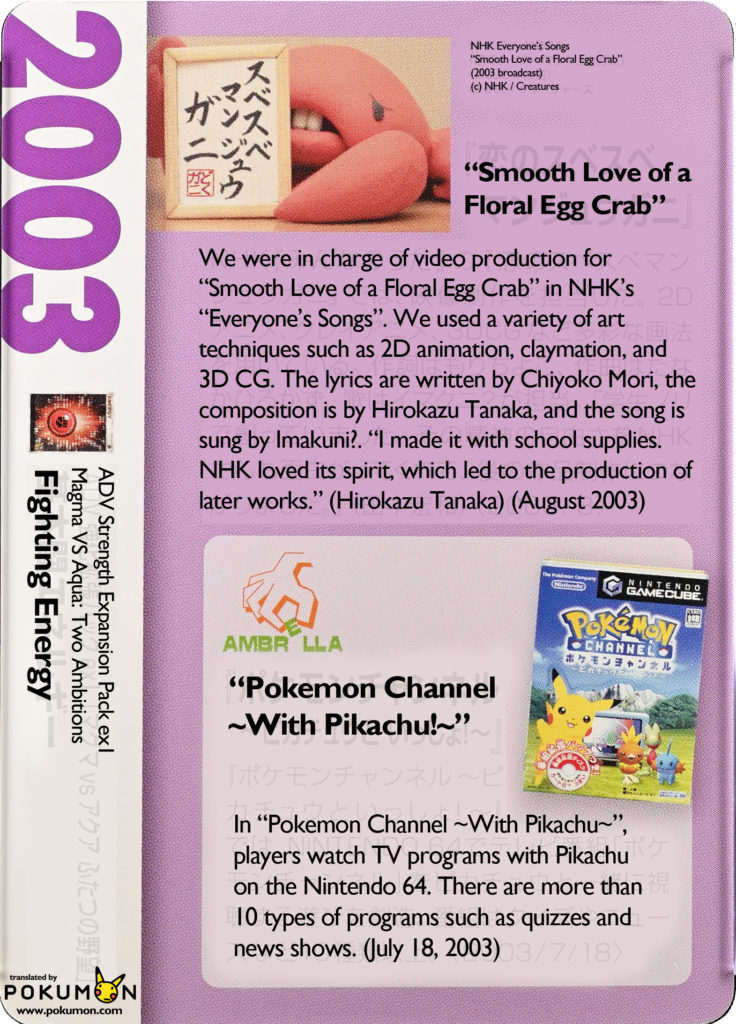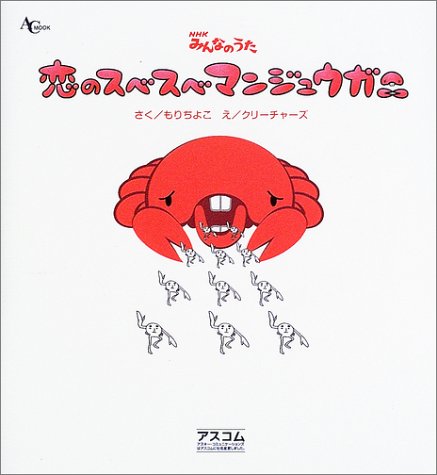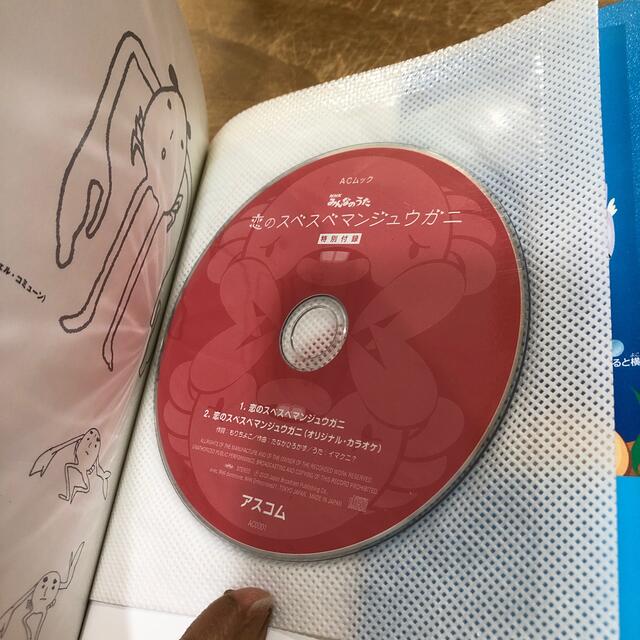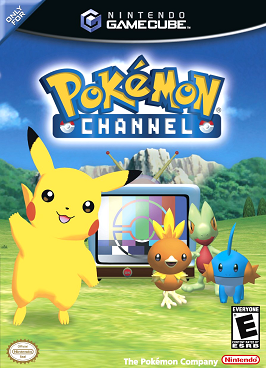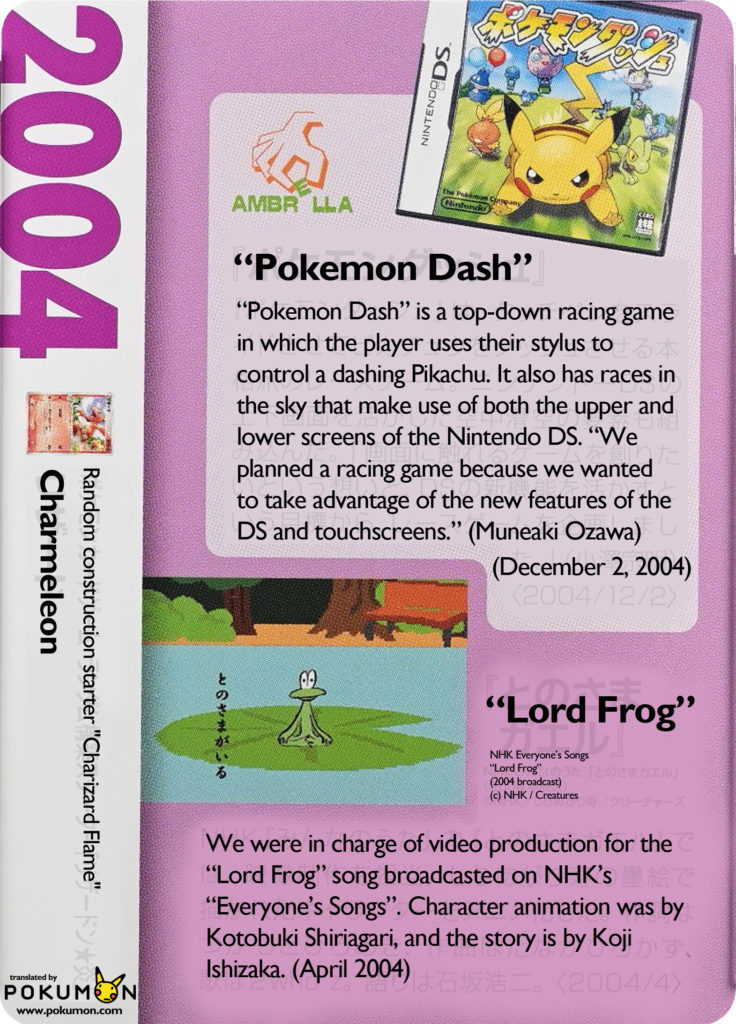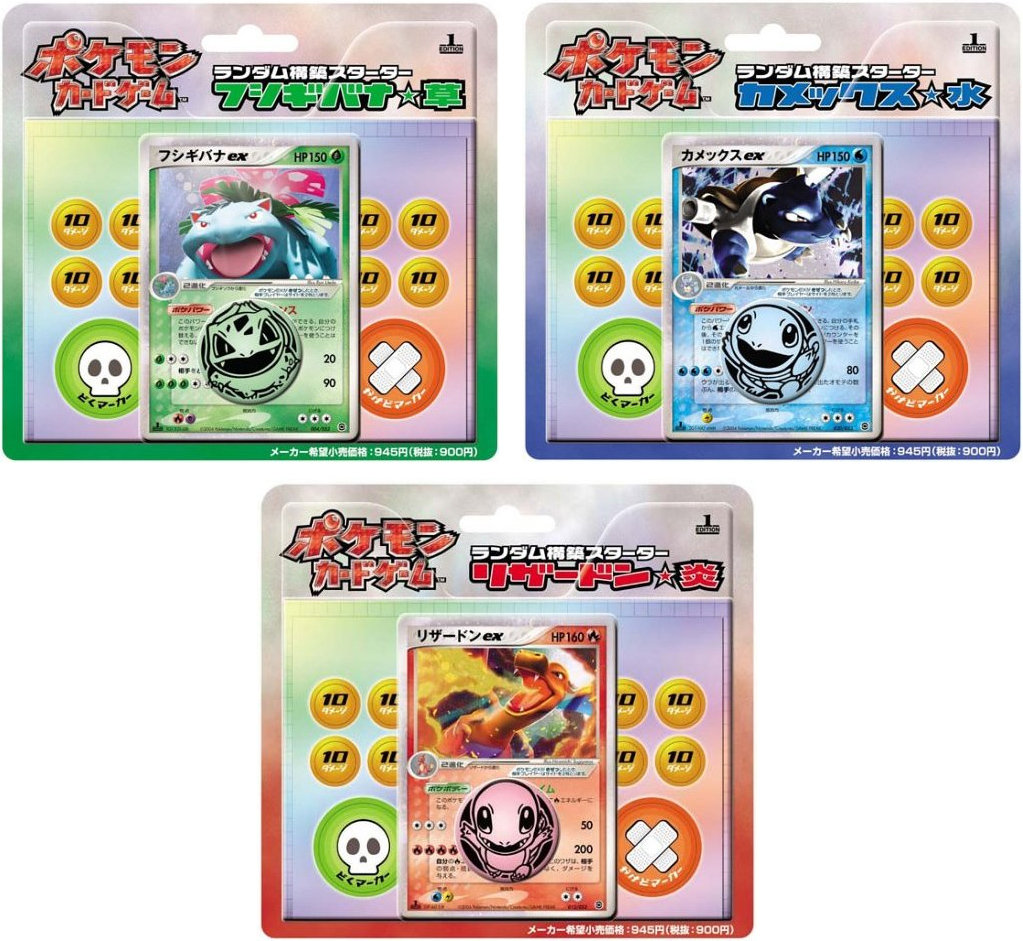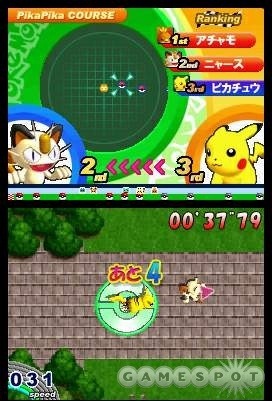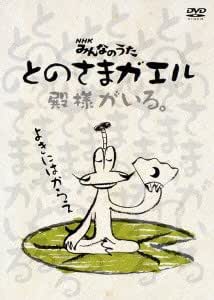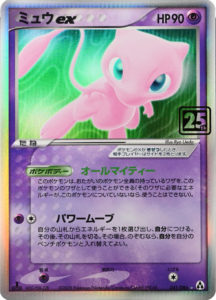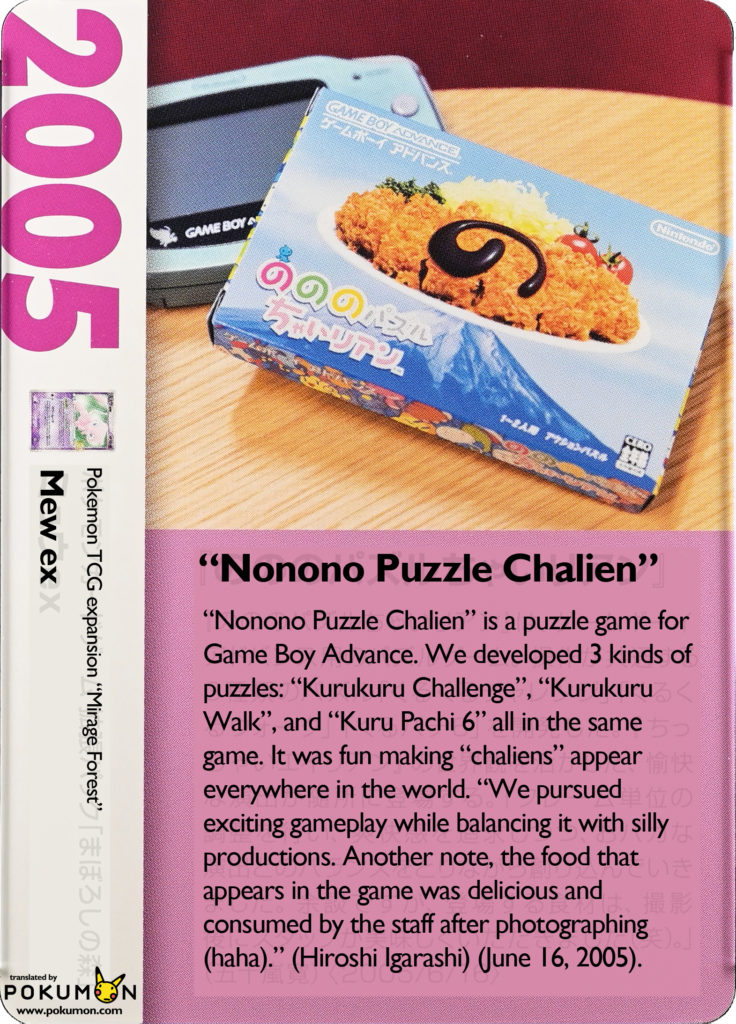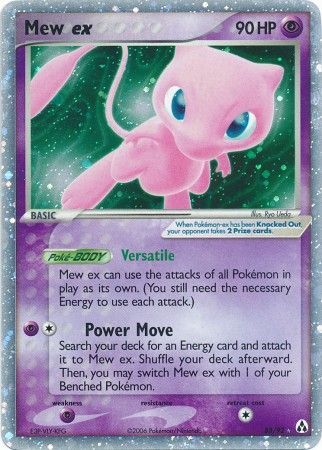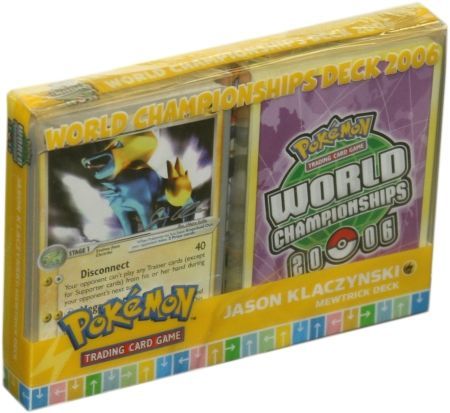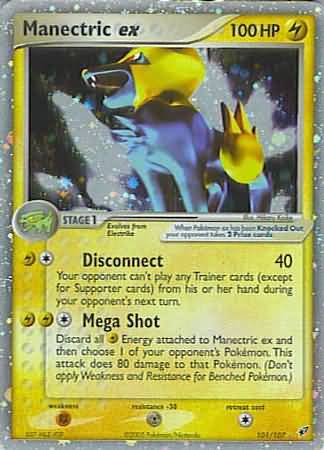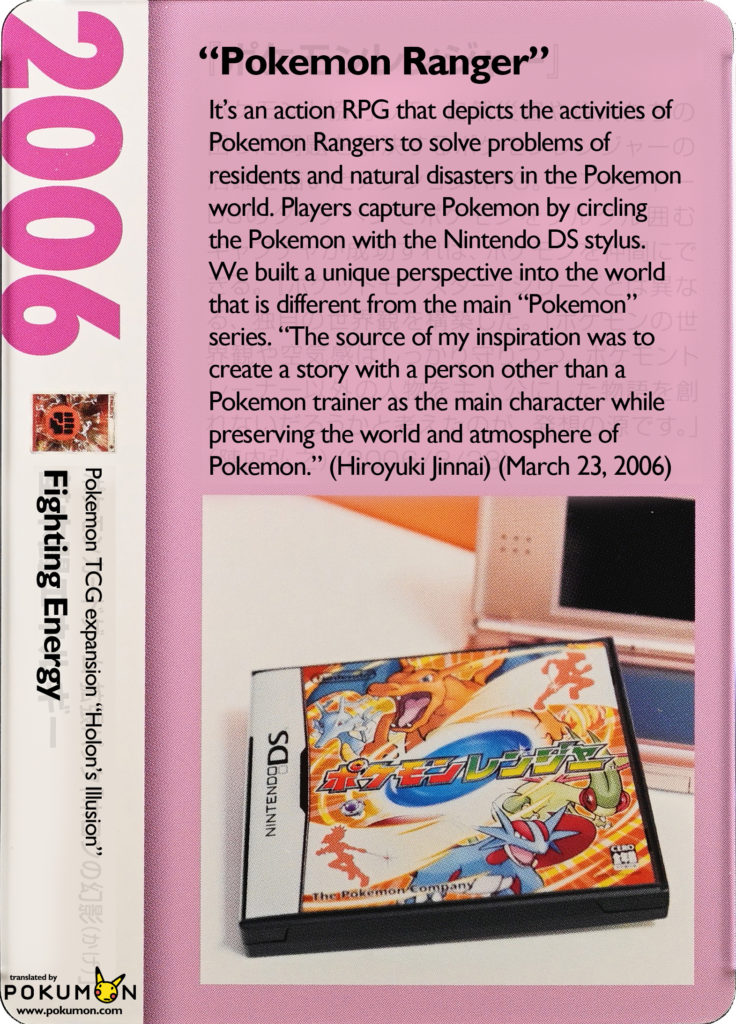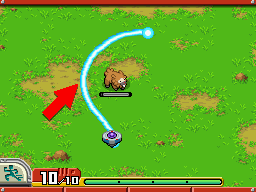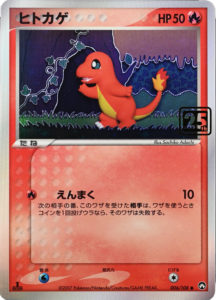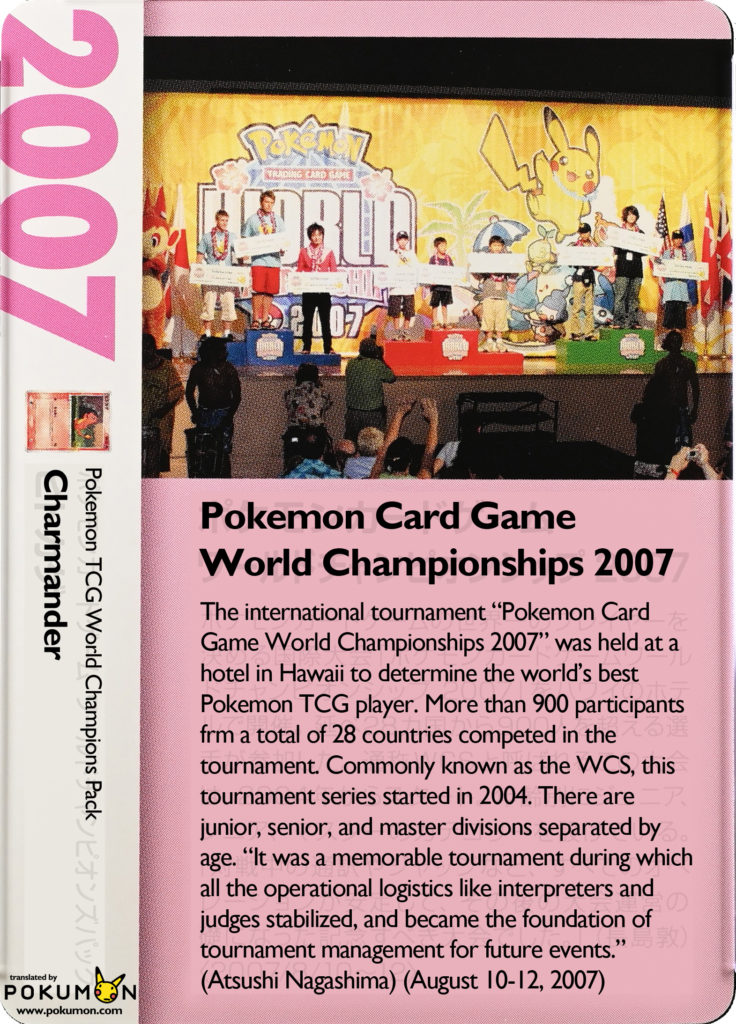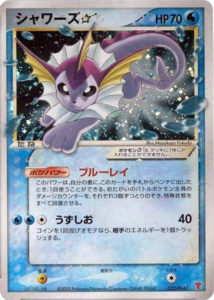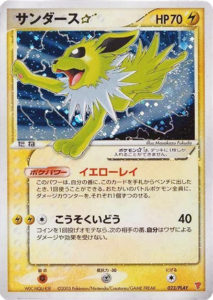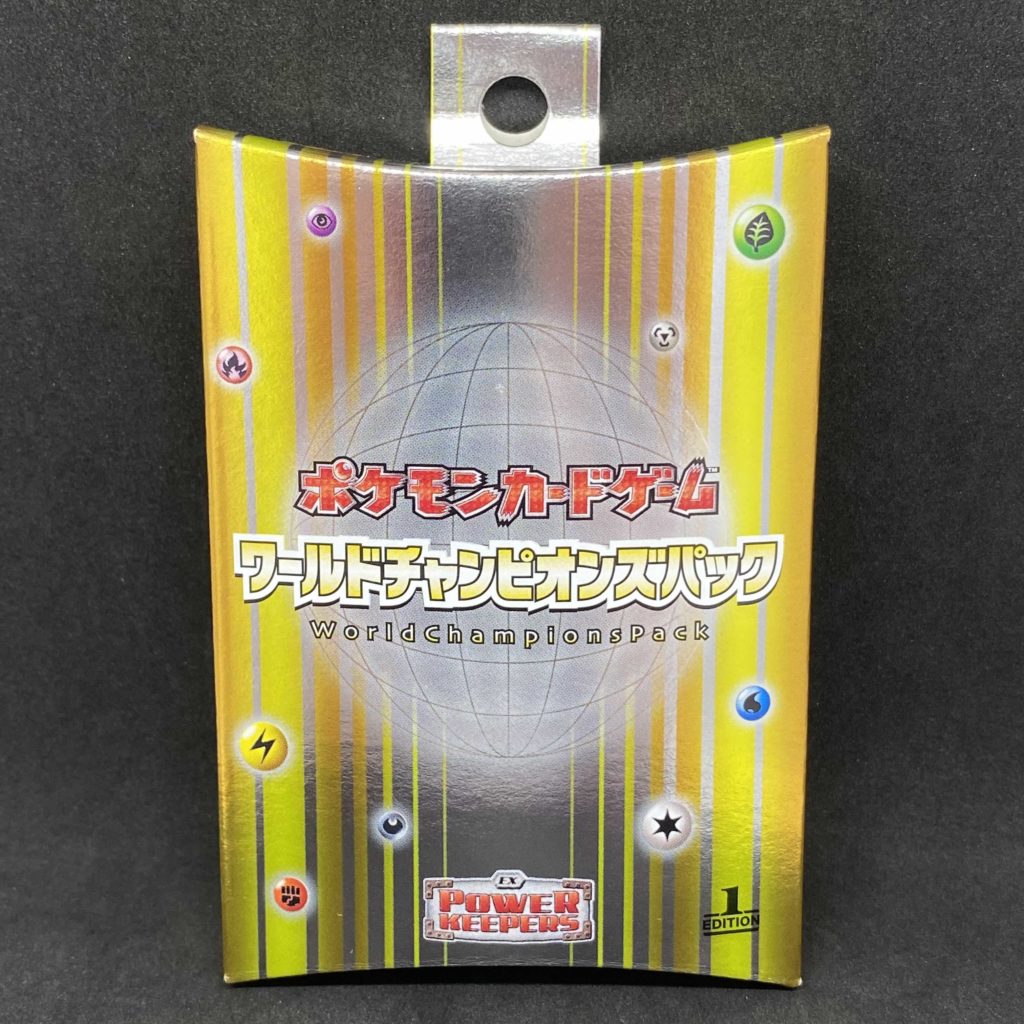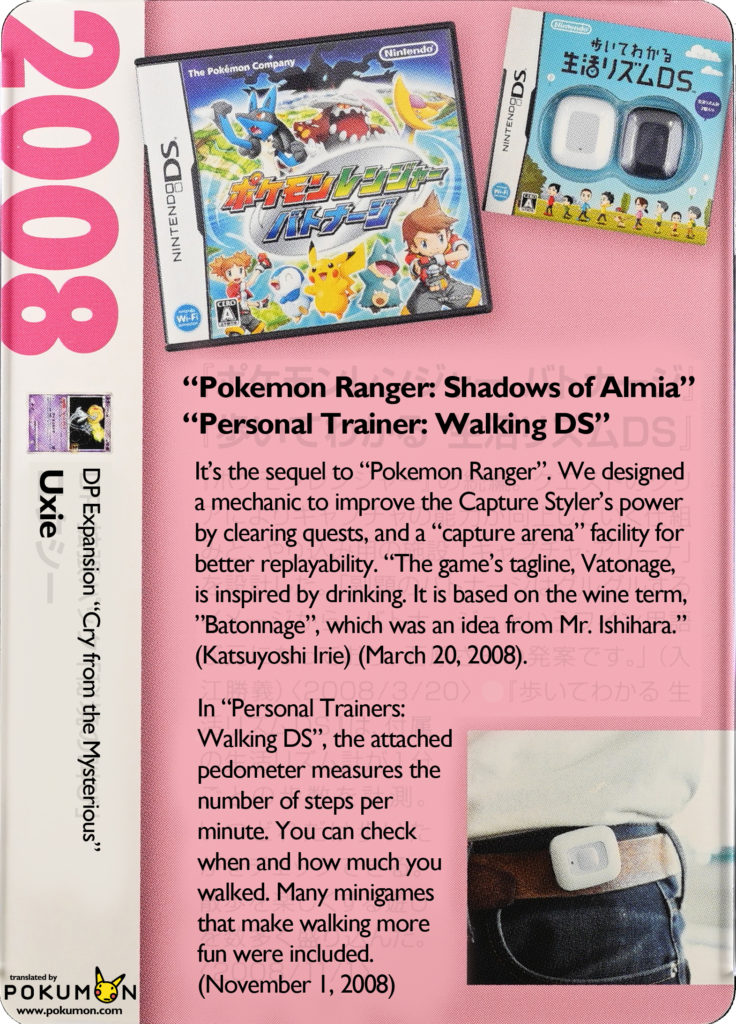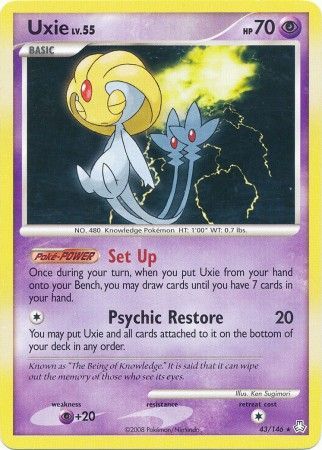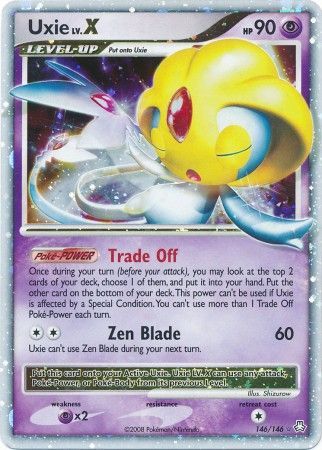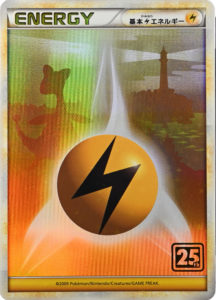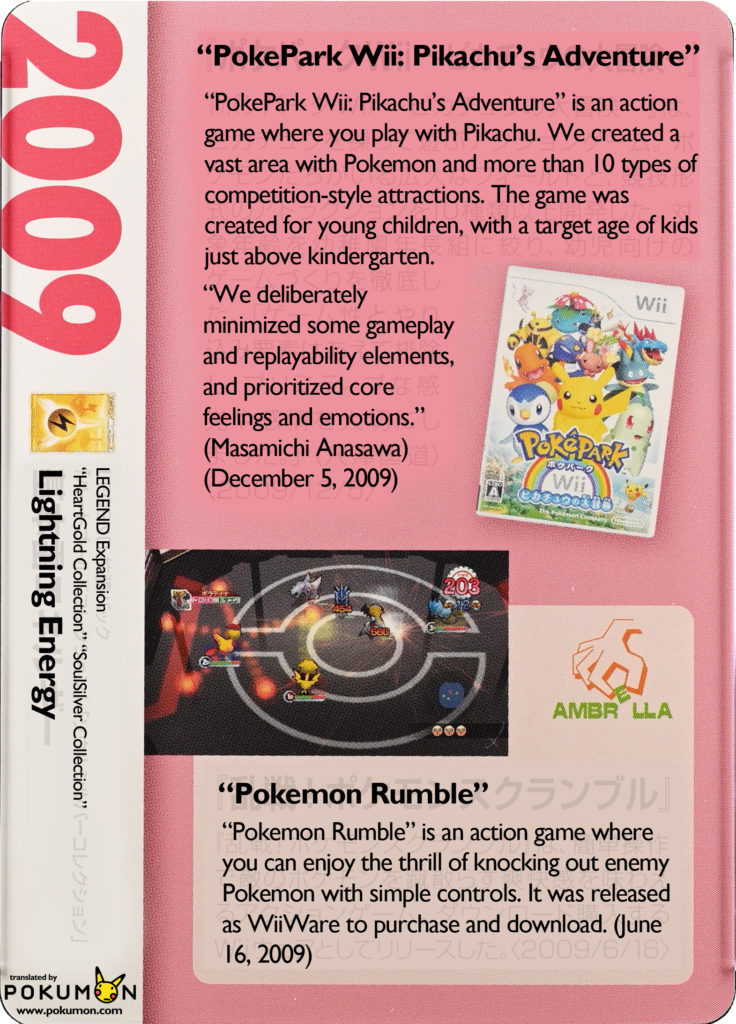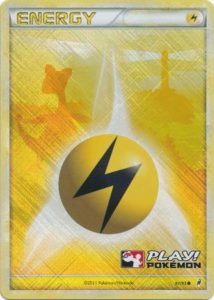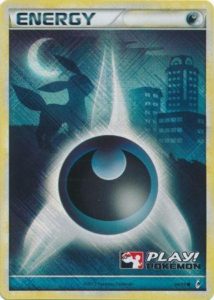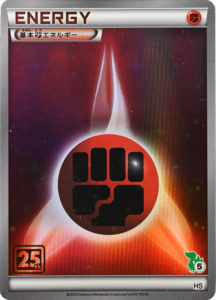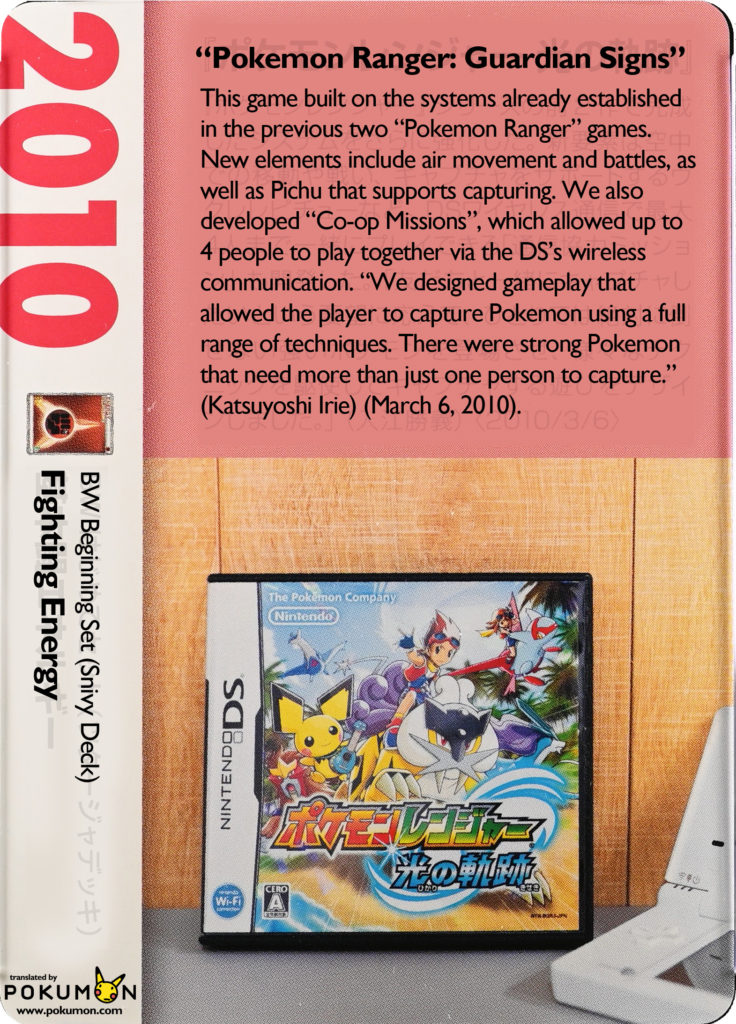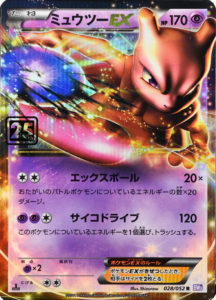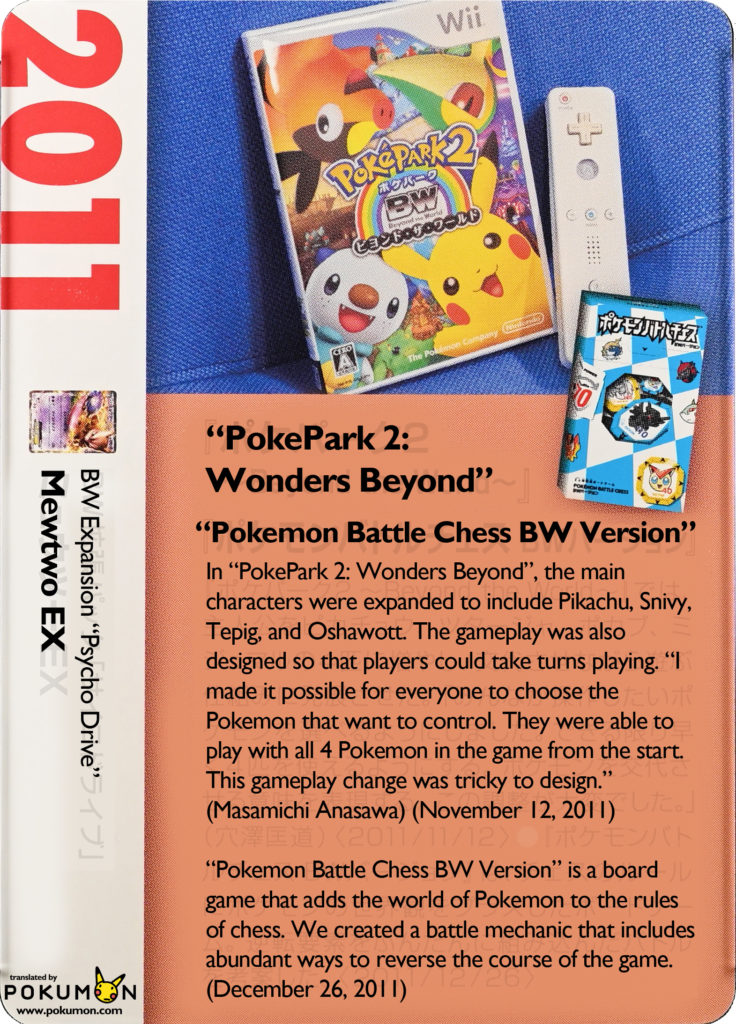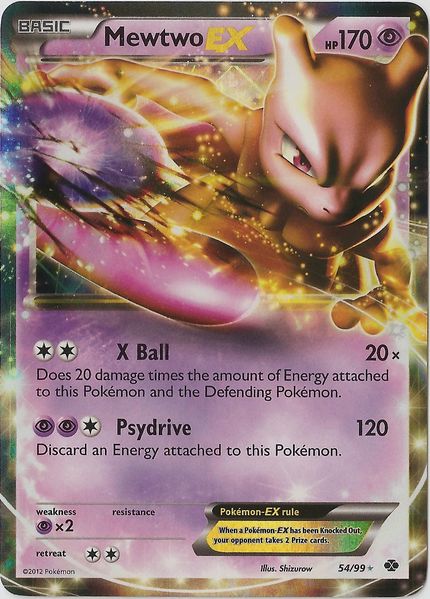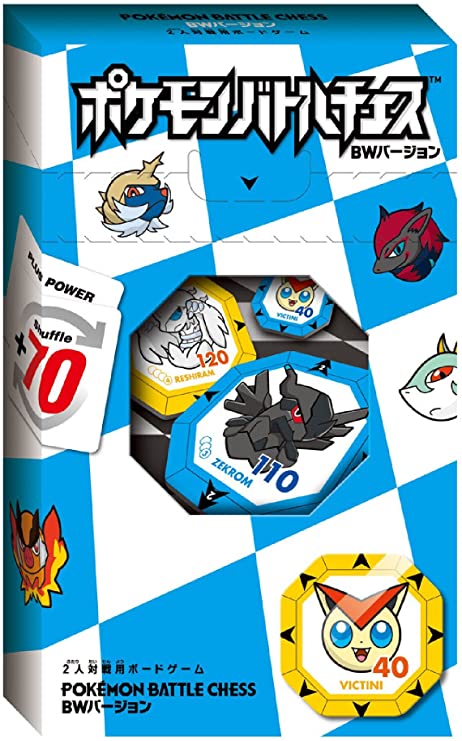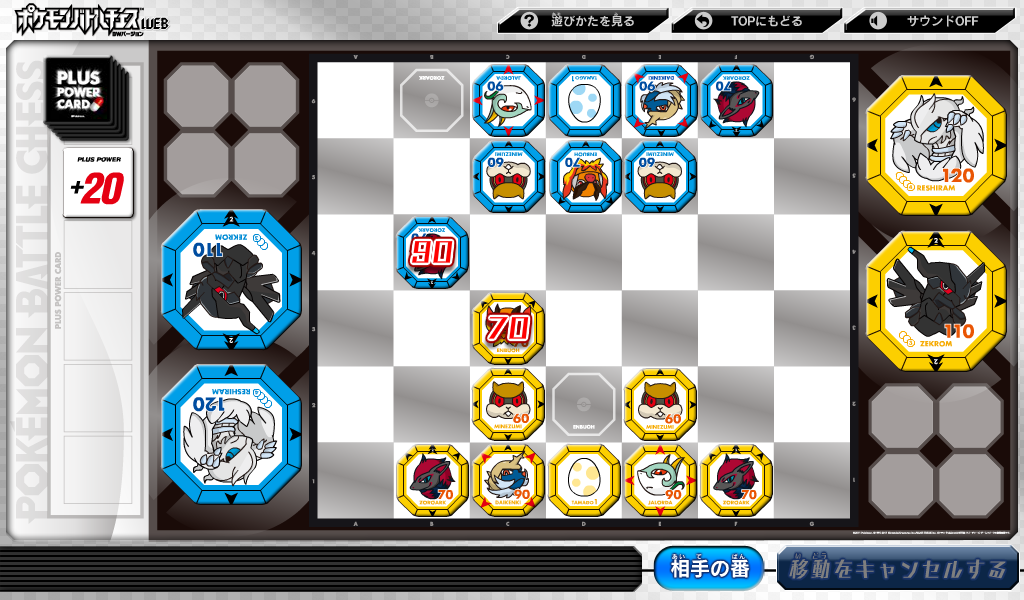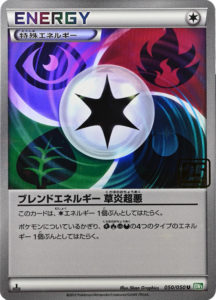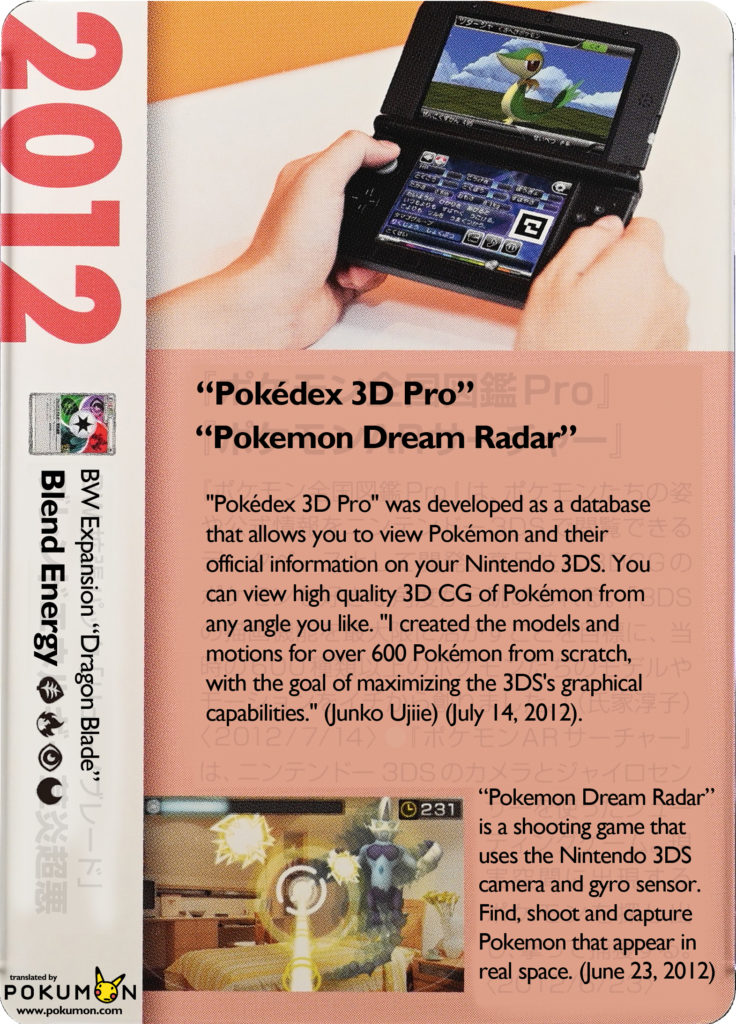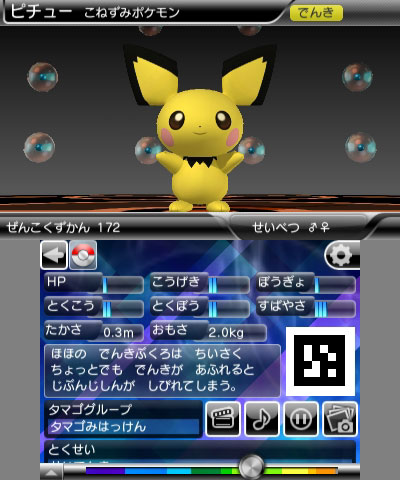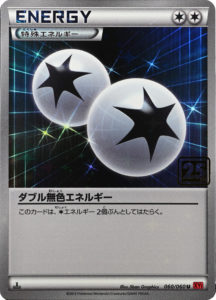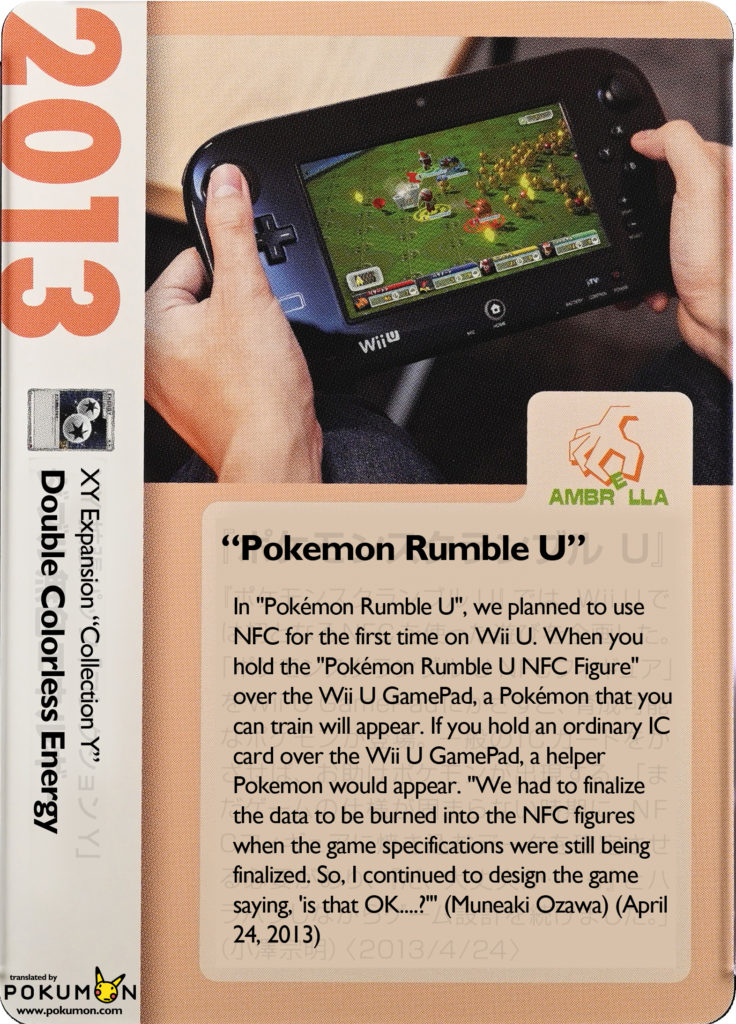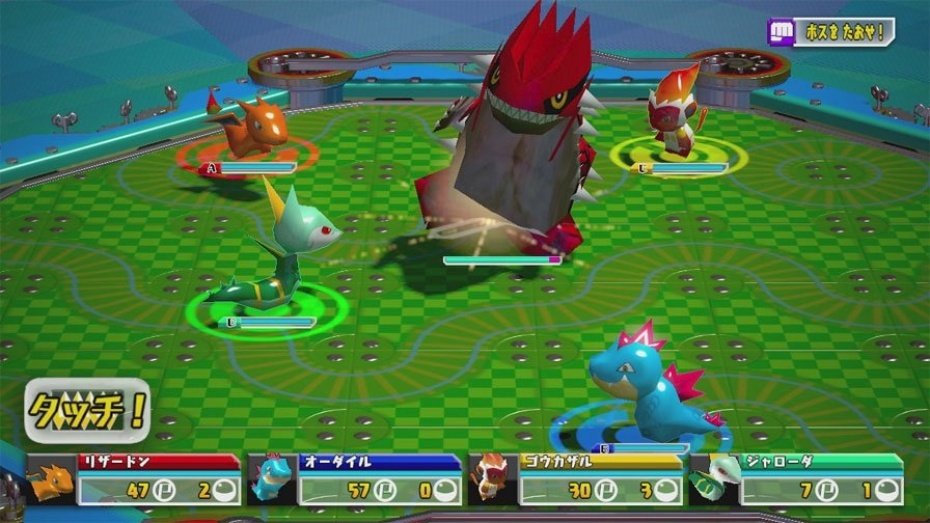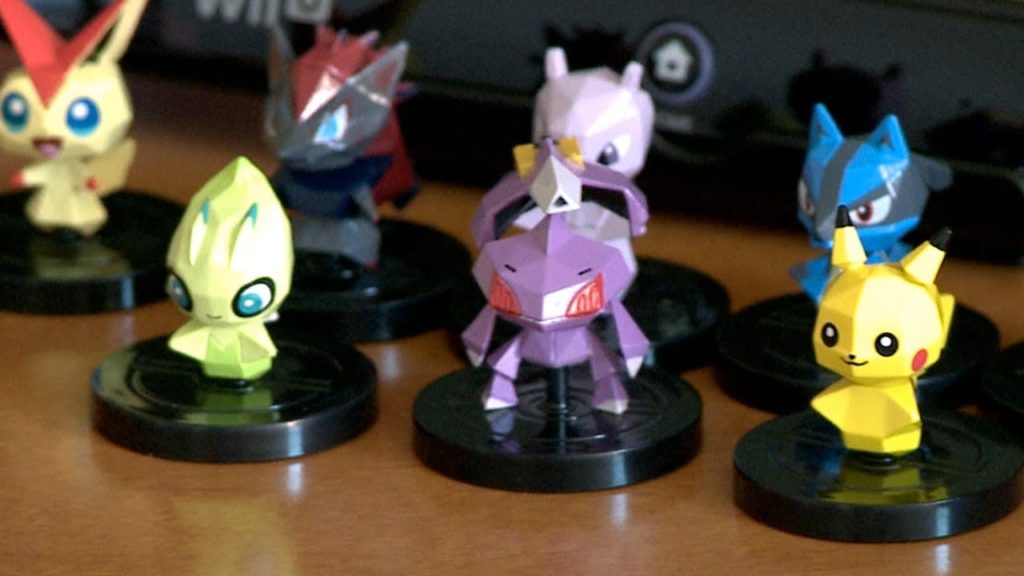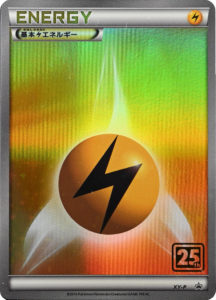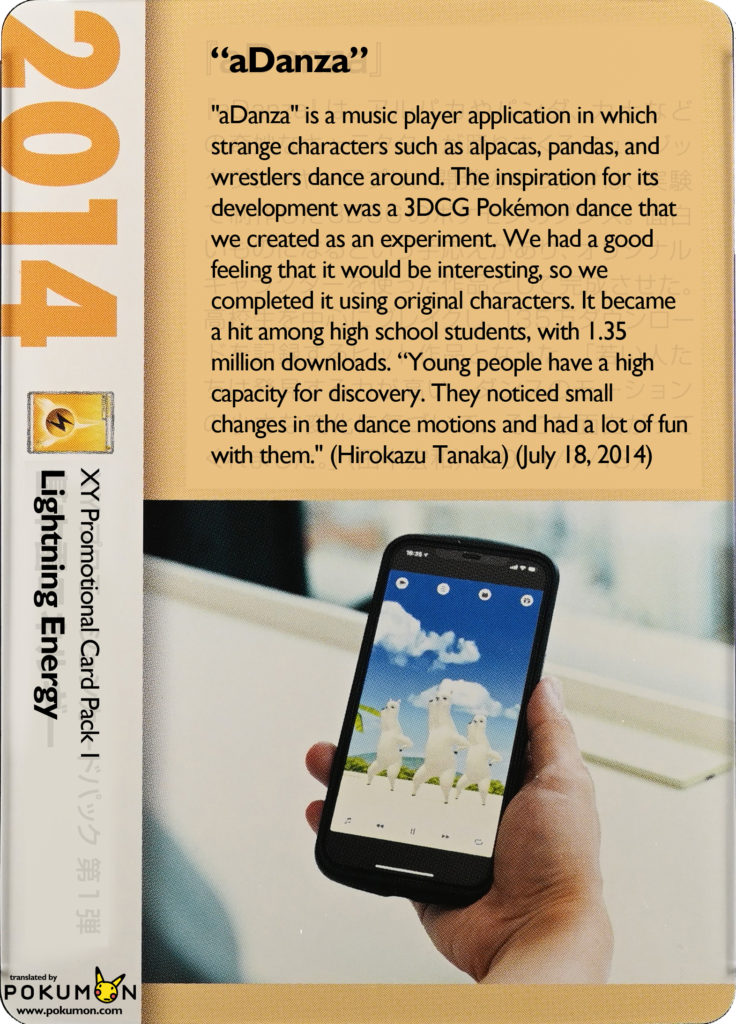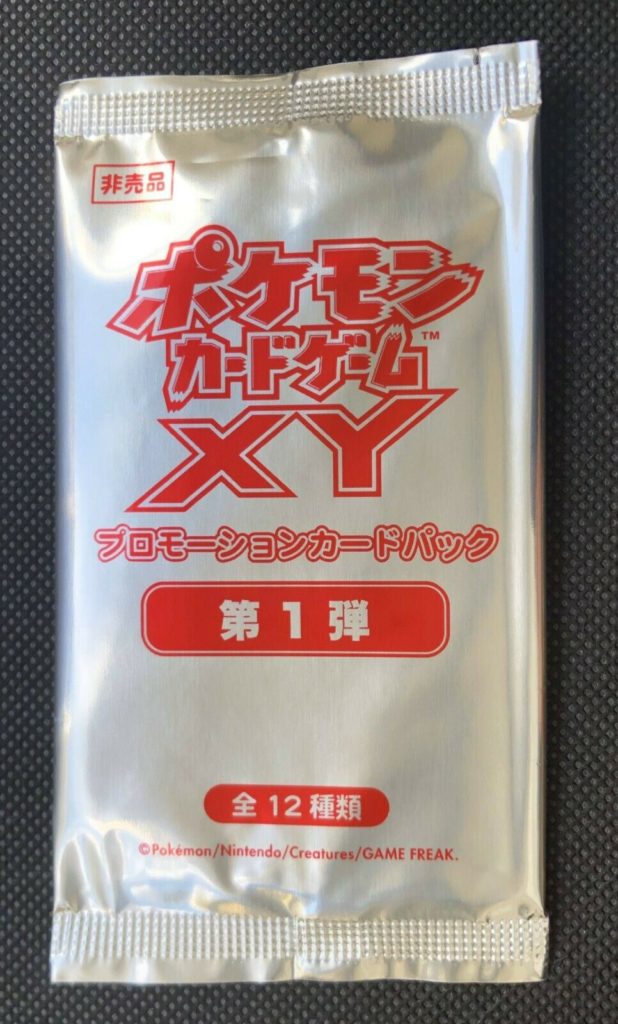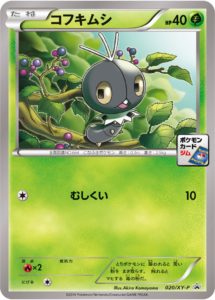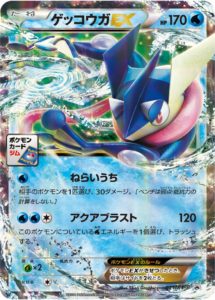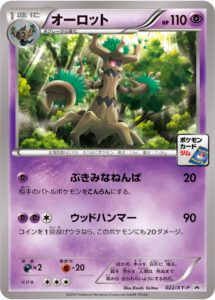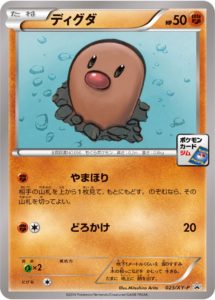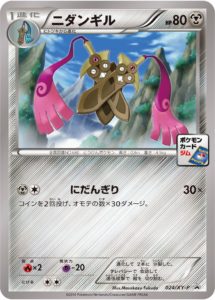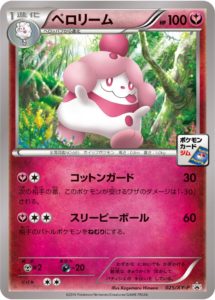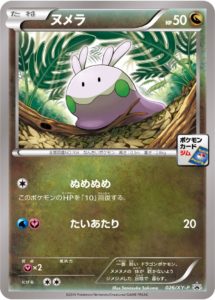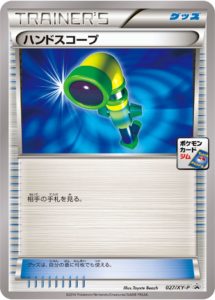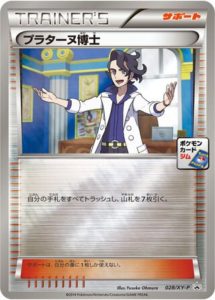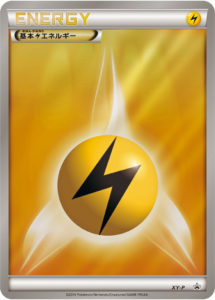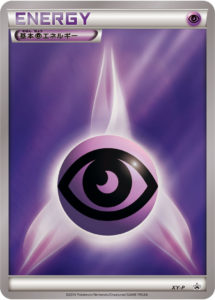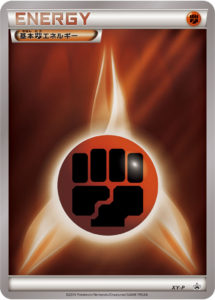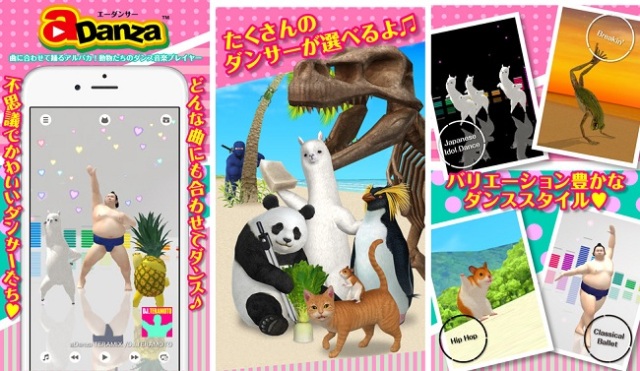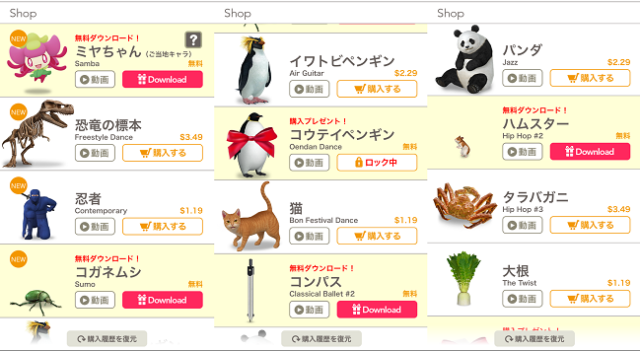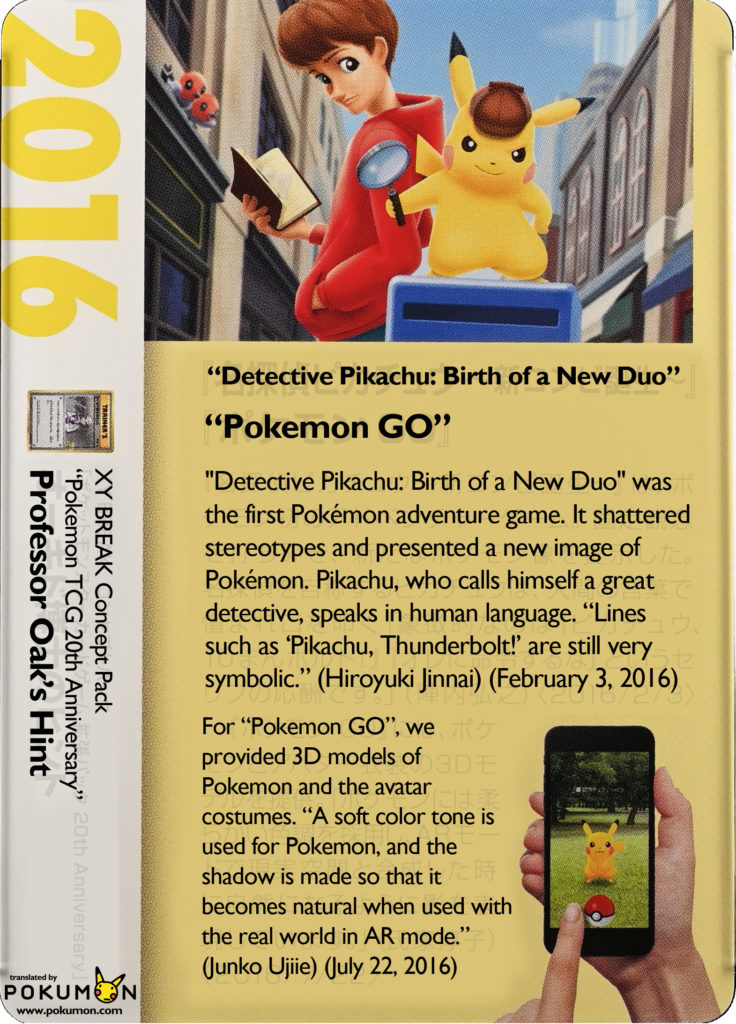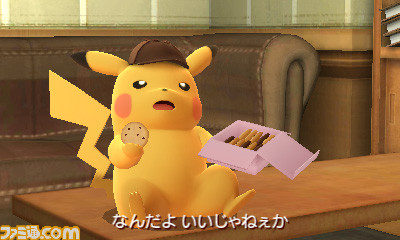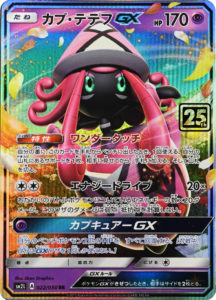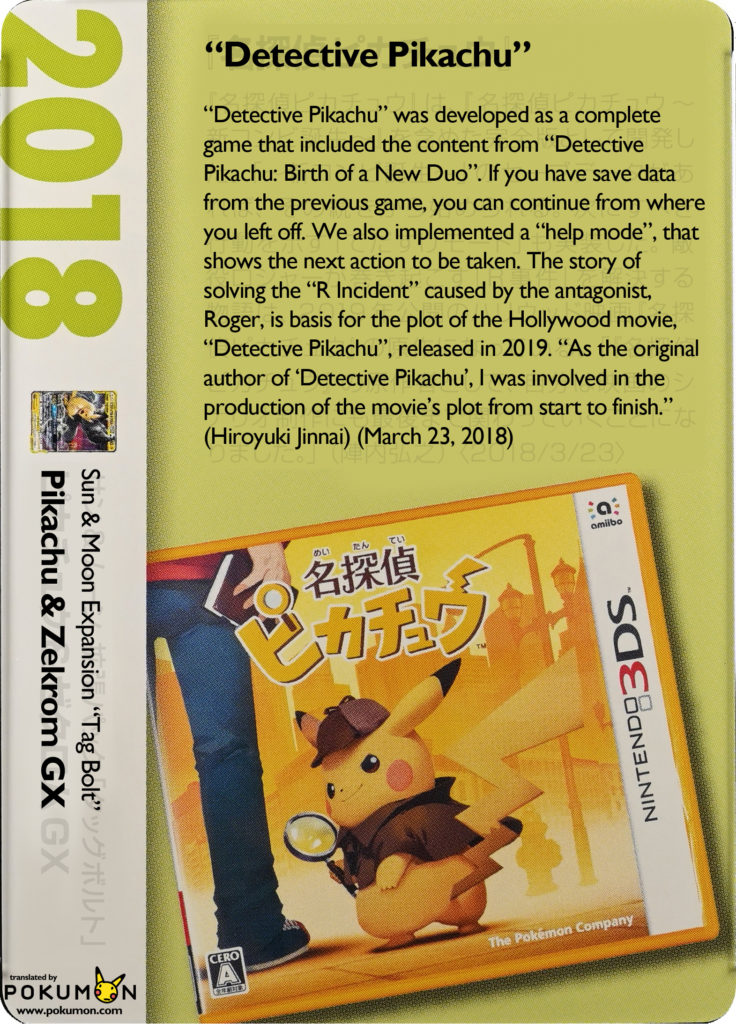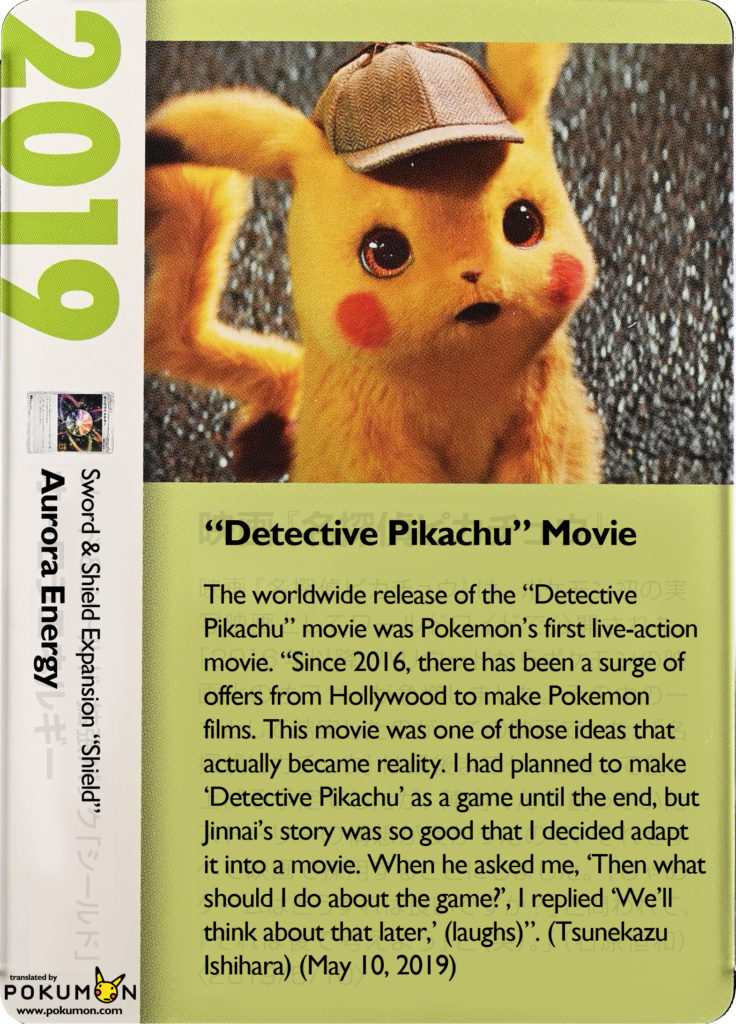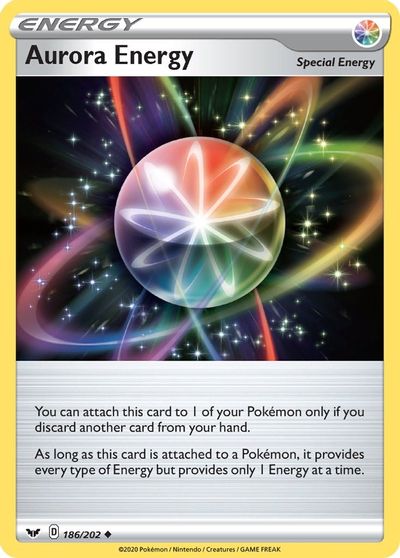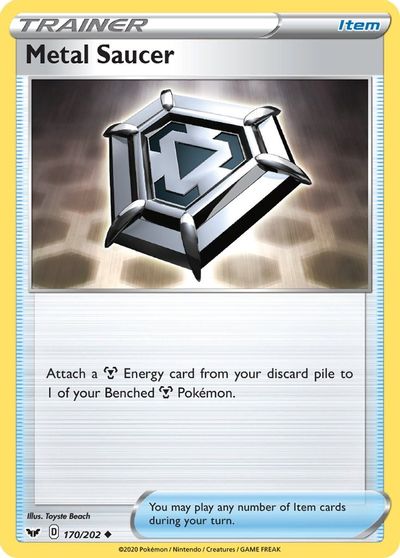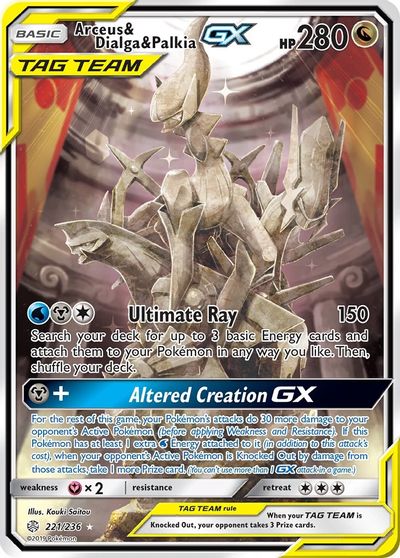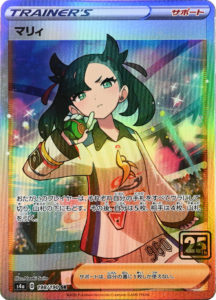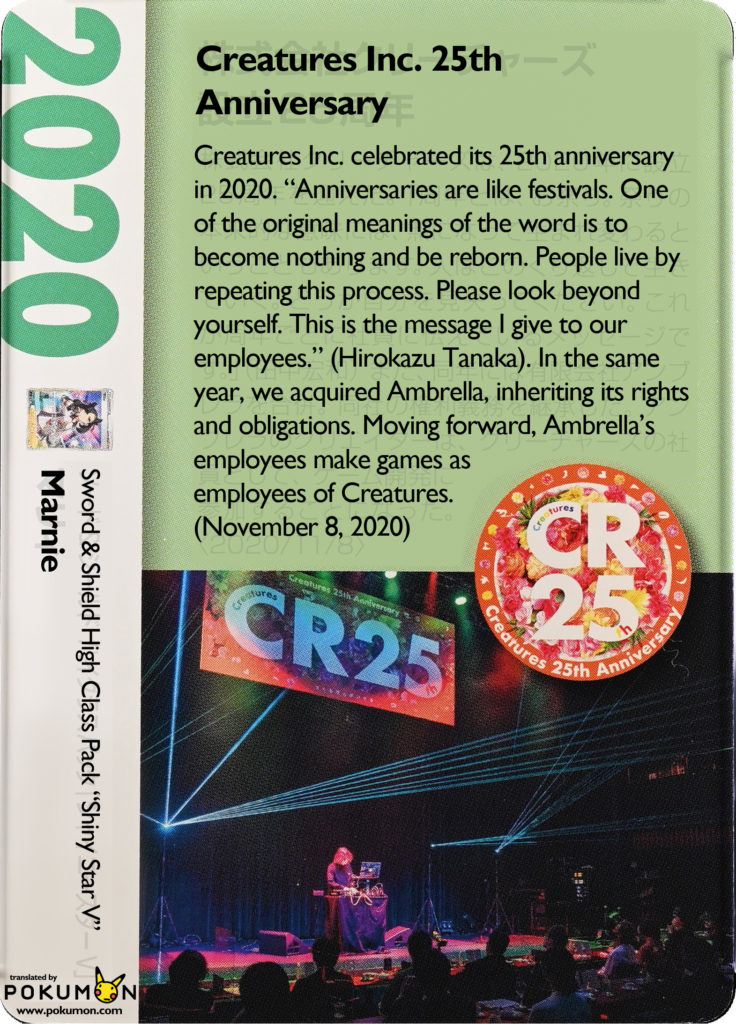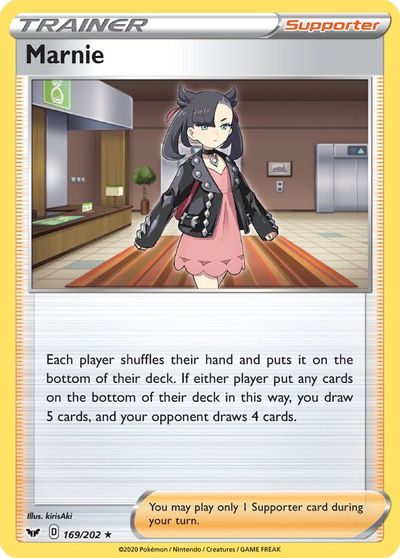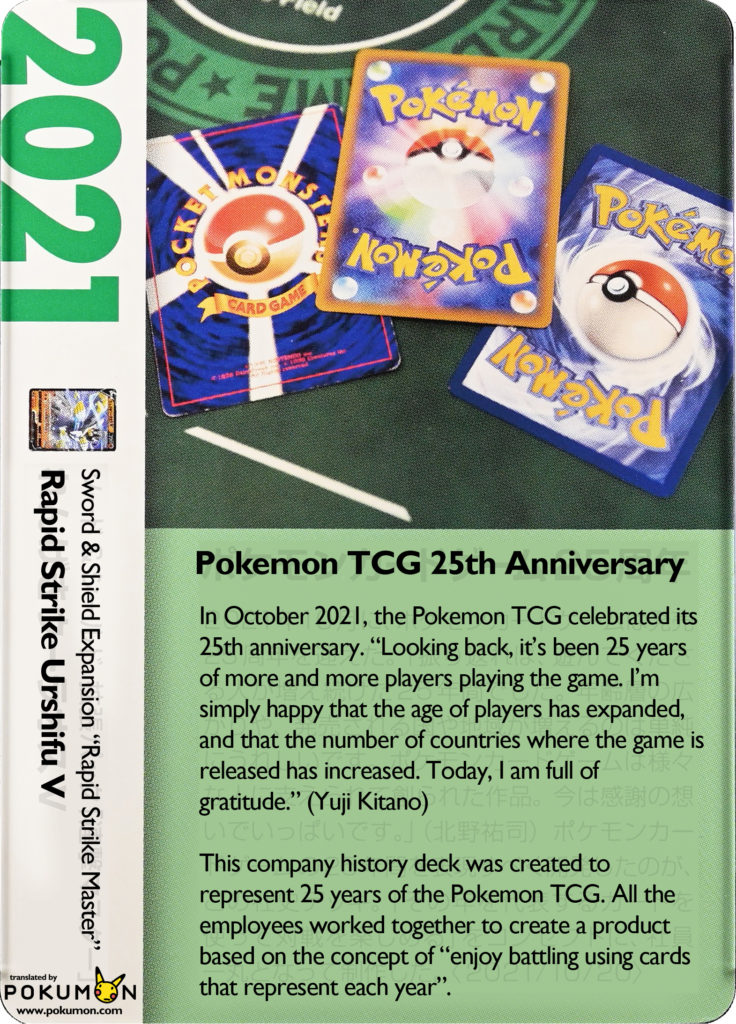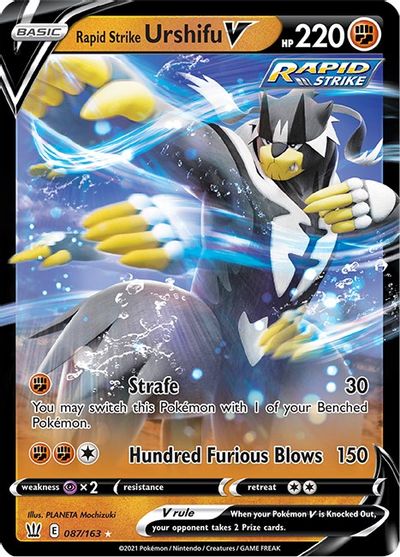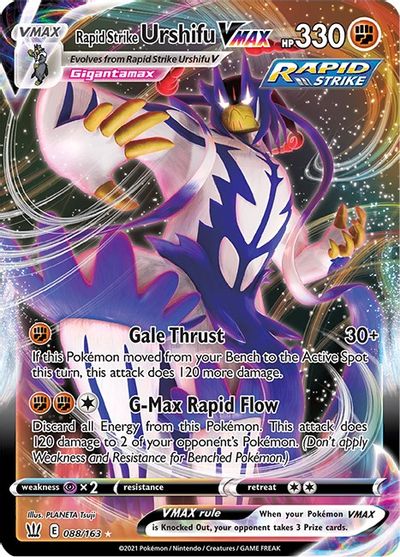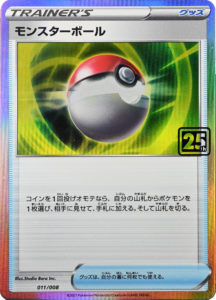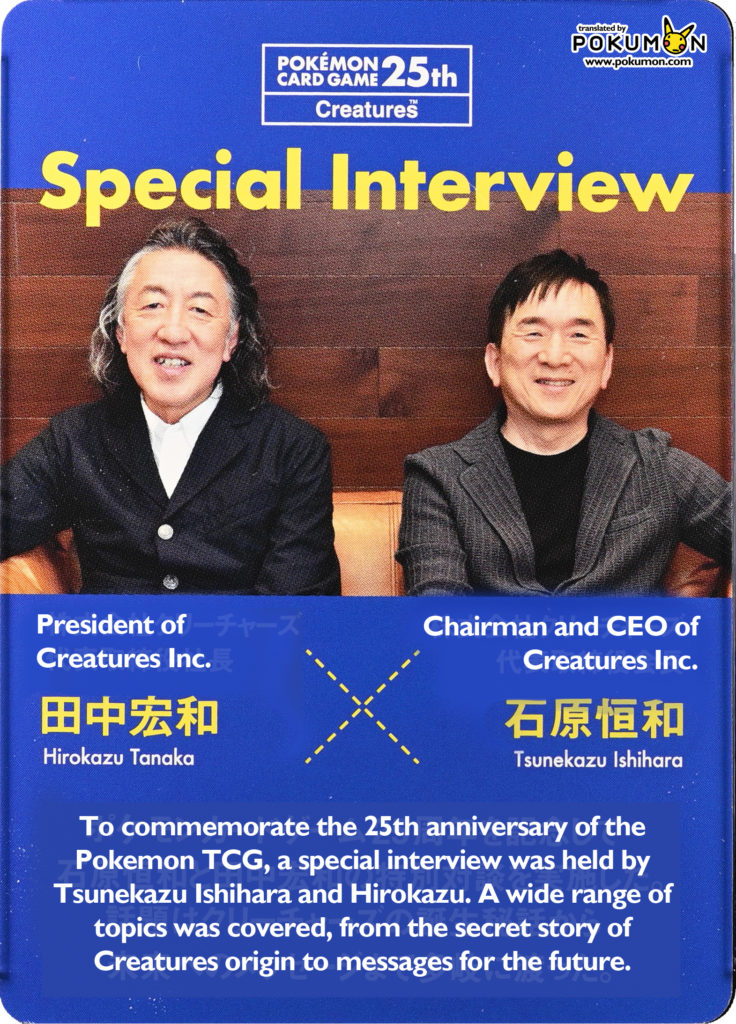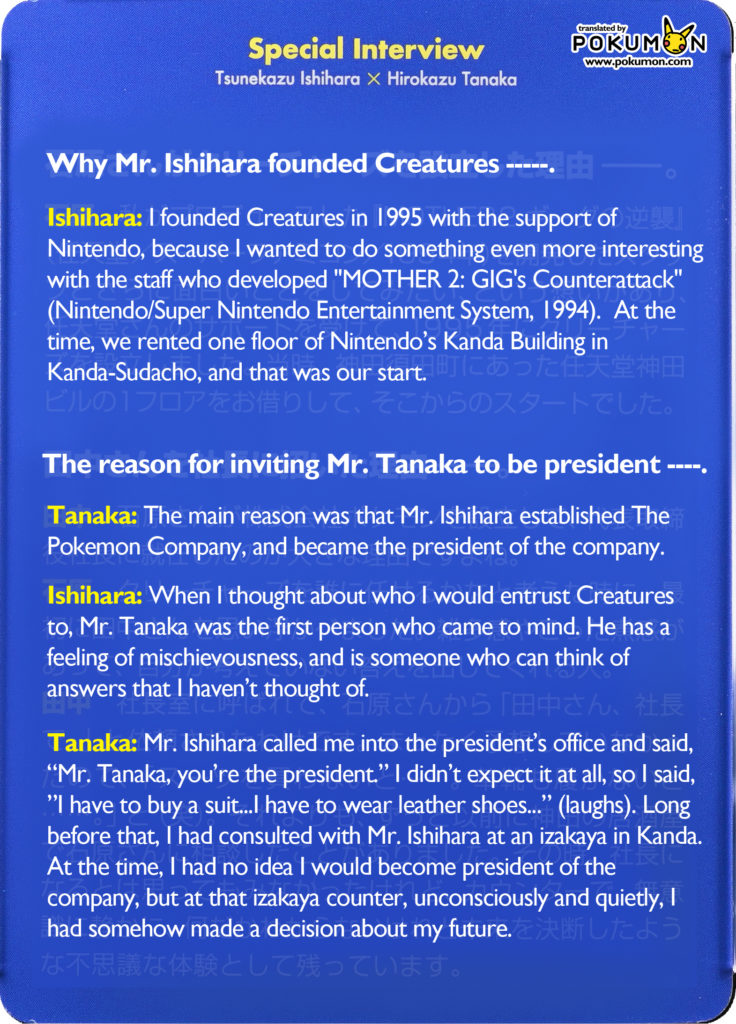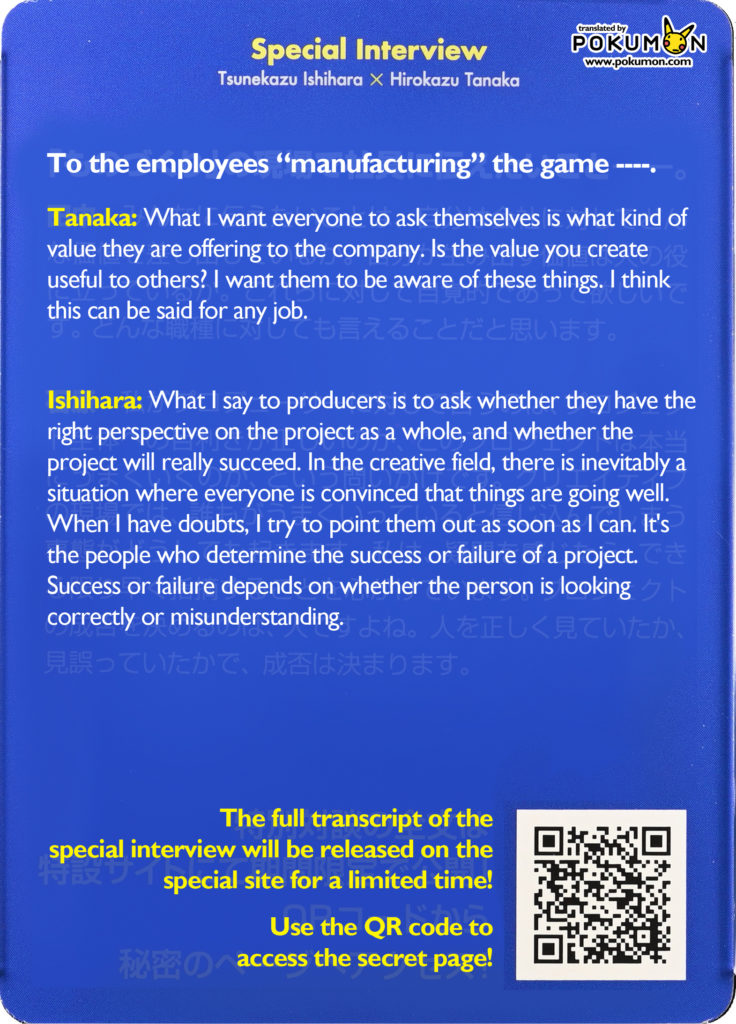In December 2021, Creatures Inc. distributed a holiday gift to various Pokemon TCG illustrators, staff members, and other people who were affiliated with the franchise. Most notably, this gift contained a 30-card half deck to commemorate the franchise’s 25th anniversary.
This was one of the final parts of Pokemon’s 25th anniversary celebration. It was limited to only to employees and the contracted illustrators who worked with the TCG.
Due to the exclusive nature of the product and its subsequent distribution, the number of these available publicly is extremely low. This translates to high price tags for the individual cards within, and especially for the complete set.
Distribution
As early as December 26, 2021, various illustrators for the Pokemon TCG received a package containing the gift, meaning that they were likely meant as Christmas gifts.



In addition to TCG illustrators, other notable figures who were affiliated with Creatures Inc. such as Masahiro Sakurai, the game director of the Super Smash Bros. franchise, also received the gift.

In total at the end of 2021, there were approximately 175 unique illustrators for the Pokemon TCG. It’s also likely that Creatures Inc. employees received the gift, though it’s unsure if every employee got one. Using Creature’s career and recruiting page, we can estimate the rough number of employees to add to the number of illustrators.
In total if one adds up the survey results, there are approximately 218 employees at Creatures Inc. when the deck was distributed. Adding this to the total number of illustrators gives 393 total recipients. Not all illustrators would receive a deck, since some had passed away or were no longer working with Pokemon. This is likely balanced out by the number of additional decks given to individuals like Sakurai.
Conservatively, an estimate of around 250-400 total decks is reasonable. It could be much less if not all Creatures Inc. employees received one, and only those working on the Pokemon TCG.
Packaging and Contents
The deck was shipped in a large wooden box containing all its contents. In total, the wooden gift box contained:
- 30-card half deck in a deck box
- 32 foil card sleeves with the original Pokemon card back
- An indigo-dyed carrying pouch.
- Several letters and explanation cards for both the deck and the pouch.
It was sealed in plastic with a gold sticker seal depicting energy symbols. Inside the box was a plastic insert holding corporate history deck box, which contained the 30-card half deck and card sleeves.
Affixed underneath the lid of the wooden box was a letter to the recipient. This letter from Chairman and Founder of Creatures Inc., thanked them for their continued support of the the Pokemon TCG. It also detailed the two main items in the box: the indigo pouch and the deck.
There’s also a note in this letter that the 30-card half-deck is a playable deck, and instructs the recipient to sleeve up all the cards (since they have different backs) and try playing with them.

Deck Box
The deck box itself was printed with holographic card stock, and like the pouch, was a deep-blue indigo color similar to the main Creature’s Inc. branding. It describes the deck’s contents, along with a short description of mission of documenting the company’s history through cards. It’s mentioned that this is just the beginning of the project, suggesting that there could be more cards in future years to come.
The box also features a special UPC barcode: 1995 2021 2525. This is a reference to the years represented within the box (1995 to 2021), and commemorates the 25th anniversary.
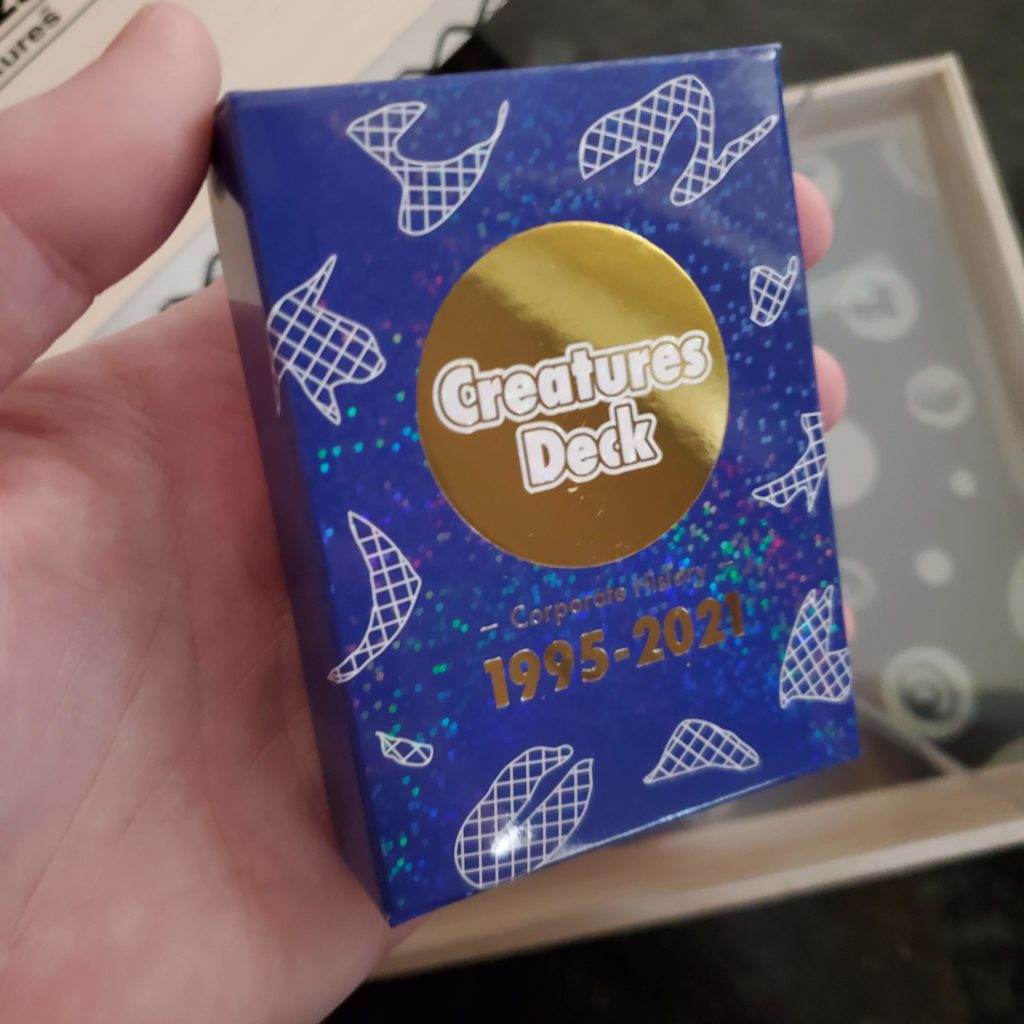
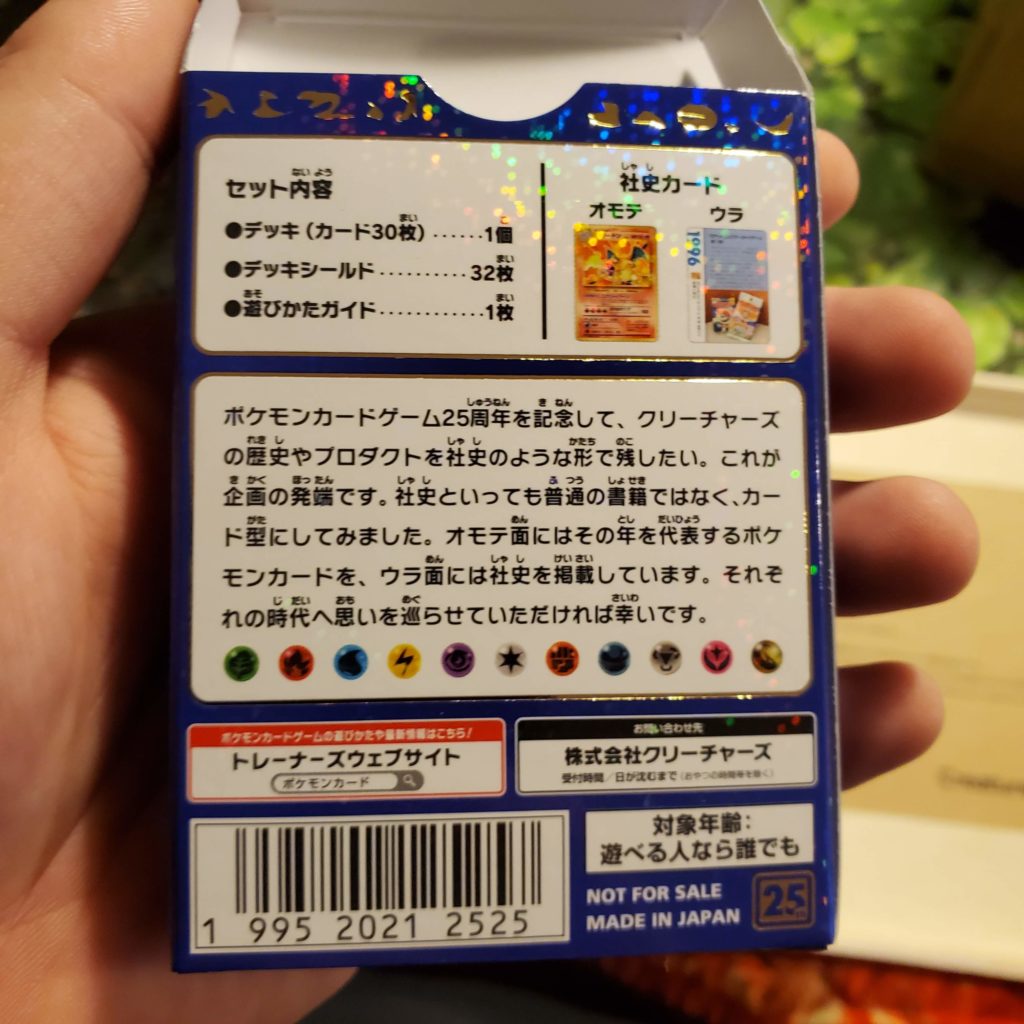
The deck box contained the 30-card half deck, as well as a double-sided how to play guide. The first side contained a standard explanation of the Pokemon TCG’s rules.
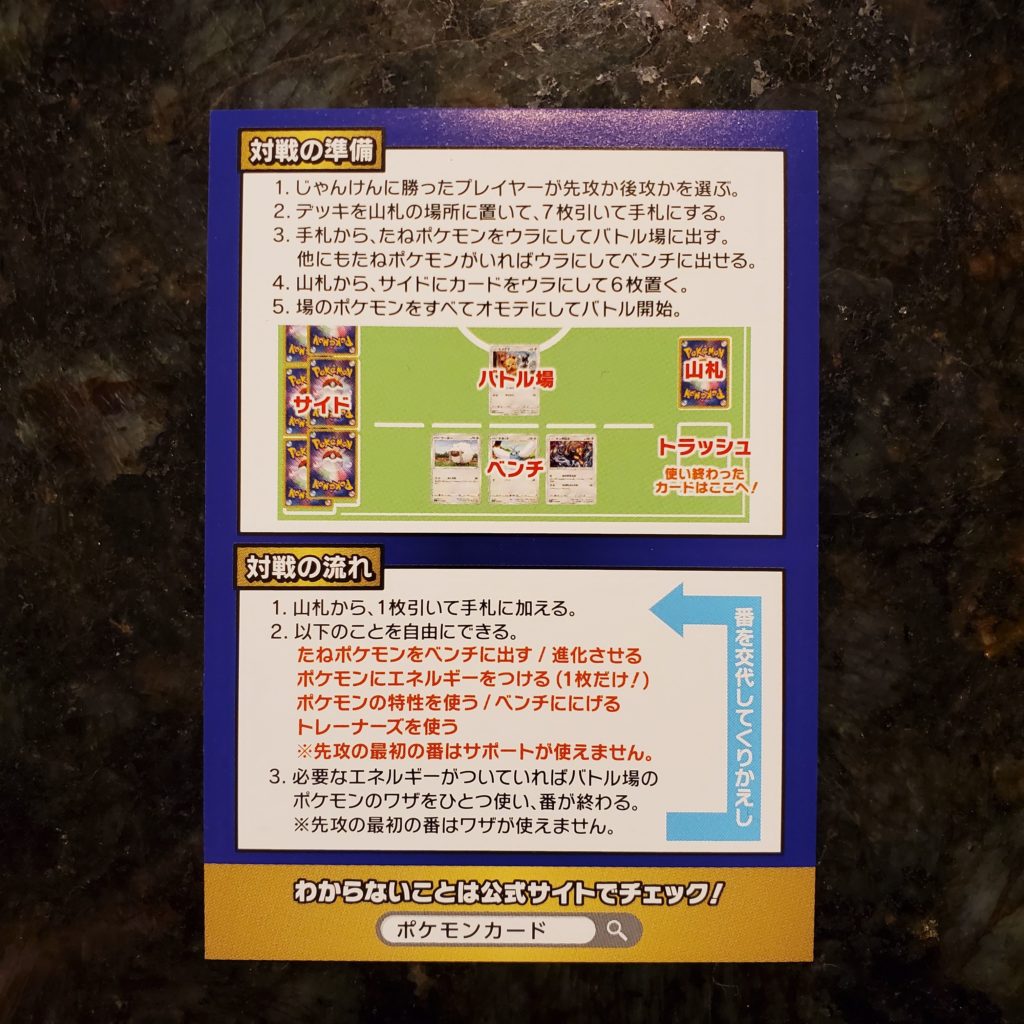
The other side of the how to play guide includes a few special rules for playing the with the 30-card half deck. This includes the standard modified half-deck rules (3 prize cards instead of 6), and also a special win condition for the player with the corporate history deck. At any point in the game, the player could reveal the back of 5 cards in their hand by removing them from their card sleeves. If those 5 cards had consecutive years, they player would win the game.
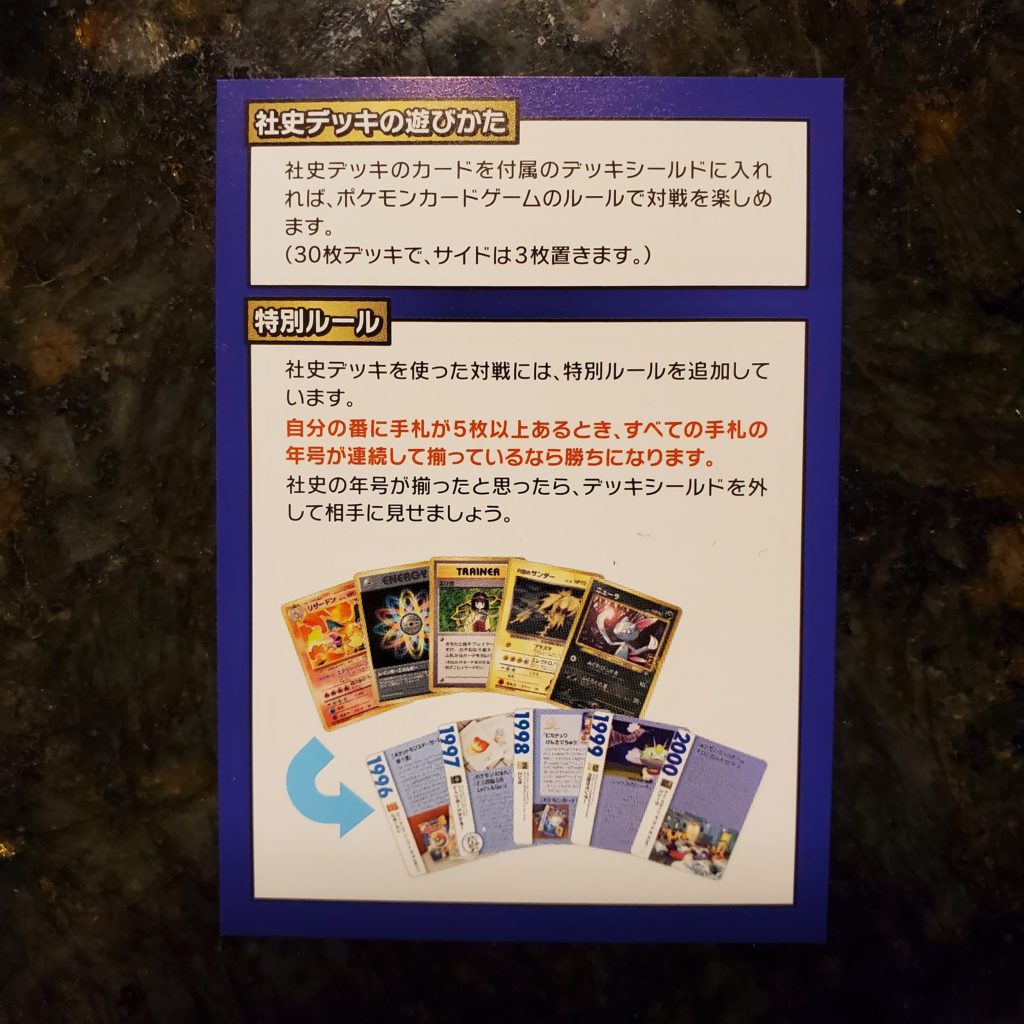
Lastly, the deck box also includes a set of 32 sleeves. These sleeves feature the original Pokemon TCG card back. This design of card sleeves had previously been available via various channels, but the ones in the corporate history deck are unique in that they are holographic.

Pouch
The second “gift” in the box was an indigo-dyed zipper pouch. This is decorated with energy symbols.

The pouch was hand-dyed by the Takeshu Nakajima Konya in Hanyu City, Saitama Prefecture. Konyas are traditional Japanese dye shops that date back to Japan’s Edo period.
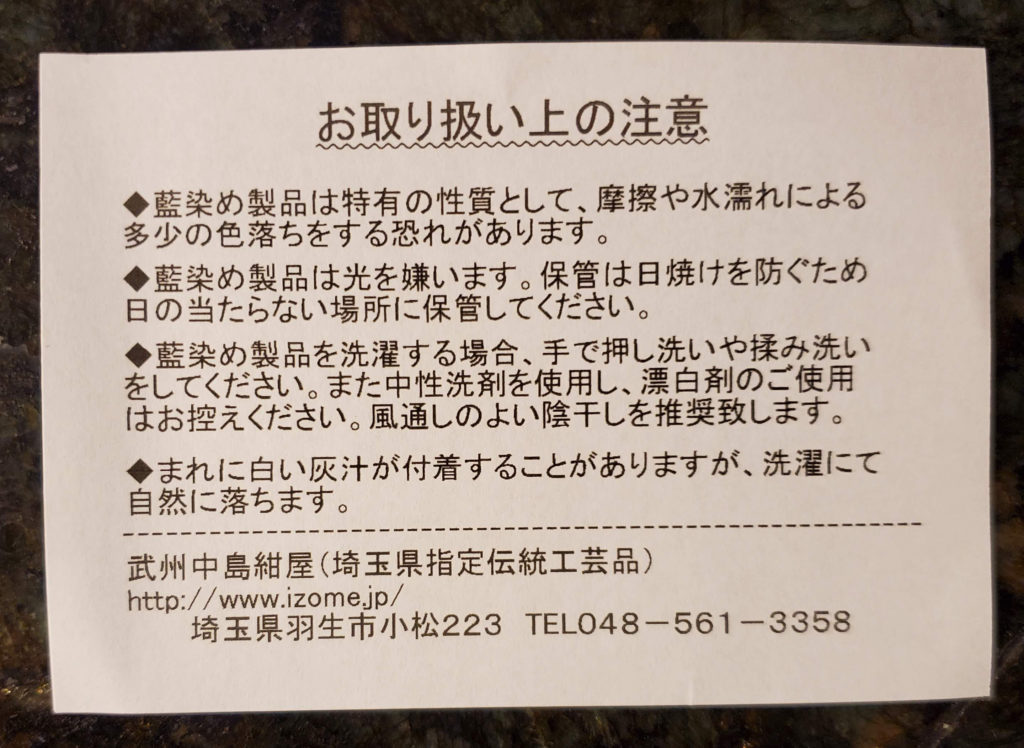
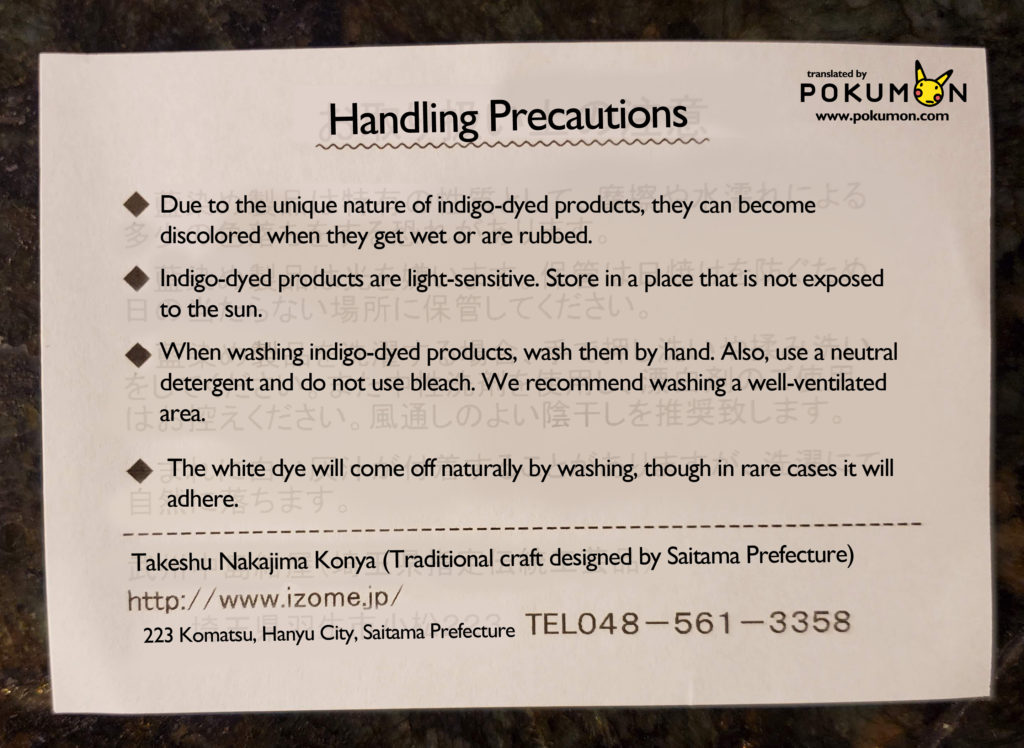
The included double-sided history card also explains the origins of indigo dye, the Konya, and some suggested care instructions.
Corporate History Deck Cards
There are 30 total unique cards, each with their own backs detailing a year in Creatures Inc.’s history. The card fronts all use the star holofoil that is commonly used with trophy cards, while the backs are non-holo. Each card’s front also had the Pokemon 25th anniversary logo embossed onto them in gold foil.
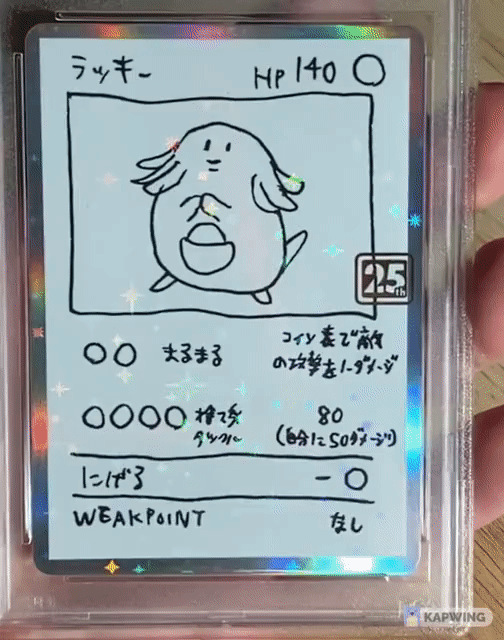

The cards are printed on slightly thinner cardstock than standard TCG cards, and have a textured matte card back instead of a regular TCG card’s glossier surface.
Additionally, there are 3 cards that contain a special interview with Hirokazu Tanaka and Tsunekazu Ishihara. Tanaka is the president of Creatures Inc. (formerly Nintendo’s in-house composer during the 8- and 16-bit era of video games), and Ishihara is president of The Pokemon Company.
Since the whole 30-card deck is meant to be playable, there are quite a few years represented by energy cards. Each card selected has some level of significance to the TCG’s competitive or cultural history.
1995: Chansey (Prototype)
The first card of the deck is actually themed to a year before the Pokemon TCG’s actual release. The game officially released in 1996, but had begun development already in 1995. A “prototype” or version of the Chansey card from Base Set was chosen to represent this year.
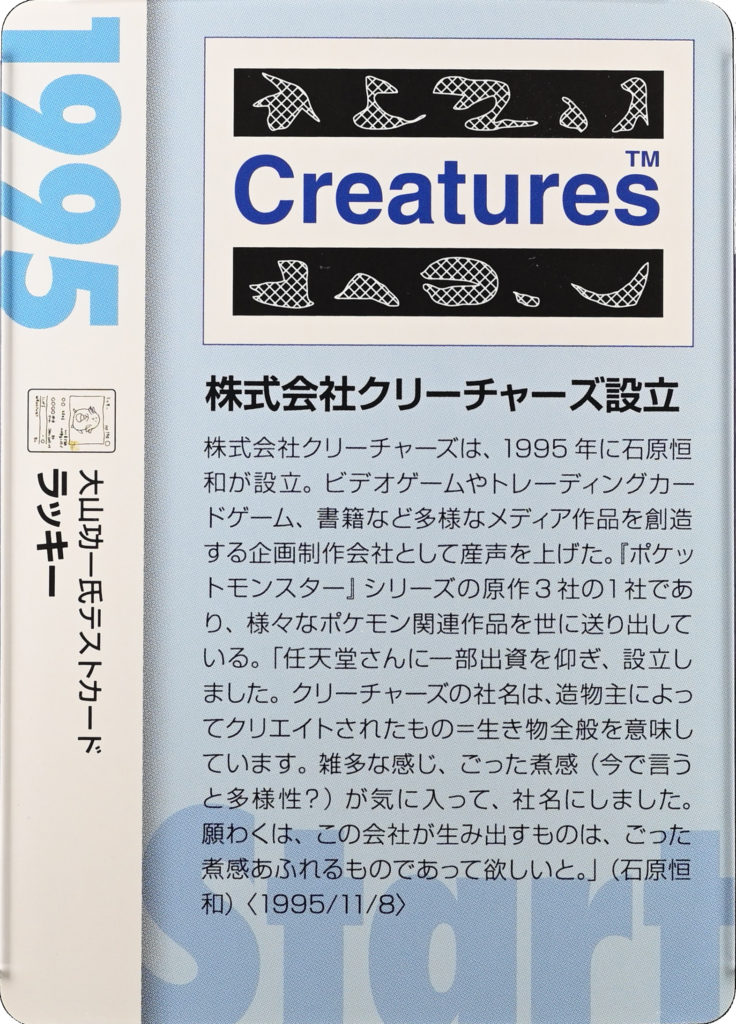
Chansey was one of the earliest mainstays of the competitive Pokemon TCG metagame, and remained relevant throughout every era it was legal in. It was present in the winning decklists of the 1st Official Pokemon Card Game Tournament, as well as in multiple decks in the first championship series, the 1998 Lizardon Mega Battles.
This “test” card appears to have illustrated and templated by Kouichi Ooyama, one of the original TCG designers who would also make multiple appearances at Japanese TCG tournaments throughout the early years of the TCG. It differs from the version that made it to print in multiple ways, though it is remarkably similar to what was eventually released to the public
- HP was decreased from 140 to 120
- “Double-Edge” originally did only 50 damage to Chansey. The released version dealt 80 to itself.
- Chansey had no weakness instead of being weak to fighting.
- Chansey had no resistance.
The back side of the card describes Creatures Inc.’s founding story and name origin. Ishihara chose it to represent all living things (creatures).
1996: Charizard (Base Set)
1996 was the year that the Pokemon TCG officially was released in Japan. It is represented by perhaps the most famous card in the Pokemon TCG, Base Set’s Charizard.
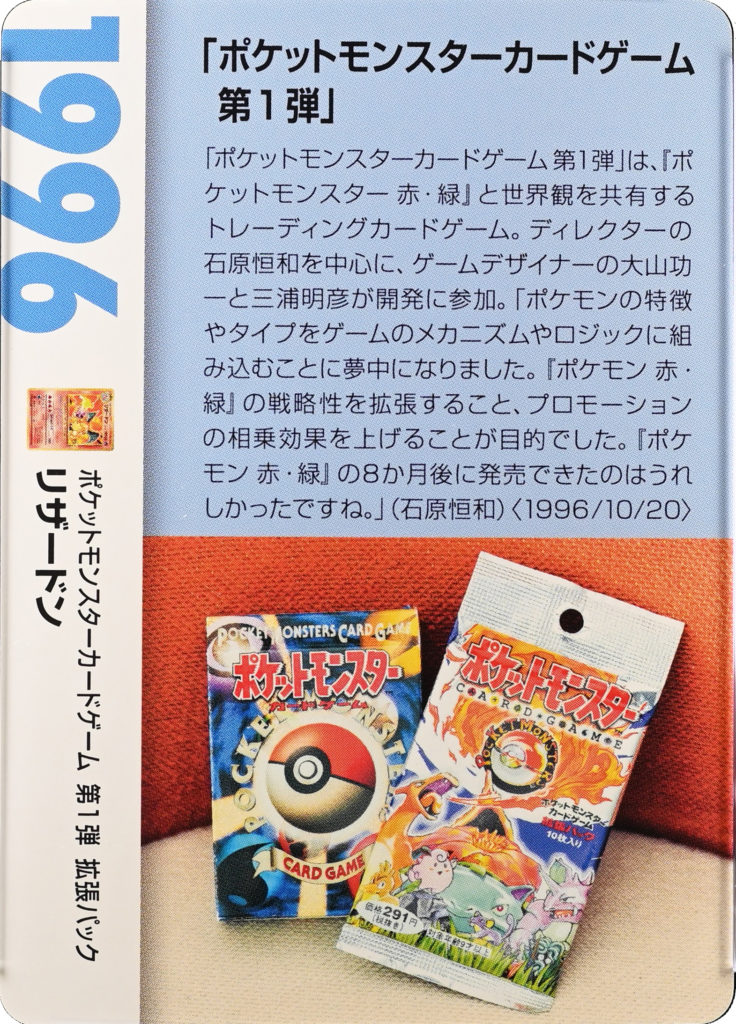
This Charizard card was not only iconic due to its high HP and damage numbers, but because it was one of the few evolved Pokemon cards playable in the the early tournaments like the 1999 International Tropical Mega Battle.
The back describes Ishihara leading two other game designers, Kouichi Ooyama and Akihiko Miura in the game’s design. It also confirms that the TCG was in development long before the first Pokemon video games had shipped. This had been referenced in a March 14, 2019 Famitsu interview with Creatures Inc. director Atsushi Nagashima, but serves as definite confirmation of that rumor.
“At the time, I had yet to be involved in Pokemon Cards, so this is what I’ve heard, but it was Creatures founder [Tsunekazu] Ishihara who at the time was studying board games of all sorts. At the time, Pokemon Red & Green were still in development, but from how you could collect 151 species of Pokemon, and the game’s turn-based battle system, it was very compatible with the TCG format. That’s how development began, so I hear.”
Atsushi Nagashima, Director at Creatures Inc.
1997: Rainbow Energy (Team Rocket)
1997 is represented by the Rainbow Energy from the “Team Rocket” expansion.
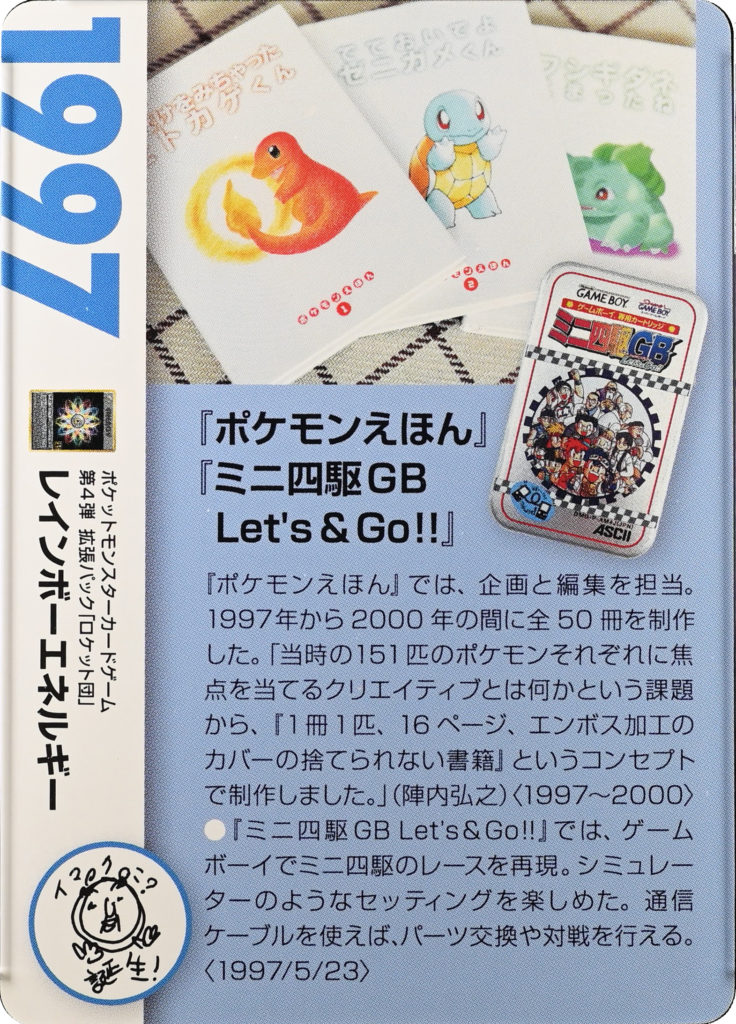
Rainbow Energy was the first rare special energy card, and was immediately playable in many competitive decks due to its ability to support multiple energy types.
The back of the card describes the “Pokemon Tales” series of picture books. This diverse series of picture books consisted of 50 volumes, and was published by Shogakukan, the same book publisher that publishes the CoroCoro Comics magazines.
They were authored by a diverse group of Creatures Inc. employees from 1997 to 2000. Each book focuses on a Pokemon that is featured on the embossed front cover. The books were localized and released overseas as well by various publishers.
The back of the card also goes over one of Creatures Inc.’s earliest non-Pokemon games, Mini 4WD Lets & Go!!. This Game Boy game was a racing simulator based on small powered toy race cars called Mini Yonku or Mini 4-wheel drives. These toy cards are generally 1:32 scale, and have electric motors that power the 4 wheels.
In the game, players could use the Game Boy’s link cable to trade car parts as well as race against each other. This is fairly similar to how the link cables were used in the Pokemon video games.
1998: Erika (Gym Heroes)
1998 featured the Erika trainer card from the “Gym Heroes” (Leader’s Stadium in Japan) expansion.
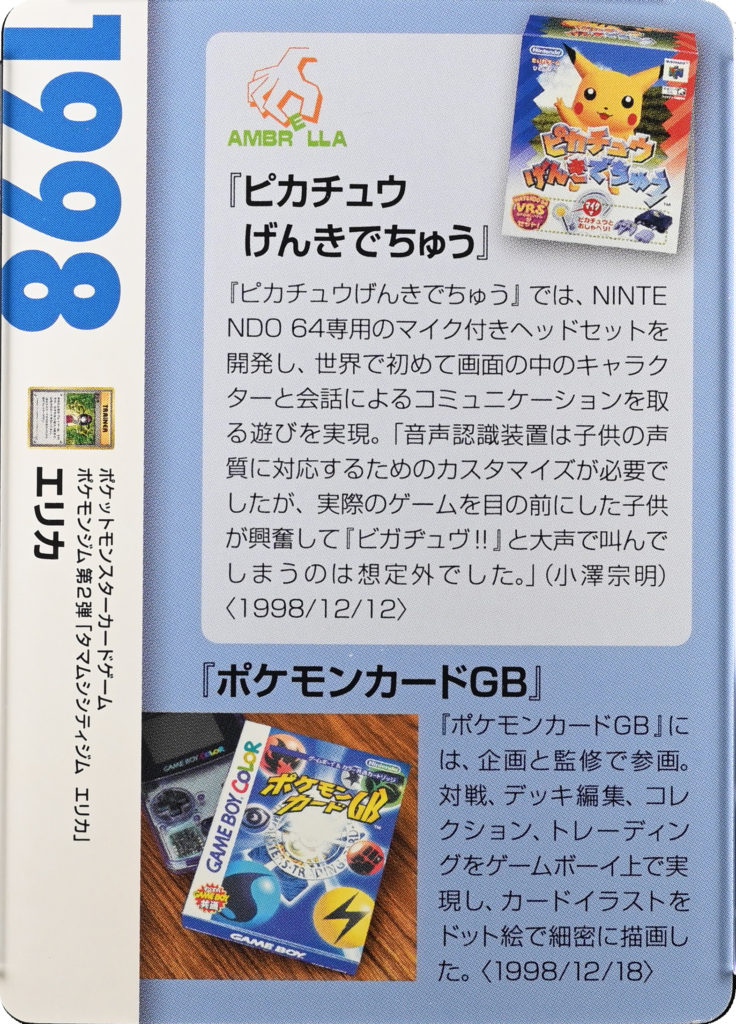
While Erika was not a competitive staple during the time that it was legal, it’s important to note that this trainer has not been updated to include the “Supporter” type. This means that while playing with the half deck, players could play both this card and another Supporter on the same turn. Erika’s symmetrical effect of both players drawing up to 3 cards is likely why it was chosen to be included while keeping the original printed rules.
The backside of the card featured the Nintendo 64 game, Hey You, Pikachu! This game included a microphone, known as a “voice recognition unit” (VRU), that allowed the player to talk to Pikachu using their voice, and have the in-game Pikachu respond accordingly. Only two Nintendo 64 games ever used the VRU: Hey You, Pikachu! and the Japan-exclusive Densha de Go! 64 (a bullet train simulator).
This was the first Pokemon game that Creatures would partner with developer Ambrella. They would go on to partner multiple times, and eventually acquired Ambrella in 2020.
Additionally, the 1998 card’s back also features the Pokemon Trading Card Game on Game Boy Color (known in Japan as ポケモンカードGB, “Pokemon Card GB”). Creatures was responsible for the planning and supervision of the title, while development was done by Hudson Soft.
Prior to their acquisition by Konami in 2012, Hudson Soft collaborated with Nintendo on multiple titles, including the sequel to the Pokemon TCG Game Boy game, Pokémon Card GB2: Here Comes Team GR! (ポケモンカードGB2 GR団参上!).

1999: Rocket’s Zapdos (Gym Challenge)
1999’s featured card was a fan favorite, Rocket’s Zapdos from the “Gym Challenge” set (known in Japan as the second Gym set, “Challenge from Darkness”).
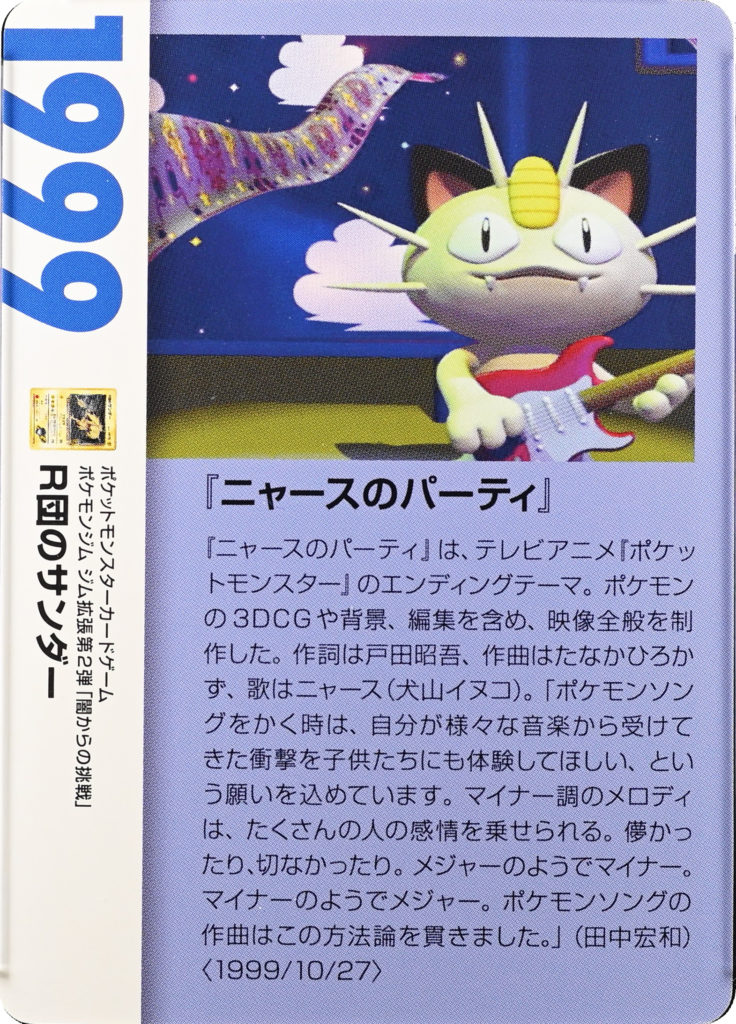
Rocket’s Zapdos was a tournament staple during its time due to being a powerful Basic Pokemon. It was strong enough to be restricted via the Hall of Fame system implemented in 2001’s Neo Spring and Summer tournaments at a rank of 2 stars. Players in these tournaments were only allowed to run up to Hall of Fame card with a total of 4 stars total, meaning that 2 copies Rocket’s Zapdos would take all available spots in a deck.
The backside featured the “Meowth’s Party” song. This was a CD single released in October 1999, and was one of Creature’s first forays into 3D computer graphics.
The song’s lyrics are written by Akihito Toda, the composition by Hirokazu Tanaka, and the song is sung by Inuko Inuyama as Meowth.
2000: Sneasel (Neo Genesis)
2000’s featured card is Sneasel from the first set of Generation 2, “Neo Genesis” (known in Japan as “Gold, Silver, to a New World…”.
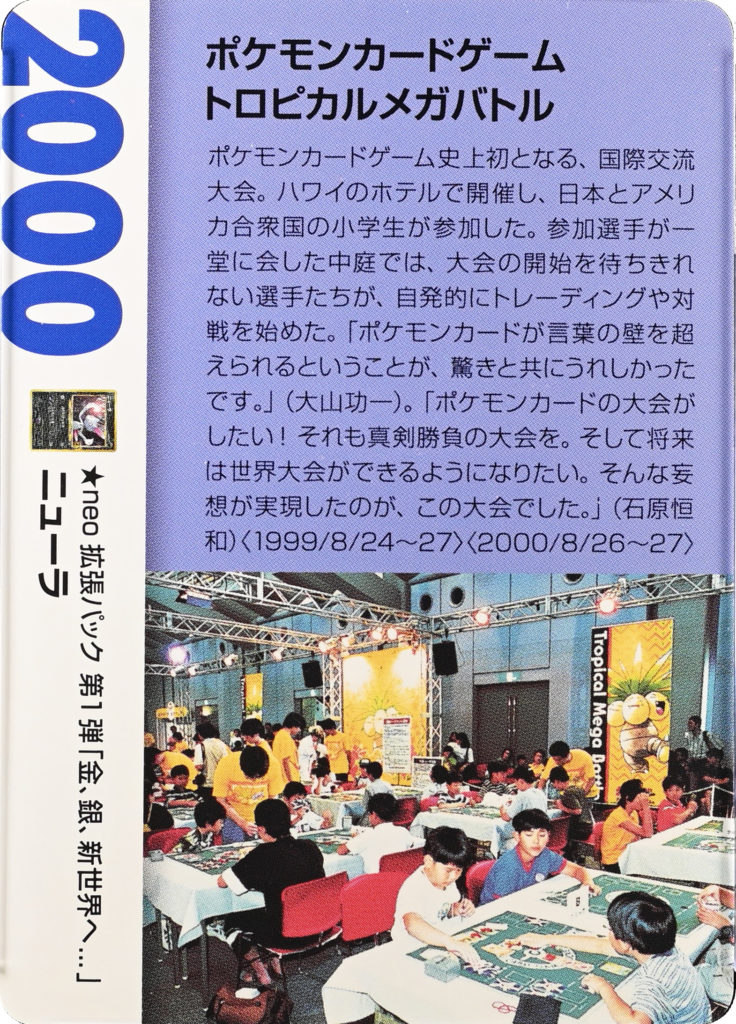
Sneasel is one of the most infamous cards in the early competitive TCG scene. It was the first card to be banned by Wizards of the Coast in competitive play, and in Japanese tournaments it was restricted as a 3 star Hall of Fame Card, meaning that only 1 copy could be in a deck. Several factors led to Sneasel’s dominance:
- As a basic Pokemon, its “Beat Up” attack was able to do an average of 80 damage for 2 energy, with a maximum of 140. At the time, Base Set’s Electabuzz was next runner up, dealing 40 damage for 2 energy along with a risk of hurting itself for 10 damage.
- It had a free retreat cost
- It had no weakness
- It resisted Psychic Pokemon
- Darkness Energy cards that were needed for “Beat Up” increased a Pokemon’s damage by 10 per card, which meant that using the attack have a guaranteed +20 damage.
- Sneasel avoided the 1 damage counter per turn drawback of Darkness Energy due to its Dark typing.
The half-deck doesn’t actually have any Darkness Energy cards, so in order to fully utilize Sneasel, the player would have to use the special energy cards in the deck like Rainbow Energy and Blend Energy.
The back of the card pays homage to the Tropical Mega Battle events, specifically the 1999 International Tropical Mega Battle and the 2000 International Tropical Mega Battle. These events would continue until 2002, after which they would be replaced by the World Championships in 2004. Ishihara had always dreamed of hosting world tournaments for the Pokemon TCG, and these events were the genesis of those.
2001: Lightning Energy (Neo Destiny)
2001’s featured card is the first basic energy of the deck: a Lightning Energy card from the 4th Neo set, “Neo Destiny” (known as “Darkness, and to Light…” in Japan). This was the last set to feature the original energy card design that had been used since the Base Set.
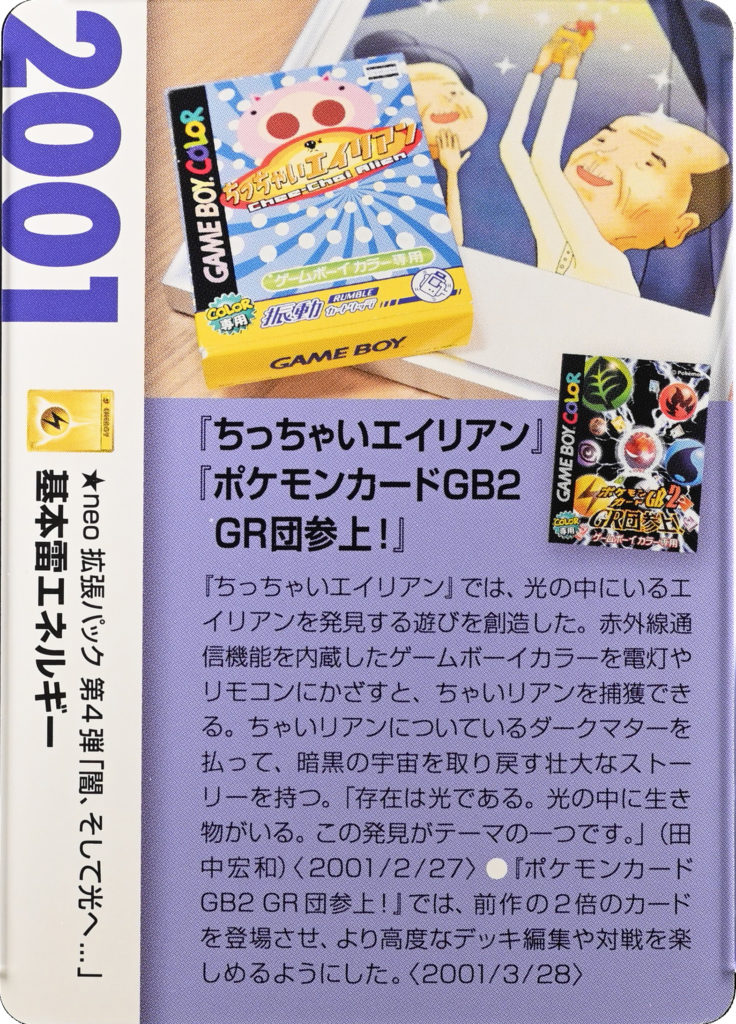
The back side features 2 Game Boy Color titles that Creatures Inc. developed or co-developed. The first was Chee-Chai Alien, a Japan-exclusive Game Boy Color title that utilized the Game Boy Color’s infrared (IR) sensor to “capture” aliens.
By holding their Game Boy near sources of light like lamps, or IR devices like remote controls, the game would interpret the signal as an alien in game. The game included a “spectrum communicator” add-on for the Game Boy Color to help boost this capability. Since the Game Boy Advance did not have an IR sensor, this is one of the only GBC games that does not work on the GBA.
The second featured game was the sequel to the first Pokemon TCG Game Boy game. This Japan-exclusive title was known as Pokémon Card GB2: Here Comes Team GR! (ポケモンカードGB2 GR団参上!).
It was developed again by Hudson Soft, and was the first title that The Pokemon Company International published. It was the final Pokemon Game Boy Color title released.
The game doubled the available card pool, and included many Japan-exclusive promo cards, as well as most of the cards from the 3 Expansion Sheets that were available from Japanese vending machines. The game included 2 physical promo cards within the game box.
2002: Crystal Energy (Aquapolis)
2002’s featured card is the Crystal Energy card from the 3rd e-Series expansion, “Aquapolis” (known in Japan as “Wind from the Sea”).
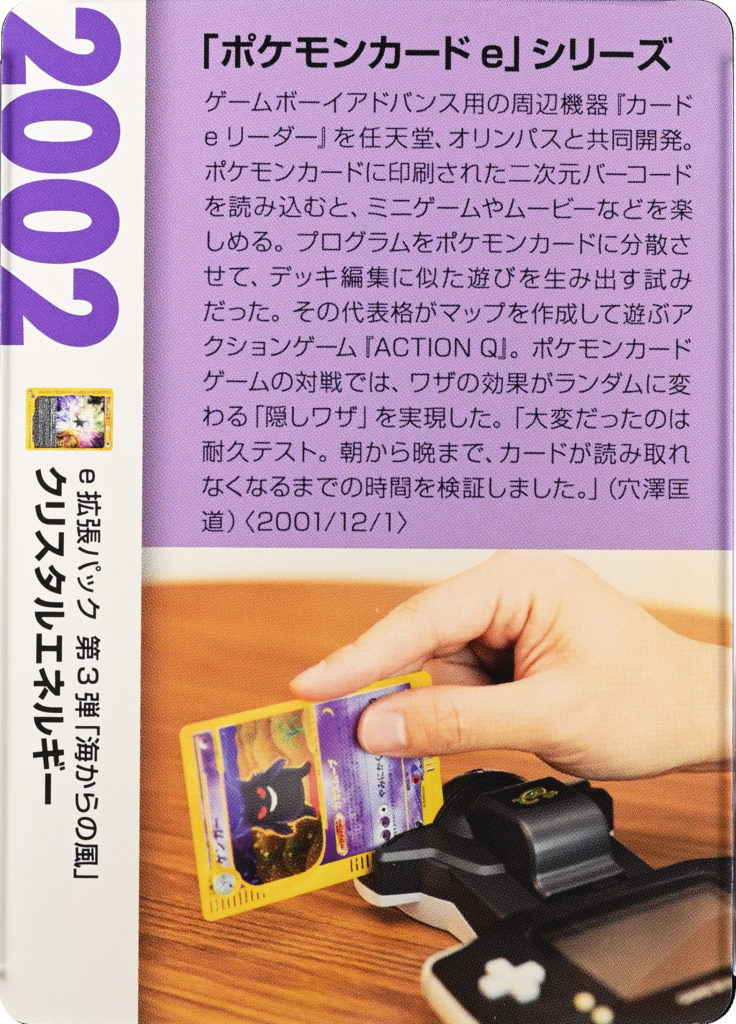
The e-Series era was incredibly short-lived during the competitive TCG’s lifetime, as Wizards of the Coast lost the license to print and distribute the game overseas right after finishing the sets. The resulting legal battle between them and Pokemon resulted in the 2003 World Championships not even being held.
Within the deck, Crystal Energy could only ever provide fighting or lightning energy, as it required basic energy cards to provide non-colorless energy.
The back of the card talks about the history of the e-Reader peripheral. This was an attachment for the Game Boy Advance that allowed players to scan the barcodes on the left and bottom borders of their cards to play minigames, watch short movies, and even use hidden attacks on Pokemon cards during matches. These hidden attacks were allowed in official tournament play, as the 2002 Battle Road tournaments explicitly call them out. Unfortunately, the barcodes printed on this particular card was not printed using the proper printer to allow it to be scanned (and it’s also holographic), so the corporate history deck print of the card is not readable by the e-Reader.
Specifically, the back also references a game called Construction: Action (known in Japan as “Action-Q”). This was a multi-card e-Reader minigame where players would have to scan a “player” card (normally from a trainer card), and then construct a level with up to 6 cards.
Players would then use their scanned player character to traverse through the level and score points based on what Pokemon were scanned in.
While the holofoil Gengar shown on the image from the back of the card would not have a barcode, the non-holo version of the Gengar pictured (from the Expedition set) doesn’t actually have a long-side barcode.
In the final eSeries set (Skyridge) a Gengar with a long-side barcode could be used to generate a Gengar-themed level in the game.
2003: Fighting Energy (EX Team Magma vs Team Aqua)
2003’s featured card is a basic Fighting Energy card from the “EX Team Magma vs Team Aqua” expansion (known in Japan as “Magma vs Aqua: Two Ambitions”).
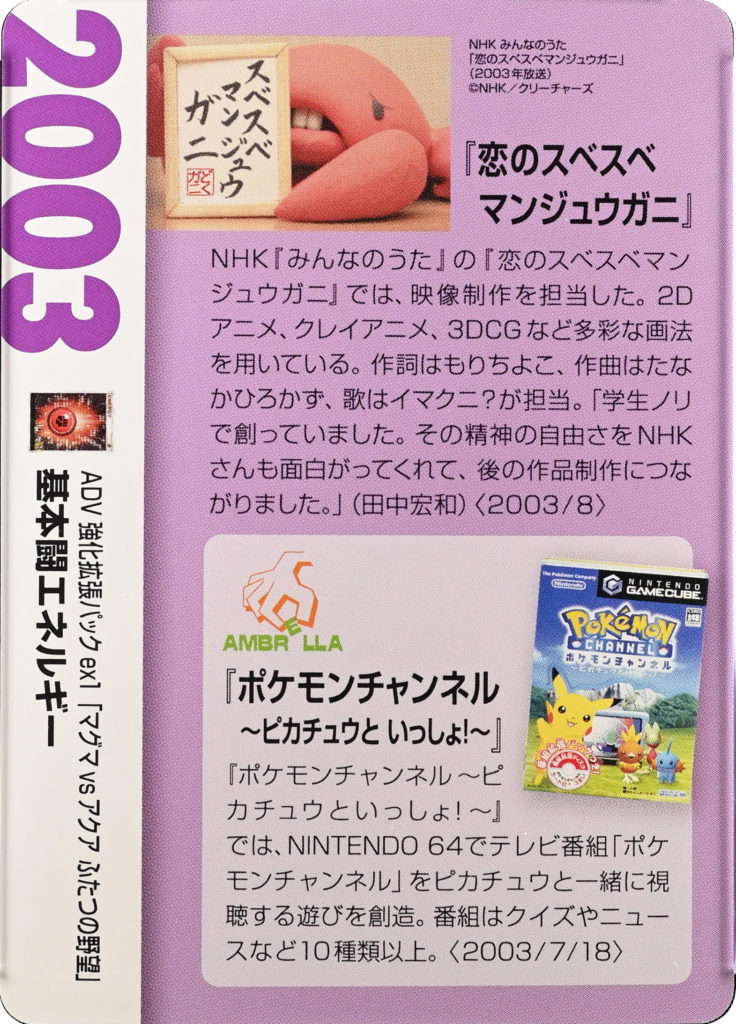
The back of the card featured a song produced by Creatures for the Japanese public TV station, Nippon Hōsō Kyōkai (NHK). NHK had a program called “Everyone’s Songs” (みんなのうた). It is a five-minute NHK TV and radio program which is broadcast several times daily. The program started on April 3, 1961. It is one of NHK’s long-running programs. The program is generally used as filler between programs.
The song produced was sung by famed Pokemon personality, Imakuni?, and was about a lonely Floral Egg Crab (マンジュウガニ). These small, toxic crabs is native to the oceans in south east Asia. Creatures was responsible for both the song and the resulting video that accompanied it.
The back also talks about the Pokemon Channel GameCube game. This was a game where the player could play and watch TV programs with Pikachu. Developed by Ambrella, it was created both to serve as a spiritual successor to Hey You, Pikachu! and to promote the Nintendo e-Reader peripheral device.
The game included three e-Reader-compatible cards, but not the e-Reader device itself. When scanned, the cards upload new templates for the player to paint and for Smeargle to critique in one of the included TV programs.
Oddly, the back of the card accidentally writes that Pokemon Channel is a Nintendo 64 game, when in reality it’s a GameCube title.
2004: Charmeleon (EX FireRed & LeafGreen)
2004’s featured card is Charmeleon from the “Charizard Random Constructed Starter Decks” in Japan. This card would be released in English as part of the “EX FireRed & LeafGreen expansion”.
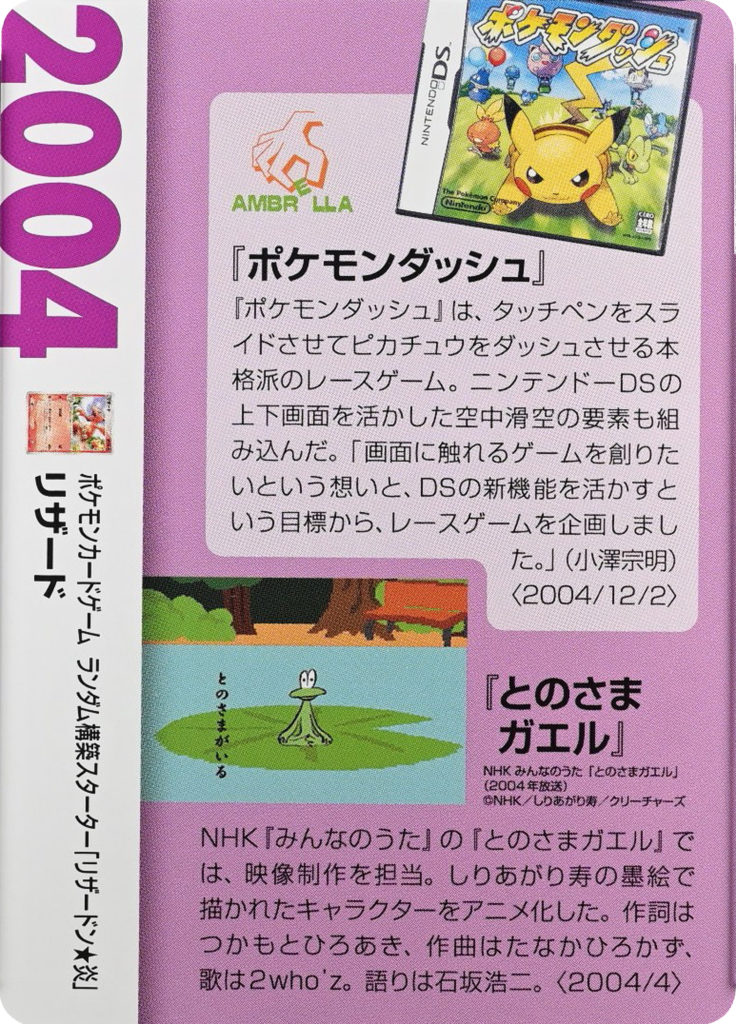
The Random Constructed Starter Decks were semi-randomized 30-card half-deck products targeted at newer players. However, unlike English theme decks, these decks contained cards that were exclusive to the product, including this Charmeleon.
The back of this card included a short blurb from Creatures game director, Muneaki Ozawa on Pokemon Dash, a top-down racing game on the Nintendo DS.
This was another game developed by Ambrella, and it made use of the DS’s dual screens to feature sky races with Flying Pikachu. Though this game was themed around Gen 3, it heavily featured a Gen 4 Pokemon, Munchlax.
Similar to the previous year, this card’s back also featured another song that Creatures produced for NHK’s “Everyone’s Songs” program. This one was titled “Lord Frog”, and featured a Dark-spotted frog. The Japanese name of this frog species is “Tonosama Frog”, which can be literally translated to “Lord Frog”. The song was one of the most popular in the program, with frequent requests for re-broadcasting
2005: Mew ex (EX Legend Maker)
2005’s featured card is Mew ex from the English “EX Legend Maker” set. In Japan, it was released as part of the “Mirage Forest” expansion.
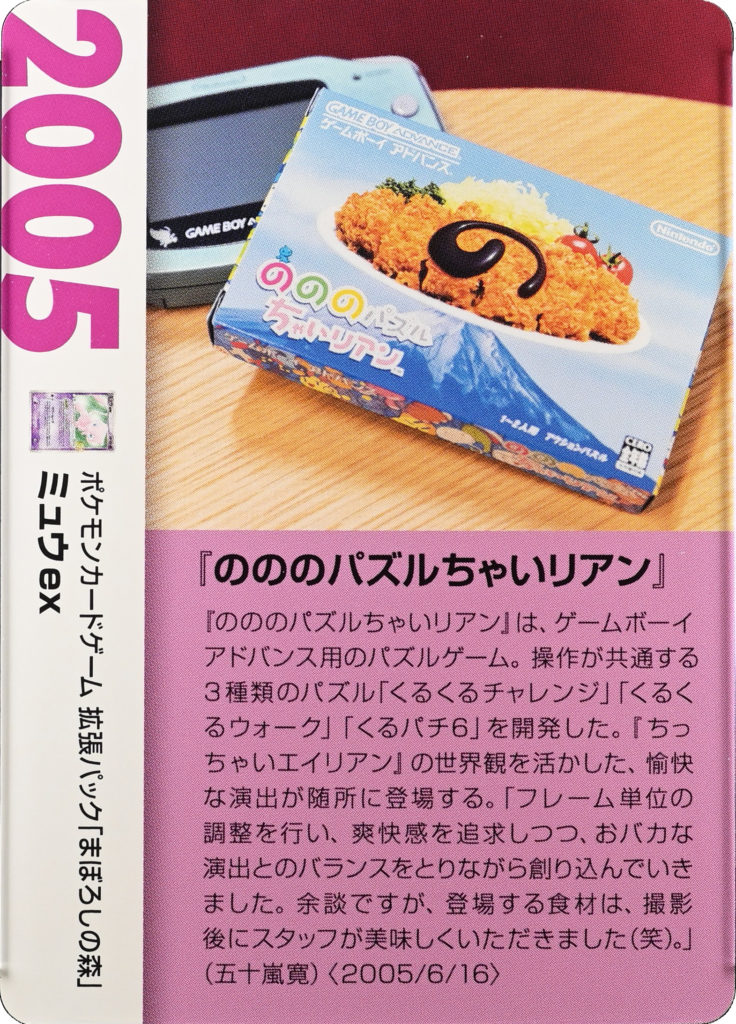
Mew ex was a very powerful card during its time. The card was featured two years in a row in the winning World Champion’s deck. In 2006, Jason Klaczynski (who was also the champion of the 2000 International Tropical Mega Battle) won the masters division (ages 16+) world championships with his “Mewtrick” deck, which revolved around using Manetric ex and Mew ex to lock the opponent out of playing trainer cards.
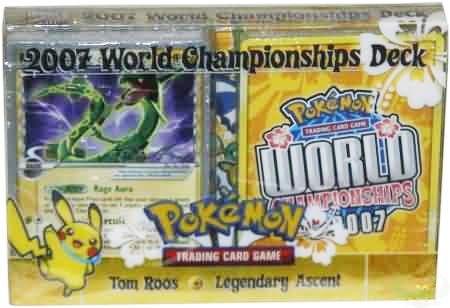
Mew ex was again included in the winning deck of the 2007 masters division world champion, Tom Roos. Roos’s deck was actually mainly based around cards like Absol ex to manipulate damage counters and score quick KOs, but it included 2 copies of Mew ex as a powerful support card that could use attacks of any other Pokemon in the deck.
The back of the card highlights a GBA game, Nonono Puzzle Chalien. It’s a puzzle game that features some of the Chaliens (a species of alien), from the Chee-Chai Alien game for the Game Boy Color that Creatures had previously made.
The game featured 3 game modes:
- Kurukuru Challenge (actually called Kurukuru Range in game): This mode is set in a microwave. Using a four-by-four grid, the player must press the A button to rotate cooking ingredients. When the player rotates all cooking ingredients into a hole the round is complete after the microwave pings off.
- Kurukuru Walk: Kurukuru Walk is a minigame starring the Chalien “Walker” (Japanese: ウォーカ). Controlling a four-by-four grid, the player must rotate tiles for Walker to walk on. There are two modes, ‘Endless’ (Japanese: エンドレス) and ‘Merekuri’ (Japanese: めれくり).
- Kurupachi 6: Kurupachi 6 is a minigame in which the player must control a four-by-four grid to make a row or column of panels that matches the number indicated on the panel. This causes the panels to change to the number +1 the number of panels aligned, for example, three ‘3’ panels will change to ‘4’ panels. If the player aligns six ‘6’ panels it will cause them to disappear and possibly cause a chain.
2006: Fighting Energy (EX Holon Phantoms)
2006’s featured card is a Fighting Energy from “EX Holon Phantoms” (known in Japan as “Holon’s Illusion”).
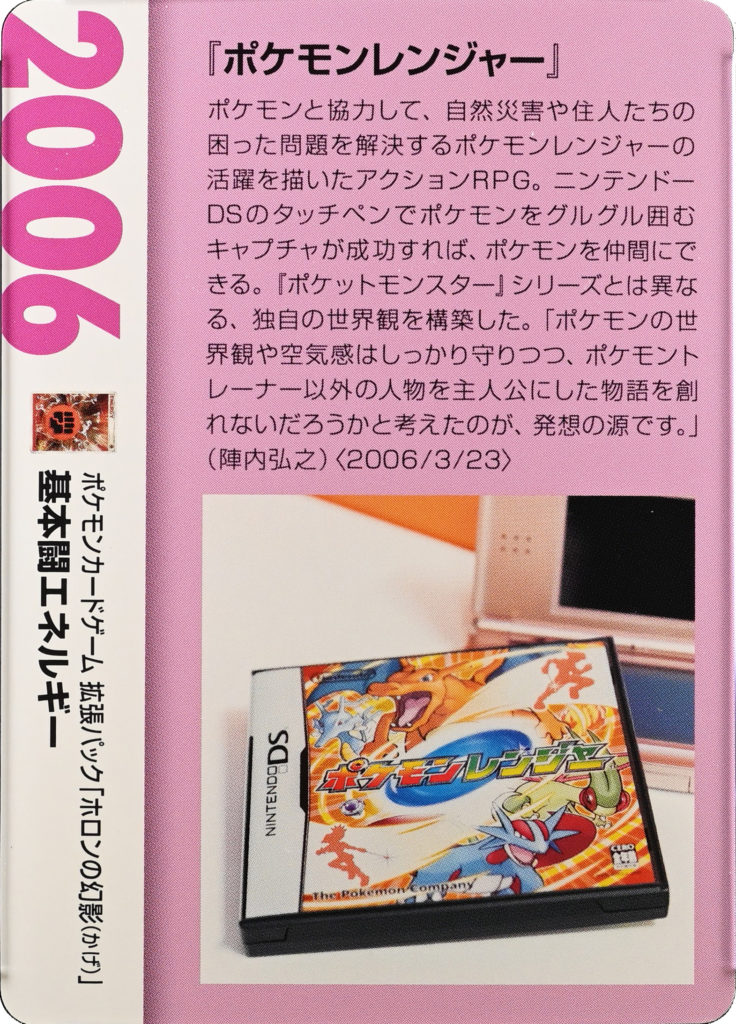
The back of the card featured information on the Pokemon Ranger Nintendo DS game, along with a quote from Creatures producer Hiroyuki Jinnai. This game was an action RPG that had the player play as a Pokemon Ranger rather than a Pokemon Trainer. Unlike Pokemon Trainers, Pokemon Rangers didn’t focus on capturing many different Pokemon, and instead had a single powerful “partner” Pokemon with them on their adventures.
The game utilized the DS’s stylus for a mechanic called the “Capture Styler”. By circling the Pokemon on screen, the Capture Styler would transmit “friendship” to the wild Pokemon, making them more likely to help the Ranger in its adventures. The Pokemon Ranger game was a commercial success, and prompted follow up games such as Pokémon Ranger: Shadows of Almia and Pokémon Ranger: Guardian Signs.
2007: Charmander (EX Power Keepers)
2007’s featured card is Charmander from the English “EX Power Keepers” set. In Japan, the set was known as “World Champions Pack”, and it was a special set released during the Diamond Pearl era of the game.
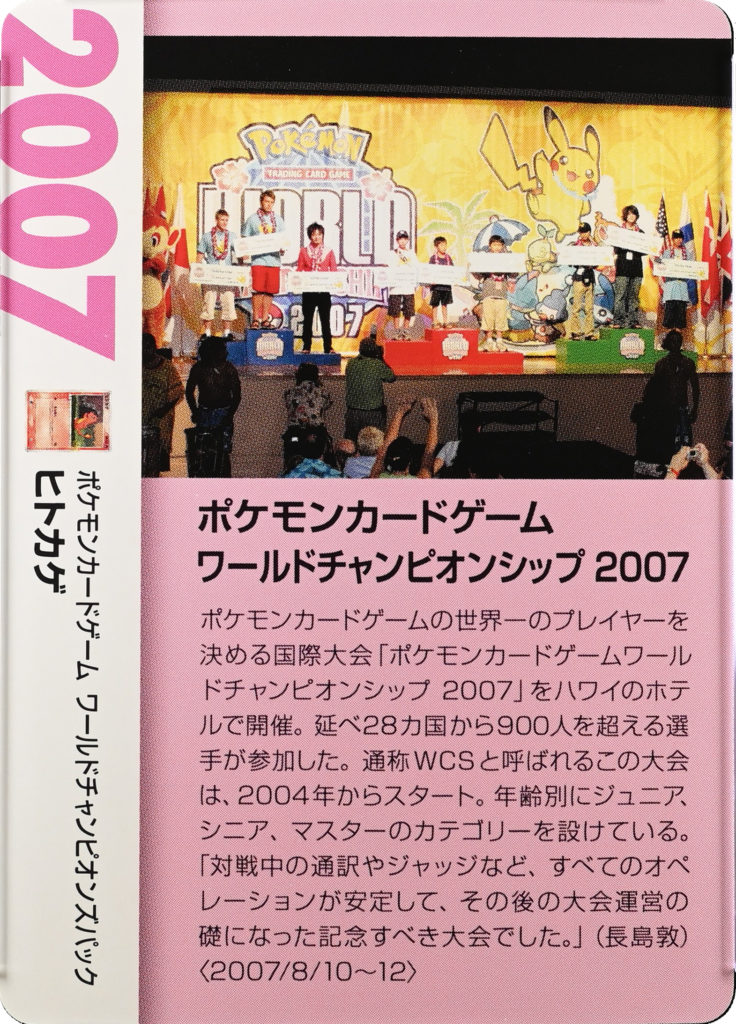
The English EX Power Keepers was released on February 14, 2007, while the Japanese special set was released on July 5, 2007. The Japanese set also included reprints of cards like the Gold Star Eevee evolutions from the Pokemon Players Club.
The special set was first available in first edition through the Pokémon Card Game website and at Summer Battle Road 2007 venues. It was intended for Japanese players so they would not be at a disadvantage at the 2007 World Championships. Japanese players could order their packs online from June 15 until July 1. Packs were released from July 5 onward to those who had ordered them.
Non-first edition World Champions Pack (also known as unlimited WCP) packs were available in-person at the Spring Battle Road 2008 venues.
Due to a bomb threat, 3 out of 5 tournaments were cancelled, making the unlimited WCP versions of the cards much more rare than their 1st edition counterparts. It’s also possible that the packs were only available to competitors to purchase at these venues, adding onto their scarcity.
Fittingly, the back of this card highlights the 2007 World Championships, while also expanding on how the competition solidified Ishihara’s original dreams of making an international tournament for the Pokemon TCG.
2008: Uxie (Legends Awakened)
2008’s featured card is Uxie from the English “Legends Awakened” expansion, known in Japan as “Cry from the Mysterious”.
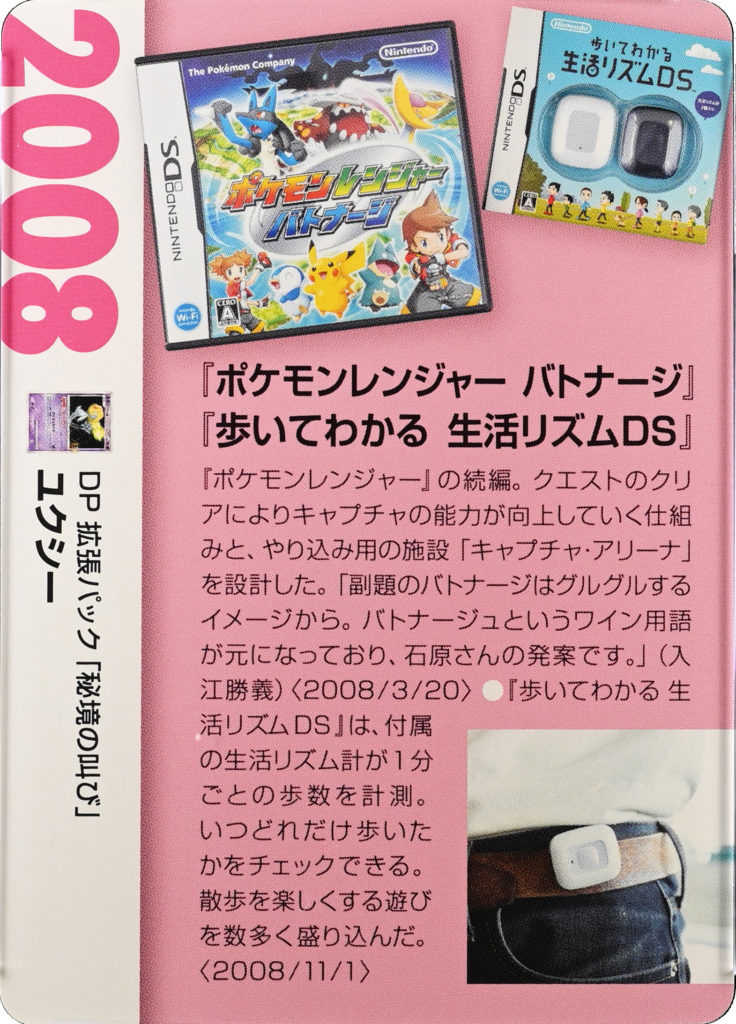
Uxie (and its accompanying card, Uxie Lv.X) was one of the most powerful cards during its time. Its Poke-Power, “Set Up” gave many decks powerful draw ability on a single-prize Pokemon. Its attack used colorless energy to tuck Uxie back into the deck, which allowed players to re-use Uxie later in the game. It’s level-up, Uxie Lv.X, also gave players the option to keep Uxie on the field and continue to draw cards.
The back of this card featured history on the sequel to the Pokemon Ranger game, Pokemon Ranger: Shadows of Almia. The history blurb offered insight into the game’s some-what strange Japanese name, Pokemon Ranger Vatonage (ポケモンレンジャー バトナージ). It was apparently coined by Ishihara, inspired by the French term “Batonnage”, a winemaking term for stirring the lees during the aging and maturation of wine. This would enhance an aging wine with added richness, flavor and aroma complexity.
The back also touched on another quirky Creature game called Personal Trainer: Walking DS. This was an exercise game that shipped with 2 pedometers that synced with the Nintendo DS game. The game featured multiple minigames that utilized the pedometers, along with Mii avatars.
2009: Lightning Energy (HeartGold & SoulSilver)
2009’s featured card is yet another basic Lightning Energy cart, this time with a design from the English “HeartGold & SoulSilver” set. This was two sets in Japan: “HeartGold Collection” and “SoulSilver Collection.
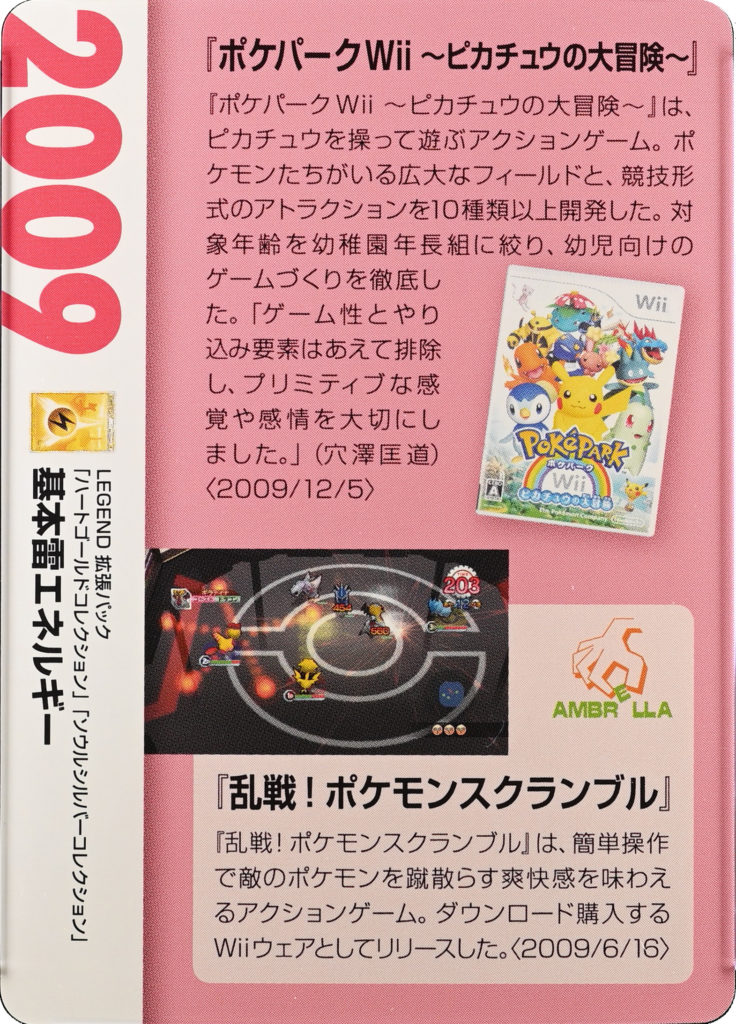
The basic energy cards from these sets included silhouettes of Pokemon in the background of their artworks. They would go on to be used as English promos for the Pokemon League’s rewards program with special crosshatch foiling.
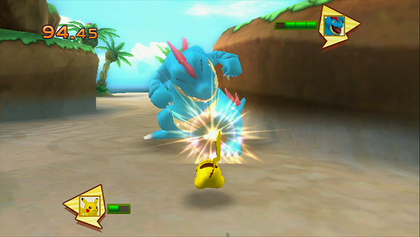
The back of the card highlighted two Creatures games. The first was PokePark Wii: Pikachu’s Adventure. This was a Nintendo Wii action game targeted at young children, and featured Pikachu being transported to the mythical PokePark along with its friends.
The second game was Pokemon Rumble, released in Japan under the name Melee! Pokemon Scramble. This was a downloadable WiiWare title, and was a simple action fighting game. A physical board game inspired by the games would also be released. Both the Japanese and international releases of the games would ship with a special set of Pokemon cards featuring the distinctive art from the games.
2010: Fighting Energy (Beginning Set – Snivy deck)
2010’s featured card is another Fighting Energy. This one was a reprint from the “Beginning set – Snivy” deck in Japan, and featured a Snivy stamp in the corner.
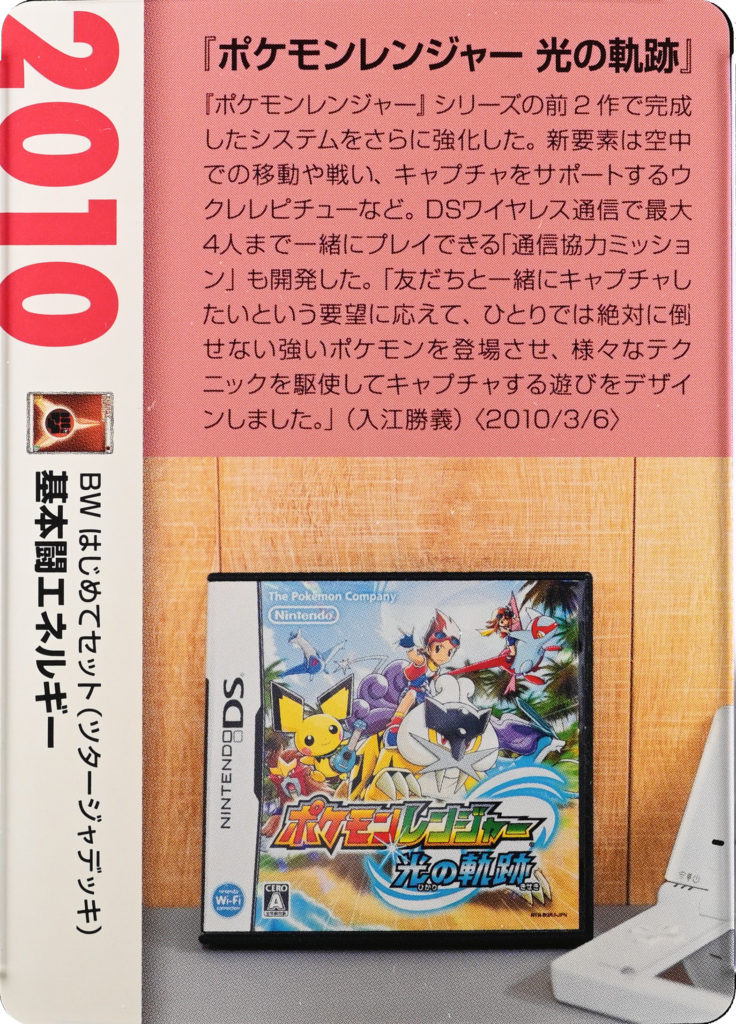
The Beginning Set was released in October 2010, and was actually 2 products: one for boys, and one for girls. The sets each included 3 half decks, themed after the Gen 5 Black & White starters Tepig, Snivy, and Oshawott. Decks for both the girls and boy sets were identical, but the sets featured different packaging meant to cater to each audience. The decks were targeted at beginning players, and offered a full set of accessories (coins, playmats, etc.) and decks for two players to easily player against each other.
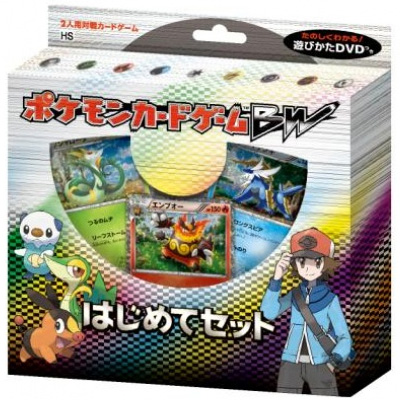
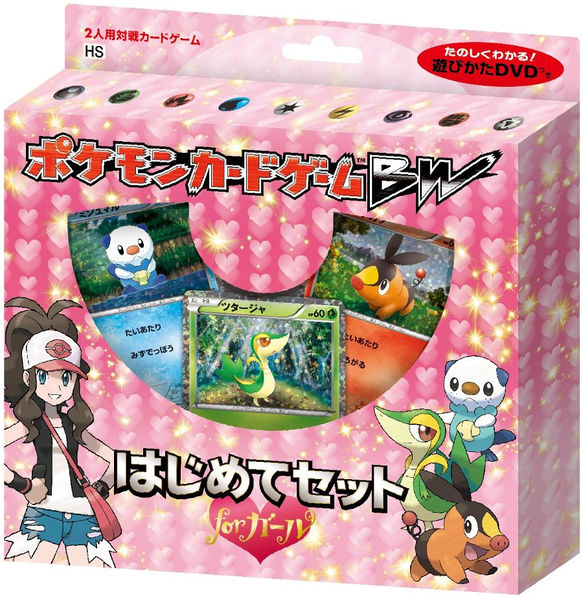
The back of the card features the third game in the Pokemon Ranger series developed by Creatures, Pokemon Ranger: Guardian Signs (released as Pokemon Ranger: Trail of Light in Japan). This game built on the systems created in the previous two games, and featured Pichu as the main character’s partner Pokemon. It also added cooperative multiplayer missions.
2011: Mewtwo EX (Next Destinies)
2011’s featured card is Mewtwo EX from the English “Next Destinies” set (known in Japan as “Psycho Drive”). This would not be the only Mewtwo EX card featured in the deck, as 2014 would also feature a Mega Mewtwo EX.
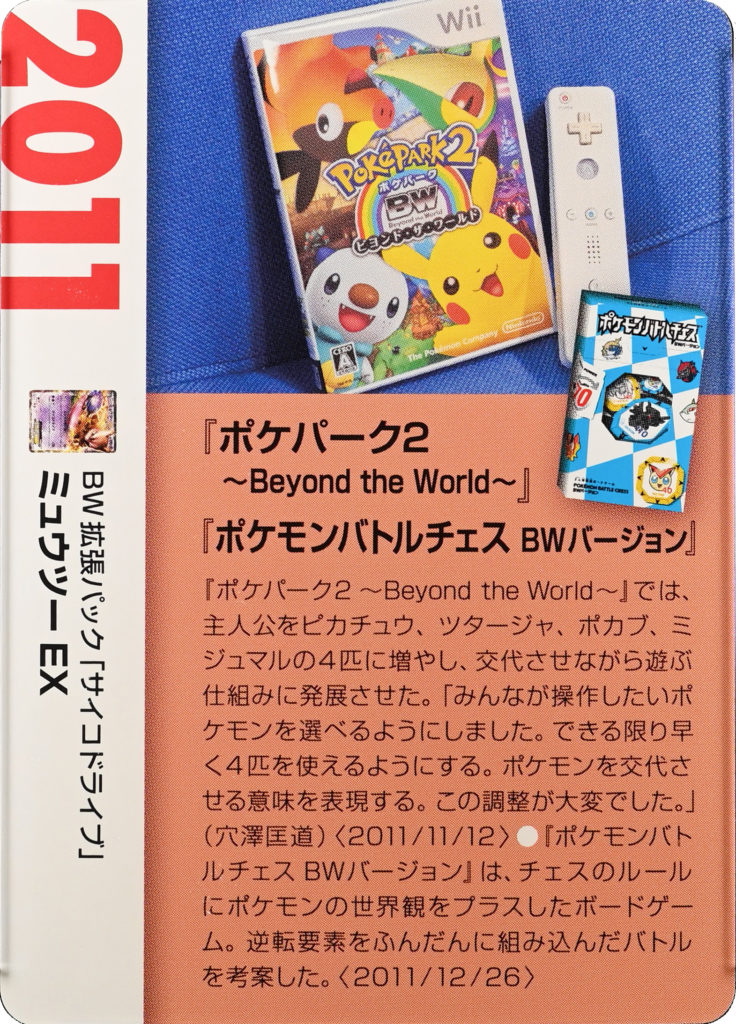
Mewtwo EX was a powerful presence during its time in the metagame. As a basic Pokemon, it had a massive 170 HP. Additionally, its first attack, “X Ball”, required only colorless energy to use, and punished decks that set up their Pokemon with any amount of energy cards.
This, coupled with the fact that it was also weakness also Psychic, meant that Mewtwo EX’s best counter was another Mewtwo EX. With the all-colorless energy requirement of “X Ball”, this meant that Mewtwo EX could fit into most decks in the metagame and be a viable threat.
The back side of the card featured 2 products. The first was the sequel to the first PokePark Wii: Pikachu’s Adventure game. This game was titled PokePark 2: Wonders Beyond for international release, while in Japan it was know as PokePark 2: Beyond the World (stylized to emphasize the “BW” for Black & White). This game added 3 new playable Pokemon (the BW starters Tepig, Snivy, and Oshawott) for quick cooperative play.
The other product featured was called “Pokemon Battle Chess BW version”. This was a Japanese-exclusive board game based on the game of chess, with some aspects of shogi, in which the traditional chess pieces are replaced with Pokémon. A follow up game “Pokémon Battle Chess W” was released that also included a web-playable version, but after that the games were discontinued.
2012: Blend Energy GFPD (Dragons Exalted)
2021’s featured card is yet another special energy card, Blend Energy (Grass, Fire, Psychic, Dark) from the English “Dragons Exalted” set. This set was released in Japan as 2 smaller sets: “Dragon Blast” and “Dragon Blade”.
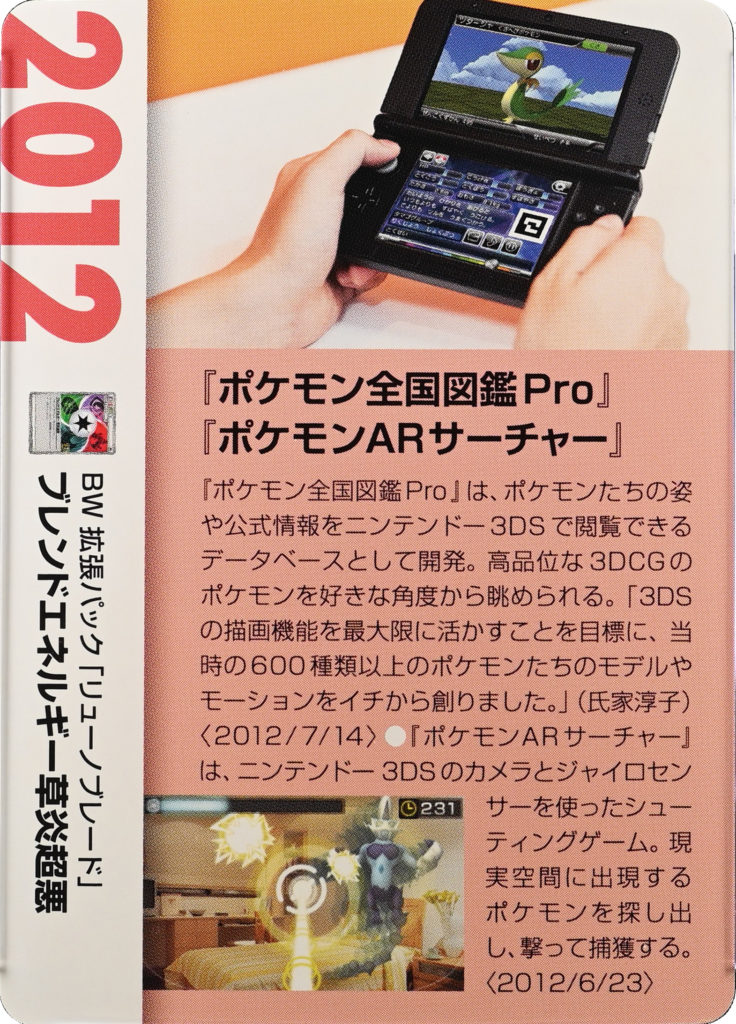
Blend Energy was a frequently-used supporting energy during the time it was legal. It allowed easy “splashing” of off-type Pokemon for little downside. One such deck from the time was Hydreigon / Darkrai EX. The deck was mostly dark-based, but Blend Energy let the deck also use attacks from grass-type Shaymin EX and the Psychic Mewtwo EX (the very same one that was also printed in the Corporate History deck as 2011’s featured card).
The back of the card featured two 3DS applications. The first was “Pokedex 3D Pro” (known in Japan as “Pokemon National Encyclopedia Pro”). This 3DS utility application showed every Pokémon as well as their different forms up to Gen 5. The app also had a Quiz to test how much you know about Pokémon.
The app was actually an upgrade / sequel to another 3DS app called “Pokedex 3D’. When “Pokedex 3D Pro” came out, the original “Pokedex 3D” app became unavailable on the Nintendo 3DS shop. The updated app added a voice that called out the name of every Pokémon.
The second 3DS application was “Pokemon Dream Radar”. In Japan, this was known as Pokemon AR Searcher (ポケモンARサーチャー). This was a companion app to the Gen 5 games, and utilized the 3DS’s camera and gyro sensors to place 3D models of Pokemon overlaid on top of the real world.
Within the game, players could catch Pokemon through motion-based gameplay. Any caught Pokémon or items could be transferred to Pokémon Black Version 2 and Pokémon White Version 2. Pokémon captured via the game might have hidden abilities not available otherwise, and some items that couldn’t normally be found in-game.
2013: Double Colorless Energy (XY)
2013’s featured card is a Double Colorless Energy print from the English “XY” expansion. This was made of two Japanese sub sets, “Collection X” and “Collection Y”. They were the first sets of the XY era for the TCG. The Double Colorless Energy was reprinted in Collection Y
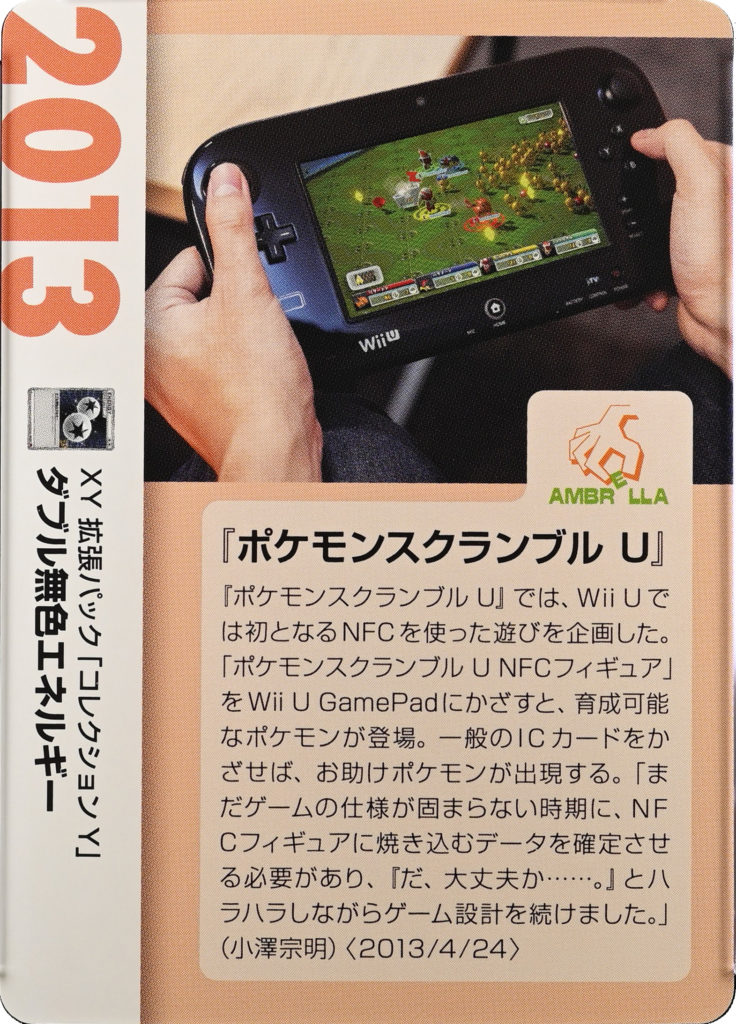
Double Colorless Energy is one of the few cards from the original Pokemon Base Set to have remained essentially unchanged from its original effect. Its effect of providing 2 energy instead of 1 allowed Pokemon to jump the intended power curve for their attacks, enabling them to attack with energy-intensive moves a turn earlier. It has been featured in tournament-winning decks all the way from the 1st Official Pokemon Card Game tournament to present day, and will likely to continue to be competitively relevant in the future.
The back of the card featured the Wii U game, Pokemon Rumble U. This was released in Japan as Pokemon Scramble U (ポケモンスクランブルU). This was the first Wii U game to utilize the Wii U GamePad’s NFC function. Players would control Pokemon and battle alongside others in real-time battle arenas. Figurines with NFC chips in them could be used to add content into the game, such as new Pokemon and helper items.
2014: Lightning Energy (XY Promotional Card Pack 1)
2014’s featured card is another basic Lightning Energy, this time from the first XY Promotional card pack. This is the only card in the deck from an actual “promo” set, with an XY-P numbering.

The original printing of this Lightning Energy was available from the “XY Promotional Card Pack 1”. These packs were given away to participants in local card shop events as park of the Pokemon Gym program, which a localized casual tournament circuit. These events were often feeders for larger tournaments such as the regional and national ones in Japan.
The packaging was opaque foil, and contained a single card. There was a small list of cards that could be pulled from each pack series, and the packs were available for a few months before rotating to the next series. “XY Promotional Card Pack 1” was available from February to April 2014, and contained 12 cards, each with the Pokemon Gym stamp (besides the energies).
The back of the card featured Creature’s first mobile app, a music app called “aDanza” that was only released in Japan. Users could select a song for 3DCG alpacas, penguins, sumo wrestlers, and more to dance to. Initially, only songs officially purchased from the iTunes store were available to use, but later users were able to use any of their own music. The app would automatically take the song and create a music video featuring the the 3DCG characters.
2015: M Mewtwo EX (BREAKthrough)
2015’s featured card is yet another Mewtwo card: Mega Mewtwo EX from the English “BREAKthrough” expansion. This expansion was pieced together from two Japanese sets, “Red Flash” and “Blue Shock”.
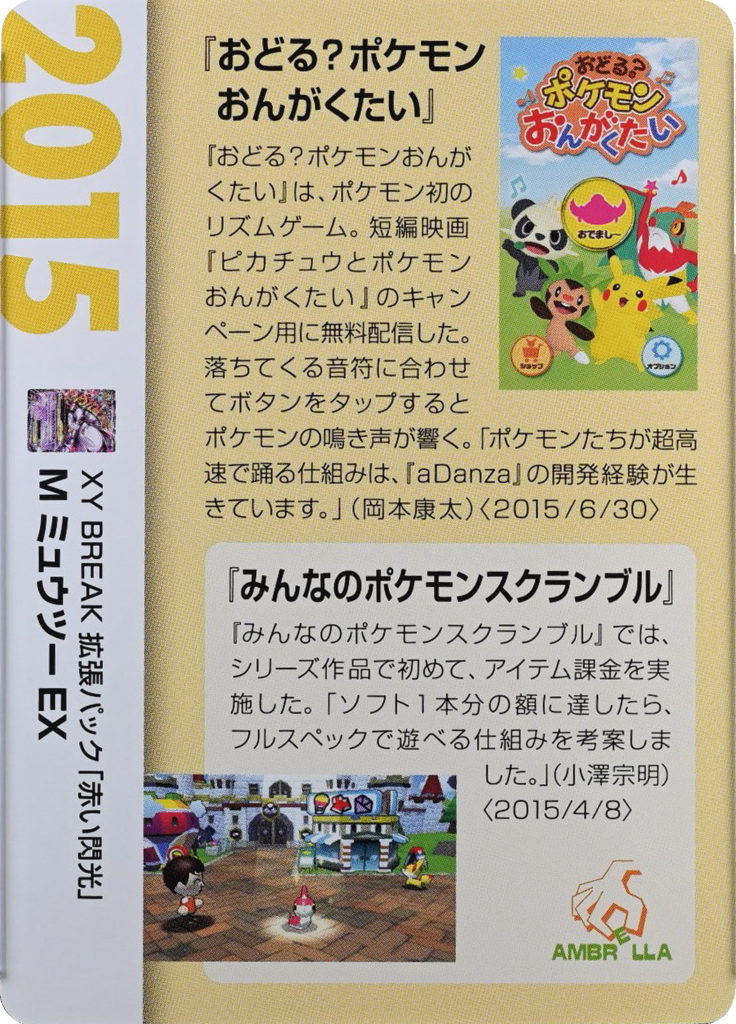
Mega Mewtwo EX was not nearly as ubiquitous as its pre-Mega form, but still saw play in a few decks during its time.
Its attack, “Psychic Infinity” was very similar to the regular Mewtwo EX’s “X Ball” in that it scaled in damage with the number of energy cards attacked to both Pokemon. However, since it required a prior Pokemon to evolve from, it didn’t seem the same widespread play. Additionally, the attack was not affected by weaknesses, probably to avoid the same Mewtwo EX mirror match issue.
The back of this card featured two free-to-play games. The first was an iOS / Android mobile game called Dance? Pokemon Band. This was a rhythm game where the player tapped the screen in accordance to a beat, and 3D Pokemon models would dance along. Creatures used technology they used to build their “aDanza” app in the creation of this app. Dance? Pokemon Band was taken off the app stores on October 29, 2015, just 4 months after it had launched.
The second free-to-play game was a 3DS game that was available via the Nintendo 3DS eShop, called Pokemon Rumble World (known in Japan as Everyone’s Pokemon Scramble). This game was yet another title co-developed with Ambrella. It was a top-down action game that tasked the player with collecting all 719 Pokemon in the title.
It was later released as a physical box product in 2016, with the microtransaction features fully unlocked.

Creatures intended for players who spent roughly the retail price of the game in microtransactions to have a fully-featured game. Therefore, if players bought 3,000 “Poke Diamonds” (roughly around $30 USD, the retail price of a 3DS game), they would no longer be able to purchase more Poke Diamonds, and would instead gain access to a “Diamond Mine” that generated 40 Poke Diamonds per day.
2016: Professor Oak’s Hint (Evolutions)
2016’s featured card is Professor Oak’s Hint. This year was the 20th anniversary of the Pokemon franchise, and with it came a set that featured many of the original art from the Base Set, known internationally as “Evolutions”. In Japan, this special set was known as the “Pokemon TCG 20th Anniversary” concept pack.
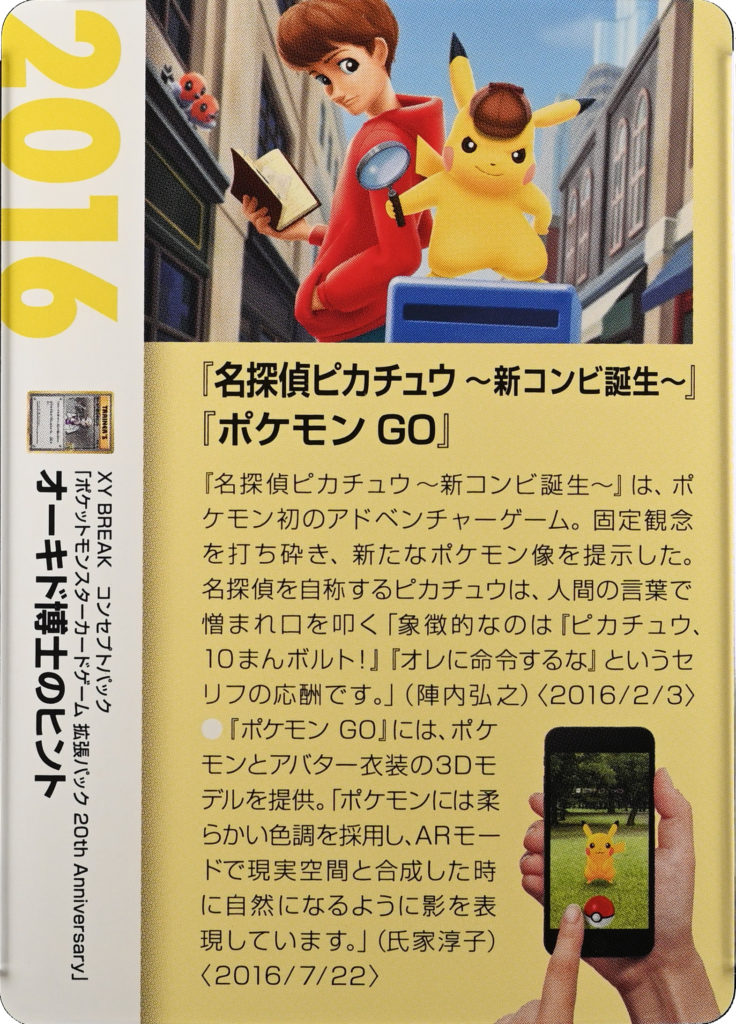
Professor Oak’s Hint is a reference to the original Professor Oak trainer card from the Base Set. It, along with Base Set’s Bill, were included in nearly every deck due to their ability to refill hands at essentially no cost. Professor Oak’s Hint is a much less powerful version, drawing fewer cards, being limited via its Supporter subtype, and ending the turn immediately upon use.
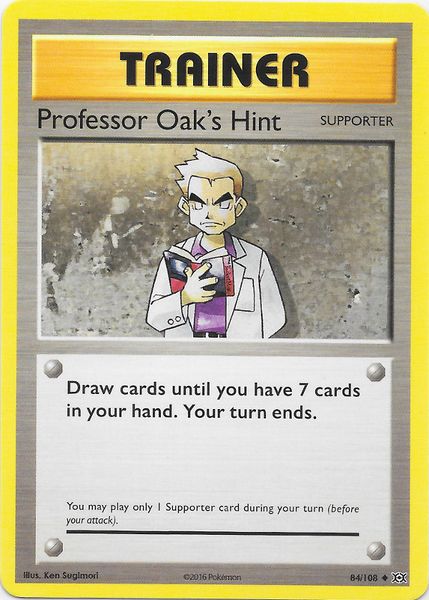
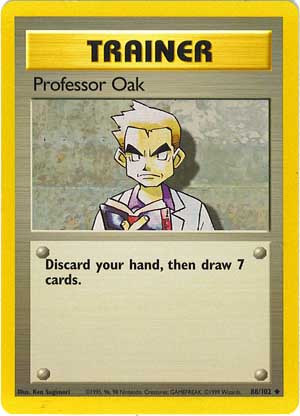
The back of the card featured two games. The first was a eShop game called Detective Pikachu: Birth of a New Duo. This game featured a Pikachu who spoke human language, and was delivered via an episodic story structure. The success of this title would later lead to a full game being released, as well as a full-length motion picture.
The second game was Pokemon Go. This was an augmented reality (AR) iOS / Android mobile game developed together with Niantic that immediately took the world by storm. In Pokemon GO, the player could catch Pokemon around them by visiting and walking around real-world locations. By the end of its 2016 release year, it had been downloaded over 500 million times, and in 2020, grossed a total of $6 billion USD in revenue. It remains one of the most profitable mobile games of all time.

2017: Tapu Lele GX (Guardians Rising)
2017’s featured card is Tapu Lele GX, from the English “Guardians Rising” expansion. In Japan, it was part of the “Alolan Moonlight” set, which would combine with the “Islands Await You” set to form the English “Guardians Rising” expansion.
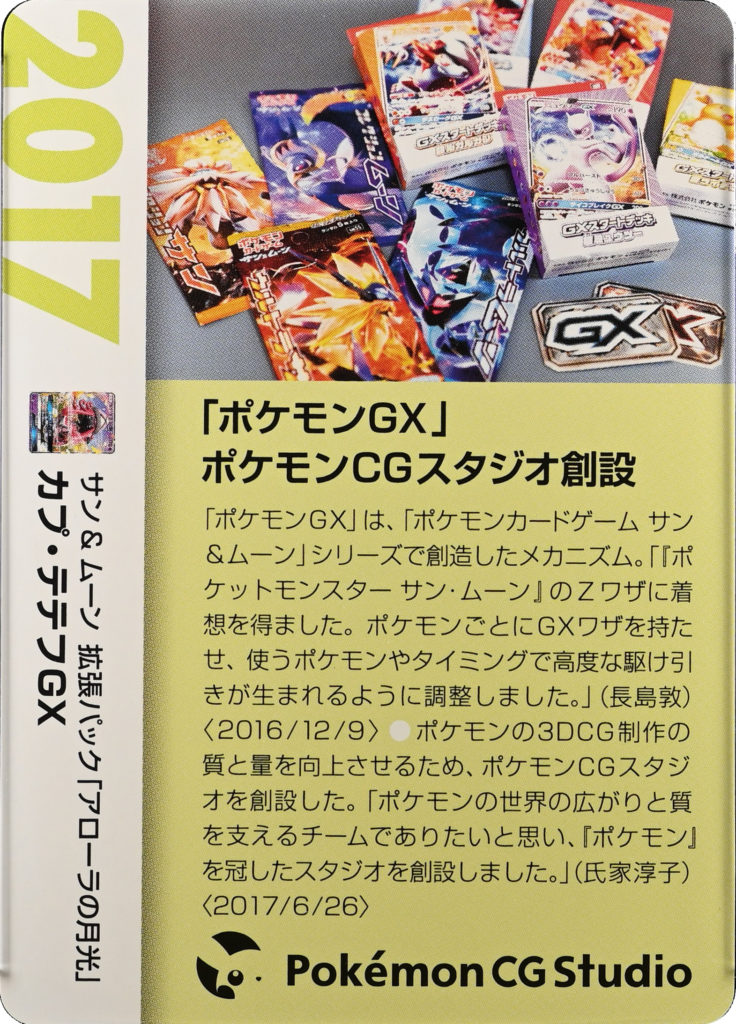
Tapu Lele was a dominant card from the moment it was printed. Its ability, “Wonder Tag” added consistency and flexibility to any deck by allowing the player to find any Supporter card in their deck.
Additionally, its “Energy Drive” attack is very similar to the Mewtwo EX also featured in the deck. The attack scales off energy cards attached to both Pokemon, and it only uses colorless energy. This means that Tapu Lele could (and did) fit into almost every deck. Basically every deck in the metagame ran at least 1- 2 copies of the card.
Unlike Mewtwo EX’s “X Ball” attack, Tapu Lele’s “Energy Drive” was not affected by weakness or resistances, meaning that mirror matches were a little less prevalent, since players didn’t have to run more Tapu Leles just to counter opponents’ copies. Tapu Lele itself also just didn’t have a weakness at all.
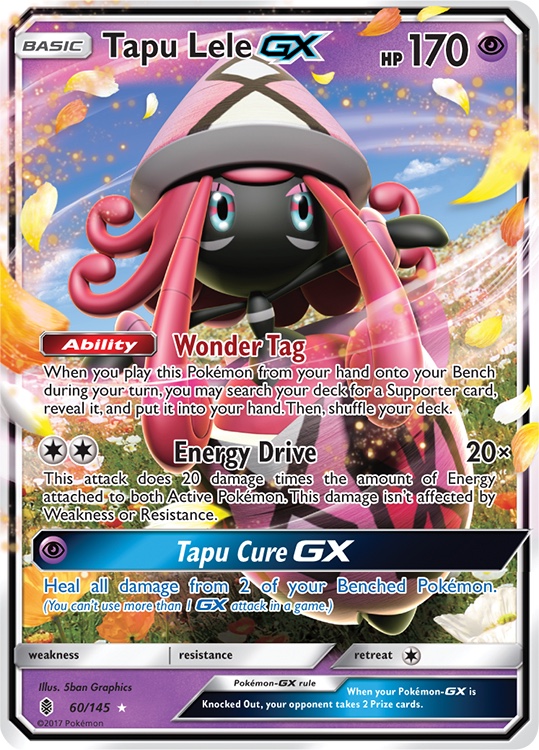
The back of the card featured the origin of the TCG’s GX Pokemon, with the TCG’s Game Director explaining that they were inspired by the Z-moves of the Sun & Moon video games. Additionally, it touched on the founding of the Pokemon CG Studio, a division of Creatures solely focused on 3D computer graphics for Pokemon. Gamefreak would create the 2D concept art for Pokemon, while Pokemon CG Studio would realize them in 3D.
2018: Pikachu & Zekrom GX
2018’s featured card is Pikachu & Zekrom GX from the English “Team Up” expansion, released in Japan as “Tag Bolt”.
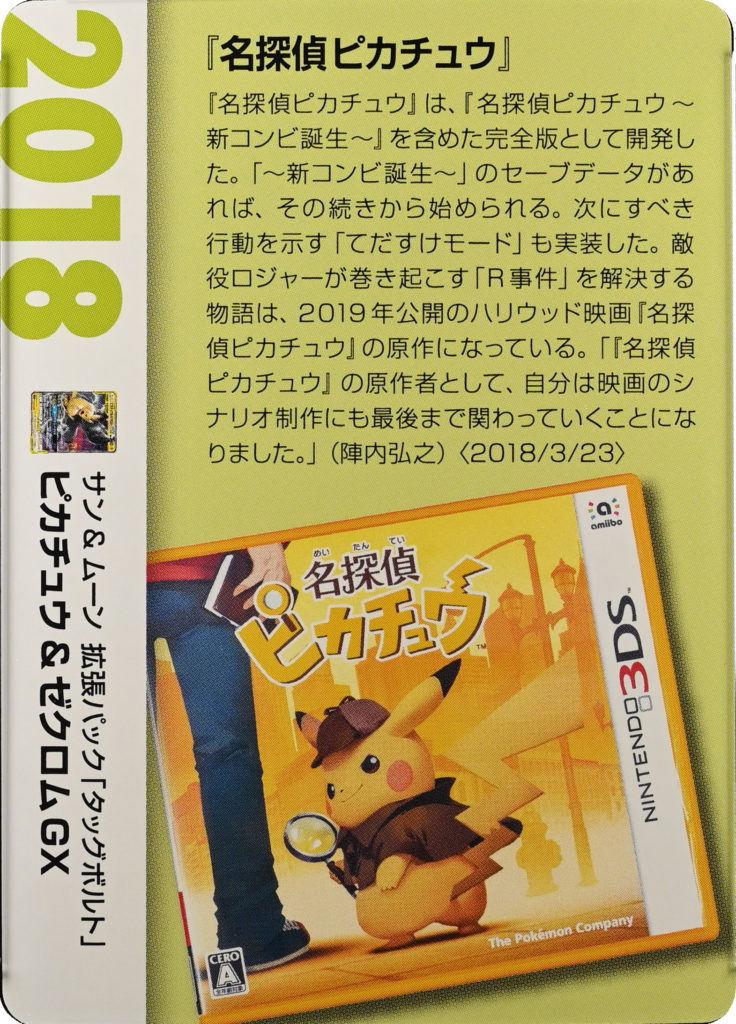
This card was the namesake of the “PikaRom” decks during the time it was legal. PikaRom utilized cards like Bolthund V and Pikachu & Zekrom GX to rapidly search and attach Lightning Energy to its powerful attackers.
The deck was able to compete quite evenly with even the dominant decks of later metagame years such as ADP-Z, and had a favorable matchup against many of the other prevalent metagame decks due to how consistent it was.
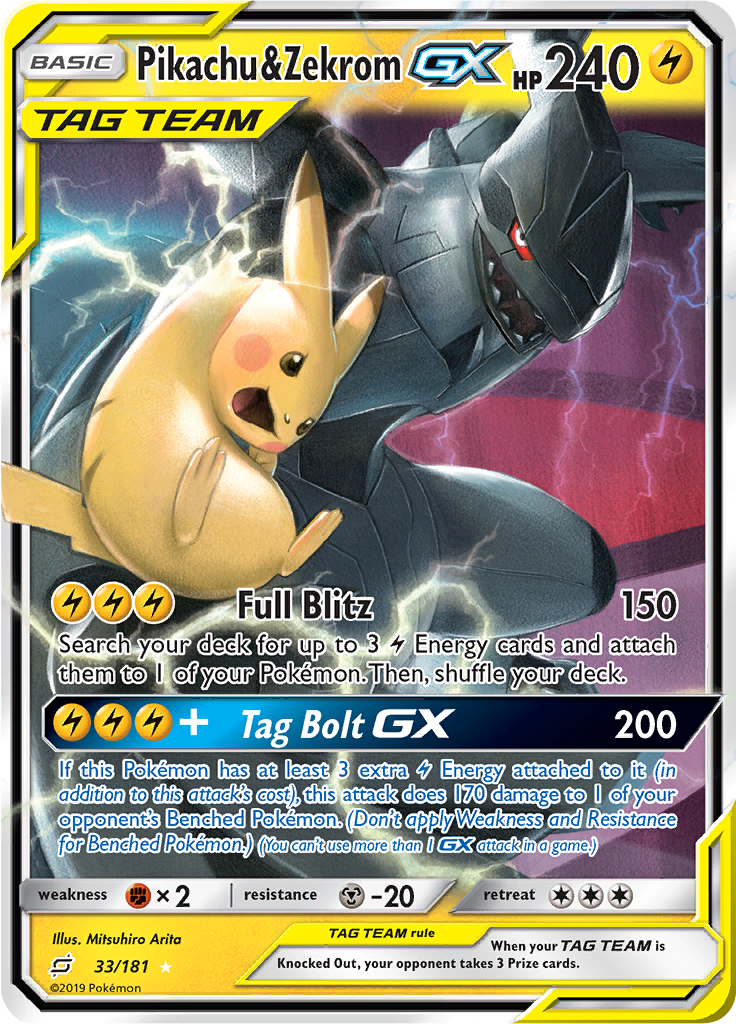
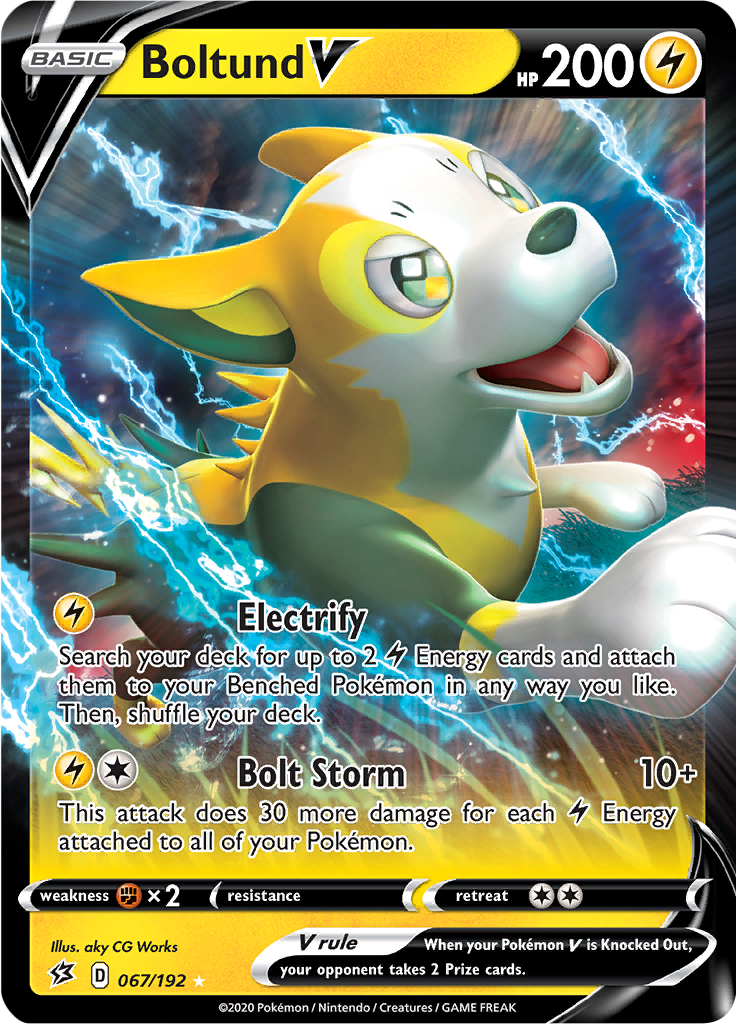
The back of this card highlighted the Detective Pikachu 3DS game. This game was a compilation of the episodic story from the previously released Detective Pikachu: Birth of a New Duo eShop title from Japan, along with additional new chapters. Players who had save data from the original game would be able to pick up where they left off in the game to continue the story.
Since the eShop game was never released internationally, the 3DS game was the first time the story had been released overseas.
2019: Aurora Energy (Sword & Shield)
2019’s featured card is Aurora Energy from the English “Sword & Shield” set, the first set of Generation 8 Pokemon in the TCG. In Japan, this card was printed in the “Shield” set, which was combined with the “Sword” set to make the English set.
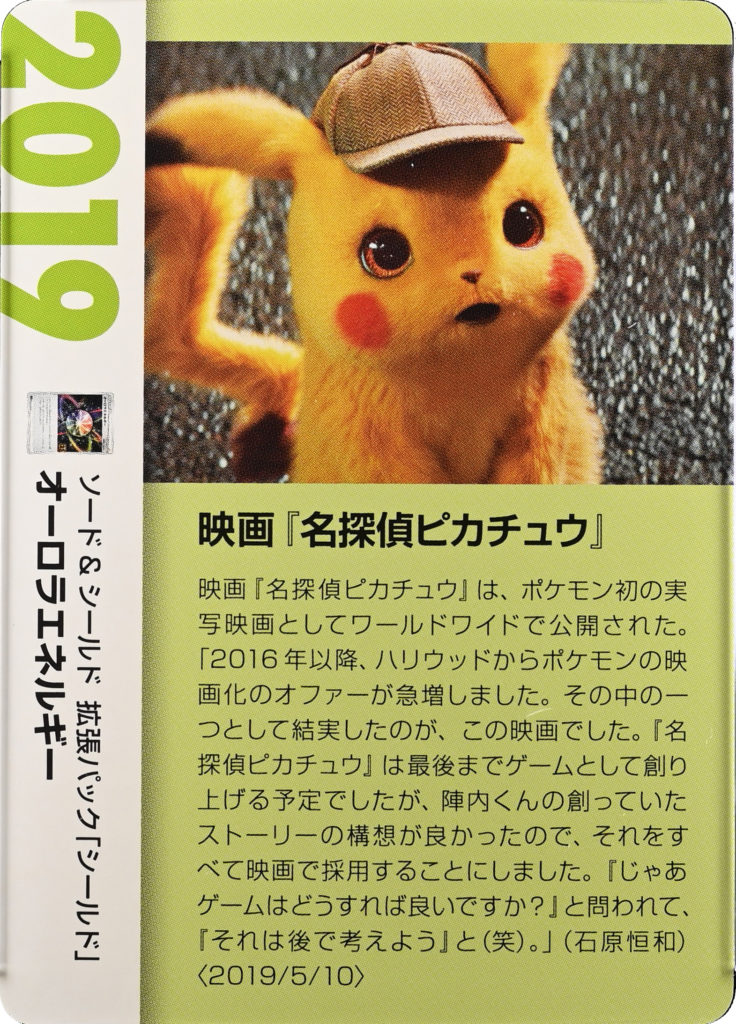
Aurora Energy saw play in many decks due to its ability to both provide all energy types, but also to get cards from hand into the discard pile. One such application of this was in the “ADP-Z” (Arceus Dialga Palkia Zacian) decks that dominated much of the Sword & Shield TCG era metagame until the Tag Team Pokemon had rotated out. Aurora Energy would provide Water / Steel energy while also discarding another Steel energy to be attached from the discard to Steel attackers like Zacian V. This allowed the ADP-Z player attach 2 energies in the same turn.
The back of this card highlighted the Detective Pikachu movie, released in theaters worldwide in 2019. The film was Pokemon’s first live action movie, and starred actor Ryan Reynolds as the voice of Detective Pikachu. Reynolds also performed the facial motion capture for Pikachu. The movie released to mixed reviews due to its somewhat messy plot, though many praised the visuals. A sequel was initially planned, but as of 2021 is now on hiatus or cancelled entirely.
2020: Marnie (Shiny Star V)
2020’s card is a full art Marnie print from the Japanese “Shiny Star V” set. This was a reprint set that featured premium prints of cards from other recent sets, an was only released in Japan. The card was eventually released in English as a S-P promo in the “Marnie Premium Tournament Collection Box”.
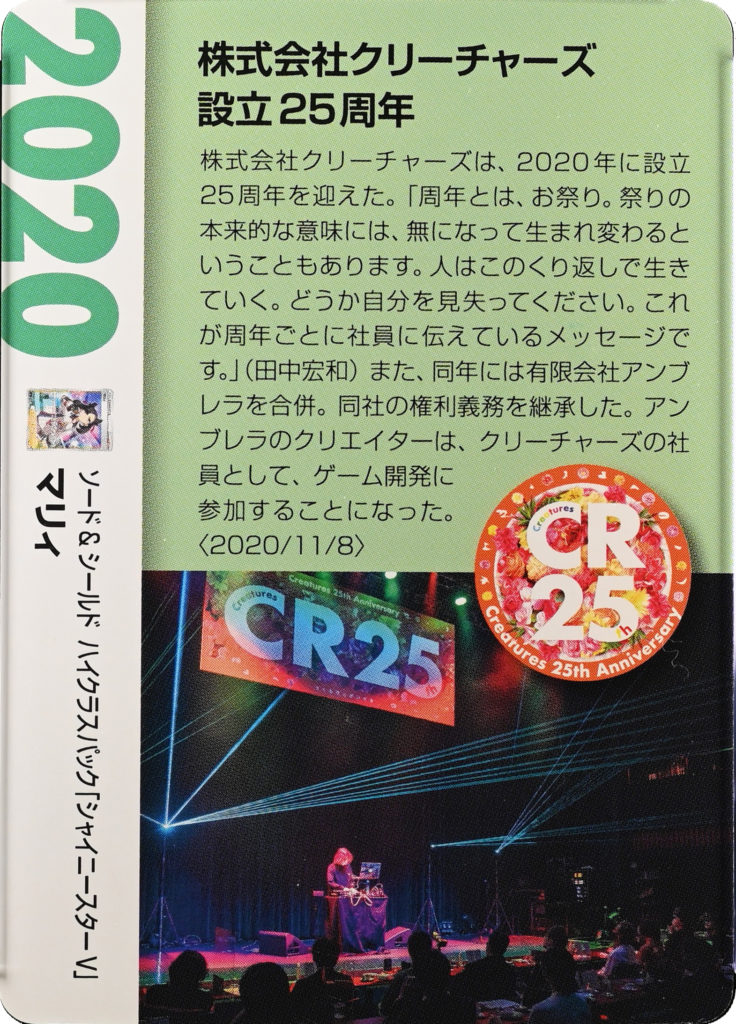
Marnie was both a tournament staple and a fan-favorite character. Her trainer card allowed players to both refuel their hands, and disrupt the opponent’s hand by shuffling them back in.
A majority of the metagame’s tournament decks would run at least a few Marnies, and there was a lot of strategy around not leaving yourself vulnerable to getting “Marnie’d”.
Marnie’s character design was incredibly popular in Japan. The full art “Shiny Star V” print remains the most expensive card in the set. That art is the one used for the corporate history deck’s print.
The back of this card celebrates Creatures Inc.’s 25th anniversary, with a few remarks from Hirokazu Tanaka, the president of Creatures Inc. He compares an anniversary to a Japanese festival (Omatsuri お祭り), and comments on how the word originally has roots in death and rebirth. The kanji, 祭, has roots in Chinese in meaning of “offering sacrifice” and “memorial”.
2020 was also the year that Creatures Inc. completed its acquisition of longtime development partner, Ambrella. The game studio had worked nearly exclusively on Pokemon spinoff games like Pokemon Rumble, Hey You! PIkachu, and Pokemon Channel. All employees of Ambrella became Creatures Inc. employees due to the merger.
2021: Rapid Strike Urshifu V (Battle Styles)
2021’s featured card is Rapid Strike Urshifu V from the English “Battle Styles” expansion. In Japan, it was part of the “Rapid Strike Master” set, which would be combined with the “Single Strike Master” set to form the English set. As the set was released in 2021, this was the final card in the deck to represent a year.
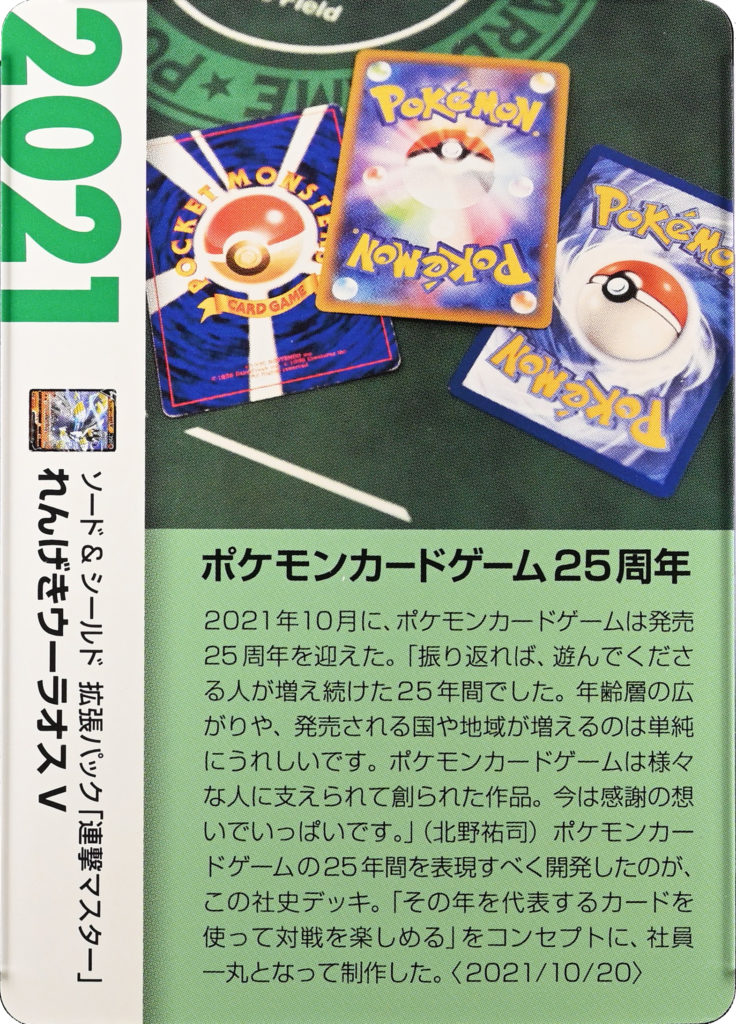
Rapid Strike Pokemon were introduced in the “Battle Styles” set alongside Single Strike Pokemon. Single Strike cards deliver powerful, hard-hitting attacks that can Knock Out an opposing Pokemon in a single blow. Rapid Strike cards use sneaky, and technical attacks.
Rapid Strike Urshifu V and its evolution, Rapid Strike Urshifu VMax formed the core of the strongest Rapid Strike deck in the metagame, and one of the top decks overall during its legality. Due to the pandemic, the deck didn’t get a chance to shine on a World Championships stage, but it won many online tournaments. It utilized Rapid Strike Urshifu V’s “Strafe” attack to safely hide away its main attacker until it evolved into its VMax form, and then was able to hit for huge damage to both the active and bench.
The back of the card featured a short message of gratitude from Pokemon TCG Senior Executive Director Yuji Kitano, and a final short origin story of why the corporate history deck was created.
Special Interview Cards: Poke Ball, Switch, and History Gate
The final 3 cards of the deck did not have years associated with them since those had all been covered. Instead, to make the half-deck an even 30 cards, Creatures included these 3 “bonus” cards. The back of each card contained some snippets of a special interview between Tsunekazu Ishihara and Hirokazu Tanaka, as well as a QR code to read the full interview on this webpage.
Each of these cards is numbered 011/008, which is a reference to Creatures Inc’s founding date, November 8, 1995.
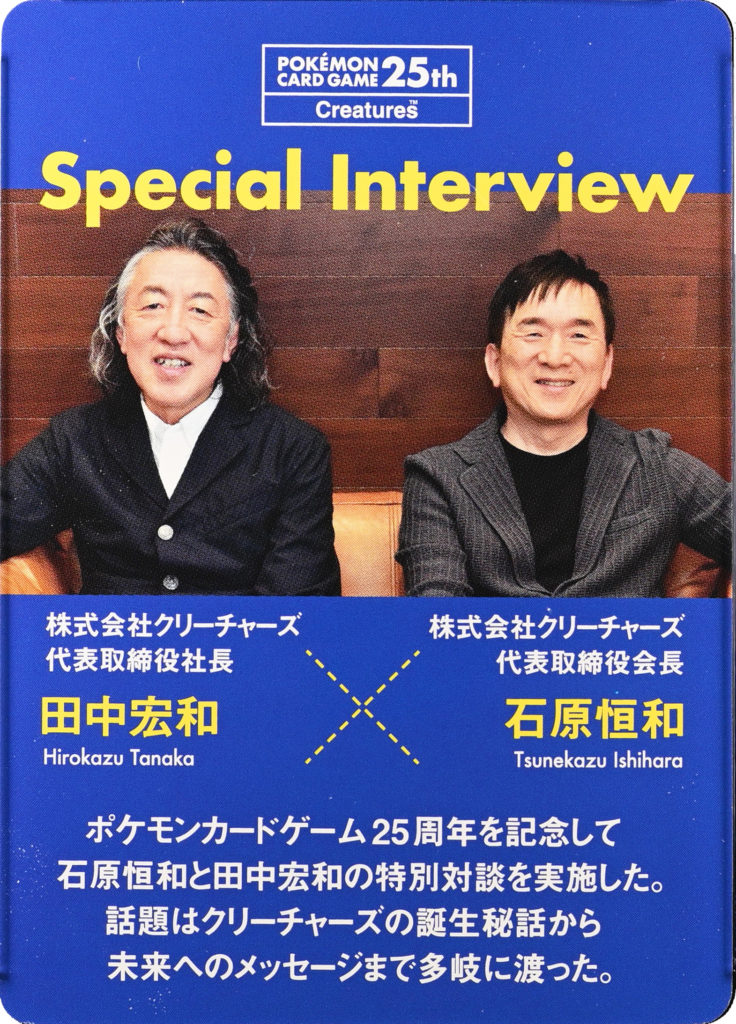
The first card is Poke Ball, which was originally printed in the Jungle set. The card has remained identical in functionality since it was first printed, and is an iconic symbol for the franchise. Competitively in the TCG, the Poke Ball card has never been consistent enough to see much play.
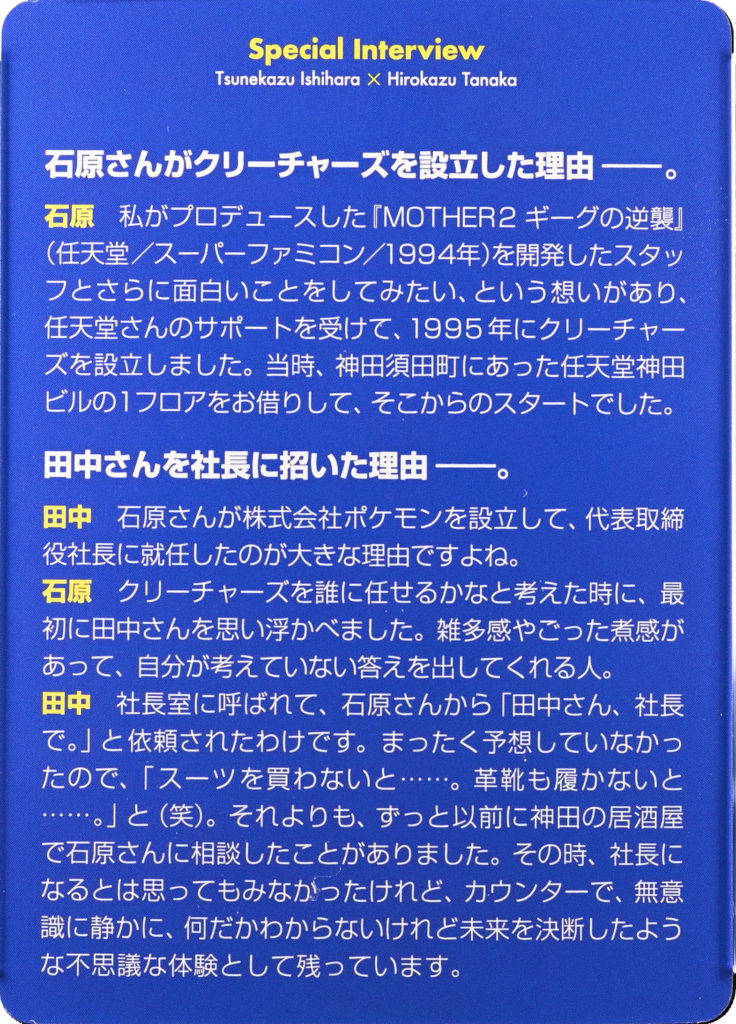
The second interview card is Switch. This trainer card also has not changed at all since its original printing in the original Base Set. Unlike Poke Ball, Switch has actually seen a decent amount of competitive play, as it allowed players to swap their stranded Active Pokemon out of difficult situations, and circumvents the single retreat per turn limit.
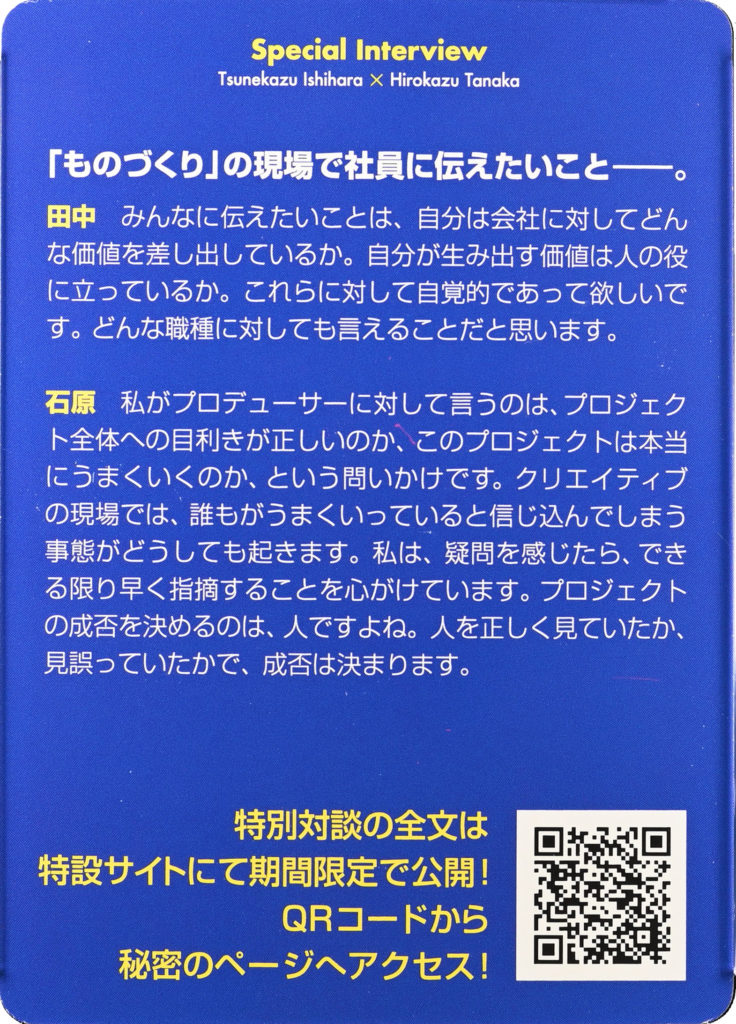
The third and final interview card is an exclusive card to the deck: History Gate. This stadium trainer’s ‘s effect reads as follows:
Each card in play that was released between 1996 and 2000 has its printed HP and attack damage doubled.
History Gate effect translation
Due to the “power creep”, or tendency for cards from newer sets to increase in power over older ones, many of the older cards were very underpowered compared to the more modern ones in the deck. History gate was meant to give all those cards a flat static boost in strength to bring them more in line with the newer cards.
Special Interview
As alluded to on the back of the 3 bonus cards, a special interview was conducted with Hirokazu Tanaka (President, Creatures Inc.) and Tsunekazu Ishihara (Chairman & CEO, Creatures Inc.). The full text of the interview is archived here, but here are the highlights of the talk between the two:
- The founding members of Creatures Inc. were brought together by Ishihara after working on Mother 2: Gig’s Countcverattack (this would be released as Earthbound internationally). Their first office was a single floor in Nintendo’s Kanda office.
- Ishihara invited Tanaka to become the President of Creatures since he realized that he would be unable to be the president of both Creatures and The Pokemon Company. Ishihara and Tanaka had gone out for drinks at an izakaya (a Japanese bar / tapas eatery), and from that conversation laid the seed for Tanaka’s succession.
- When asked what their most memorable creation from Creatures was, Tanaka said his was PokePark Wii because it was the first time that Pokemon had truly been 3D CG in an “open” world. Ishihara said his most memorable creation was the Pokemon TCG’s e-Series e-Reader technology.
- Some of their personal inspirations include the Mario, Zelda, Lord of the Rings, Star Trek, Dragon Quest, Star Wars, and Final Fantasy franchises.
- Ishihara was jokes that the Pokemon cards in the Corporate History Deck would be extremely expensive, so to “destroy” the value he put the company history on the reverse side (though this would obviously have the opposite effect).
Errors
Some of the cards printed in the Corporate History Deck have minor factual errors on their backs. It is likely due to the rush to get these out to market, these were missed in proofreading / editing.
2003: Pokemon Channel is called a N64 Game
The back of 2003’s card highlights the Pokemon Channel game developed by Ambrella, but mistakenly calls it a Nintendo 64 game, even thought the game was only ever released on the Nintendo GameCube.
2005: “Kurukuru Range” is called “Kurukuru Challenge”
The back of 2005’s card talks about the game modes available in the Nonono Puzzle Chalien game.
One of the game modes is mistakenly written as “くるくるチャレンジ”, which translates to “Kurukuru Challenge”. The actual game mode’s name is “くるくるレンジ”, which translates to “Kurukuru Range”.
This is a play on words, since there was food-based imagery in the game, and much of the game mode takes place inside a microwave oven. A range is “an electric or gas stove with several burners and one or more ovens”.
Sources
- http://izome.jp/
- https://recruit.creatures.co.jp/about/creatures_data/
- https://twitter.com/Sora_Sakurai/status/1475740518542110720
- https://www.famitsu.com/news/201903/14173198.html
- https://ja.wikipedia.org/wiki/%E3%83%9D%E3%82%B1%E3%83%A2%E3%83%B3%E3%81%88%E3%81%BB%E3%82%93
- https://en.wikipedia.org/wiki/Mini_4WD
- https://bulbapedia.bulbagarden.net/wiki/Beat_Up_(TCG)
- https://en.wikipedia.org/wiki/Chee-Chai_Alien
- https://bulbapedia.bulbagarden.net/wiki/List_of_TCG_cards_with_hidden_attacks
- https://bulbapedia.bulbagarden.net/wiki/Construction:_Action
- https://en.wikipedia.org/wiki/Pok%C3%A9mon_Channel
- https://ja.wikipedia.org/wiki/%E3%81%A8%E3%81%AE%E3%81%95%E3%81%BE%E3%82%AC%E3%82%A8%E3%83%AB
- https://niwanetwork.org/wiki/Nonono_Puzzle_Chalien
- https://jklaczpokemon.com/ex/
- https://www.pokemon.co.jp/special/pokemonscramble/cardgame/
- https://bulbapedia.bulbagarden.net/wiki/Pok%C3%A9mon_Battle_Chess
- https://en.wikipedia.org/wiki/Pok%C3%A9mon_Rumble_U
- https://w.atwiki.jp/gcmatome/pages/6406.html
- https://www.nintendo.co.jp/titles/50010000039257
- https://sixprizes.com/2017/04/19/a-changing-of-the-guard/
- https://cgworld.jp/interview/creatures-201707.html
- https://www.purpleculture.net/dictionary-details/?word=%E7%A5%AD
- https://www.creatures.co.jp/history_special_interview/



